Viajes - 309
Tuesday, November 25, 2025
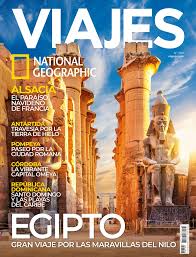 I've written about the Spanish version of National Geographic before. Isn't it an amazing publication? I've written about the Spanish version of National Geographic before. Isn't it an amazing publication?
I picked up the latest copy (no. 309) at the weekend because the portada proclaimed features about Alsace in France and Cordoba, here in Spain, both places I know and love.
Imagine my surprise when, on flicking through this high quality travel magazine, I discovered articles about Alava, Teruel, Cuenca, Picos de Europa, Vigo, Alcala de Henares, Tenerife, Andorra, and la Rioja.
[Courtesy of Viajes National Geographic]
There were also features on Vienna (Austria), Warsaw (Poland), Pompei (Italy), Dominican Republic, Egypt, and Antarctica.
And the magazine only cost 6 euros. Amazing!
Alsace
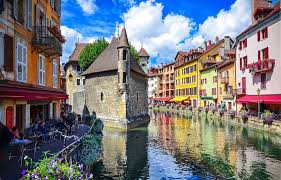 A beautiful region which has fluctuated between French and German control over the centuries. It's simply stunning! I've been a few times. Strasbourg is not to be missed. My most memorable visit was to Annecy around 1973 when we visited Trish, a fellow university student, and her French boyfriend, Guillaume. A beautiful region which has fluctuated between French and German control over the centuries. It's simply stunning! I've been a few times. Strasbourg is not to be missed. My most memorable visit was to Annecy around 1973 when we visited Trish, a fellow university student, and her French boyfriend, Guillaume.
Annecy, Alsace [Photo: Francia]
Cordoba
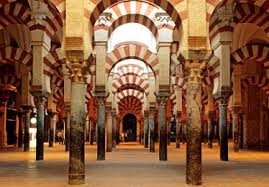 Until recently Cordoba was my favourite of the eight Andalusian capitals, but then I discovered Cadiz! Until recently Cordoba was my favourite of the eight Andalusian capitals, but then I discovered Cadiz!
Nevertheless, I've been to Cordoba a few times, each visit with a different female companion: my first wife, my subsequent girlfriend and my second, and current wife.
The Mezquita, the Alcazar and the Juderia are simply magnificent, unique, and magical.
[www.mezquitadecordoba.org]
Alava
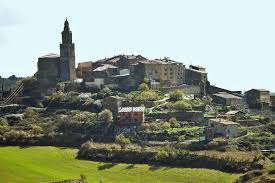 I've not been to this Basque town in Vitoria province, but it looks very impressive. I've not been to this Basque town in Vitoria province, but it looks very impressive.
We really must go.
Alava, Vitoria [Photo: viajero cronico]
Teruel
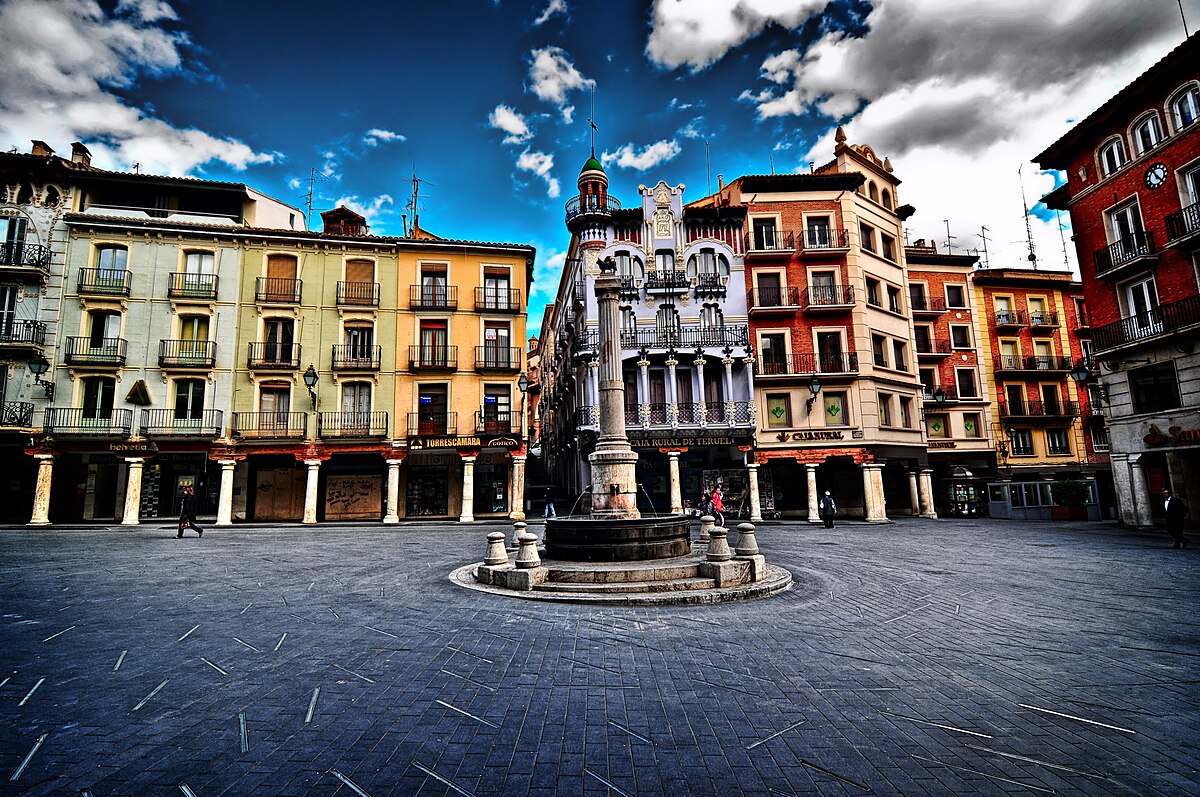 In Aragon, in the north-east of Spain. Despite its small population (36,000) it's the provincial capital. In Aragon, in the north-east of Spain. Despite its small population (36,000) it's the provincial capital.
I visited for half a day in 1998 with a girlfriend.
Charming - the town and the girlfriend!
Teruel [Wikipedia]
Cuenca
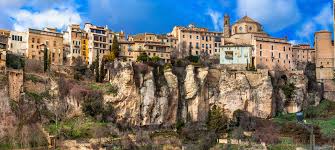 Ronda's twin town, it's a spectacular place, with two tajos (gorges), and the famous casas colgadas (hanging houses). Ronda's twin town, it's a spectacular place, with two tajos (gorges), and the famous casas colgadas (hanging houses).
Lots to see and do round about.
However, I still prefer Ronda.
Cuenca [Spain.info]
Picos de Europa
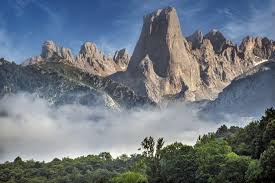 What a delightful area. I first discovered it when I led a school trip to Isla on the coast. What a delightful area. I first discovered it when I led a school trip to Isla on the coast.
Subsequently I returned several times, with family.
I love this natural paradise.
Easy to get to the capital, Santander, with Brittany Ferries from either Plymouth or Portsmouth.
[Photo: Escapada Rural]
Alcala de Henares
East of Madrid, it has the nearest parador to the capital, Madrid.
A pleasant provincial town with good bars and restaurants.
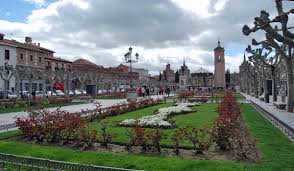 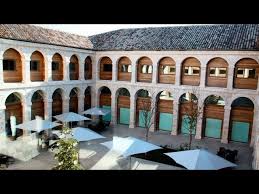
Alcala de Henares [Trip Advisor] Alcala Parador [Video: YouTube]
Tenerife
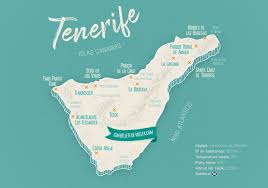 I've been to Tenerife a load of times. Guaranteed winter sun. I've been to Tenerife a load of times. Guaranteed winter sun.
I love the north of the island around Puerto de la Cruz and La Orotava.
Less keen on the touristy south, eg Playa de las Americas and Playa del Ingles.
[Map courtesy of Con Billete de Ida y Vuelta]
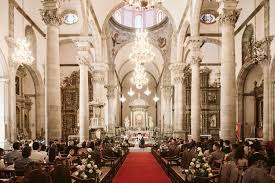 We were invited to a wedding on the island in 2005. Candy and Carlos were a young couple we met by chance at a picnic site and we hit it off straightaway. We were invited to a wedding on the island in 2005. Candy and Carlos were a young couple we met by chance at a picnic site and we hit it off straightaway.
They soon had a child, but sadly they divorced not long after they were married.
La Orotava wedding [Con Sonrisa de Beatriz]
Andorra
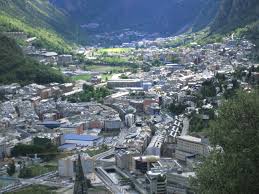 Jeryl and I visited there with our friends Mel and Hilary who were living in nearby Olot (Gerona). Jeryl and I visited there with our friends Mel and Hilary who were living in nearby Olot (Gerona).
I can't remember much about the visit.
Andorra [Wikipedia]
La Rioja
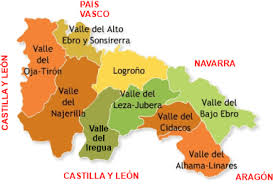 One of the most celebrated wine regions of Spain. We visited briefly many years ago. One of the most celebrated wine regions of Spain. We visited briefly many years ago.
Map of La Rioja [Pagina de Paco]
Vigo
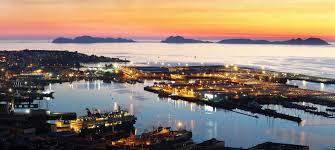 In Galicia. Not made it there yet but it's on my "bucket list" for 2026. In Galicia. Not made it there yet but it's on my "bucket list" for 2026.
Vigo [Spain.info]
Elsewhere
Vienna (Austria)
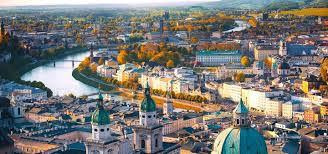 I visited the Austrian capital with my first wife Jeryl back in the 1980s. I visited the Austrian capital with my first wife Jeryl back in the 1980s.
We liked it. Spectacular architecture, including Baroque palaces and gardens, and the late-19th-century Ringstrasse, which is lined with grand buildings, monuments and parks.
[Photo of Vienna courtesy of Cheap Flights Club]
Vienna is renowned for its rich musical heritage, having been home to many celebrated classical composers, including Beethoven, Brahms, Bruckner, Haydn, Mahler, Mozart, Schoenberg, Schubert, Johann Strauss I, and Johann Strauss II.
The city also gave us the world's first psychoanalyst, Sigmund Freud.
Warsaw (Poland)
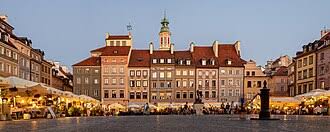 I've not been here yet, but it's on the list. I've not been here yet, but it's on the list.
When I get to Warsaw, maybe in 2026, I also fancy a trip to Pilzen, the home of beer style Pils, and Gdansk, formerly German Danzig.
Warsaw [Wikipedia]
Pompei (Italy)
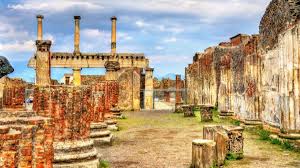 I've not been here either. I've not been here either.
In fact, I've never been to Italy. Isn't that ridiculous?
It's high time I went, isn't it?
[Photo: La Vanguardia]
Dominican Republic
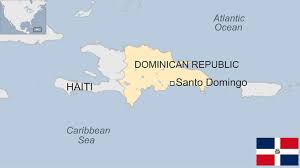 I've not been to this Caribbean country either, but I did enjoy a brief liaison with a lovely lady from that republic which occupies the eastern part of the island of Hispaniola. I've not been to this Caribbean country either, but I did enjoy a brief liaison with a lovely lady from that republic which occupies the eastern part of the island of Hispaniola.
She had emigrated to Spain with her daughter in search of a better life.
[BBC]
She was a great cook and ran a restaurant near Ronda for a time.
Then she moved away to the coast.
Egypt
 To my embarrassment I have never set foot in Africa, although Morocco has made it onto my "bucket list" for 2026. To my embarrassment I have never set foot in Africa, although Morocco has made it onto my "bucket list" for 2026.
Egypt looks absolutely amazing, but it's not a priority for me.
[Wikipedia]
Antarctica
 The closest I ever got to the home of the South Pole was South Australia. The closest I ever got to the home of the South Pole was South Australia.
Even in summer the ocean was freezing!
Antarctica [Photo: Live Science]
© The Spanish Fly (alias Paul Whitelock)
Photos and Images:
BBC, Cheap Flights Club, Con Billete de Ida y Vuelta, Con Sonrisa de Beatriz, Escapada Rural, Francia, La Vanguardia, Live Science, Pagina de Paco, Spain.info, Trip Advisor, viajero cronico, Viajes National Geographic, Wikipedia, YouTube
Acknowledgements:
Jeryl Whitelock Burgess, Maude Mary Jackson, Paul Whitelock, Rita Whitelock, The Spanish Fly, Viajes National Geographic, Wikipedia,
Tags:
Alava, Alcala de Henares, Alcazar, Alsace, Andorra, Annecy, Antarctica, BBC, Cheap Flights Club, Con Billete de Ida y Vuelta, Con Sonrisa de Beatriz, Cordoba, Cuenca, Dominican Republic, Egypt, Escapada Rural, Francia, Juderia, La Rioja, La Vanguardia, Live Science, Mezquita, Pagina de Paco, Picos de Europa, Pompei, Spain.info, Strasbourg, Tenerife, Teruel, The Spanish Fly, Trip Advisor, viajero cronico, Viajes National Geographic, Vienna, Vigo, Warsaw, Wikipedia, YouTube
Beethoven, Brahms, Bruckner, Haydn, Mahler, Mozart, Schoenberg, Schubert, Johann Strauss I, Johann Strauss II, Sigmund Freud.
 2
Like
Published at 6:03 PM Comments (0)
2
Like
Published at 6:03 PM Comments (0)
Southern Spain - Simply the Best!
Monday, November 3, 2025
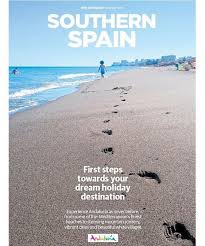 SUR in English has just produced a supplement about the attractions of Southern Spain. They plan to take it to The World Travel Market in London where they have a stand to promote Andalucia to a world-wide audience. It runs from 4-6 November, this coming week. SUR in English has just produced a supplement about the attractions of Southern Spain. They plan to take it to The World Travel Market in London where they have a stand to promote Andalucia to a world-wide audience. It runs from 4-6 November, this coming week.
The supplement is excellent with great writing from SUR in English journalists including Anya Soares, Daryl Finch, Javier Amellones, Jennie Rhodes, Pilar Martinez and Tony Bryant.
[SUR in English]
I know every place they covered and have written about many of them myself, albeit from a different perspective. The articles in the supplement are well-researched and make interesting reading.
Let's take a look
Going in the order of the supplement, here are some of the highlights:
Andalucia
 Daryl Finch has written a great introduction to Andalucia. Daryl Finch has written a great introduction to Andalucia.
He covers Malaga, Sevilla, Cordoba, Granada, Cadiz, Huelva, Jaen and Almeria.
A prolific writer and fluent Spanish-speaker, he does these places proud.
[SUR in English]
Links to other articles:
ANDALUCIA’s 3 C’s: Cádiz, Córdoba, Ciudad Soñada - Help me, Ronda
CADIZ - Help me, Ronda
El diario británico 'The Sun' recomienda visitar Cádiz por su gastronomía y su "ambiente diferente"
In Love with SEVILLA - at last! - Help me, Ronda
MALAGA CITY - Help me, Ronda
Unsung cities: Cadiz - a light less ordinary | City breaks | The Guardian
ZAHARA DE LOS ATUNES, CAÑOS DE MECA, TRAFALGAR and BARBATE - Help me, Ronda
I've been to Huelva and Almeria also but didn't write about either place. I did write about Granada, but cannot find the article! Doh!
Western Costa del Sol
 Tony Bryant covers Torremolinos, Fuengirola, Mijas, Benalmadena, Puerto Banus, Marbella, Estepona, and Manilva. Tony Bryant covers Torremolinos, Fuengirola, Mijas, Benalmadena, Puerto Banus, Marbella, Estepona, and Manilva.
He lives in the area and is a regular columnist for SUR in English.
[SUR in English]
Link to another article:
OUR DAY OUT - on the Costa del Sol - Help me, Ronda
Malaga
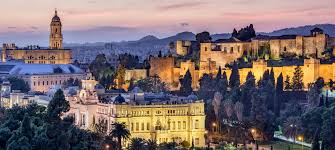 Málaga City is a revelation! OK, there are lots of roadworks and building sites in the centre of the city, which are a bit of a nuisance. Málaga City is a revelation! OK, there are lots of roadworks and building sites in the centre of the city, which are a bit of a nuisance.
But they will no doubt turn out to be a good thing in the longer term.
Malaga city [Spain.info]
Link:
MALAGA CITY - Help me, Ronda
La Axarquia
 An excellent piece by Jennie Rhodes, who lives in the Axarquia. An excellent piece by Jennie Rhodes, who lives in the Axarquia.
Earlier this year I went on a Press Tour of the area, which had been co-ordinated by Jennie in conjunction with the local Tourist Board.
Jennie is a fluent Spanish-speaker with an honours degree from Leeds University.
[SUR in English]
Links to my articles:
Axarquia Press Trip - Eye on Spain
NERJA - A LITTLE GEM - Help me, Ronda
Costa del Golf
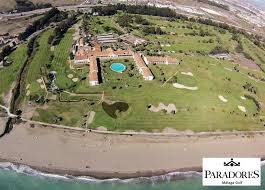 Golf is big on the Costa del Sol. Golf is big on the Costa del Sol.
I don't play, but I have been to a few golf courses as a member of the Press.
I've also enjoyed a coffee at the Parador del Golf.
[andalucia.org]
Costa de Almeria
Almeria offers unique beaches, rich heritage, vibrant culture, unspoilt nature and first-class gastronomy that awakens the senses and creates unforgettable experiences.
I was there over forty years ago. We had a great time but there is no written record of our visit. Back then there was no internet, and anything I may have written has disappeared into ..... no idea!
 The article in the supplement about Cabo de Gata by Anya Soares makes fascinating reading. The article in the supplement about Cabo de Gata by Anya Soares makes fascinating reading.
Anya is doing a placement with SUR in English as part of her degree course in journalism.
As a consequence of Anya's article a visit to Cabo de Gata is on my "bucket list" for 2026.
[SUR in English]
Mijas
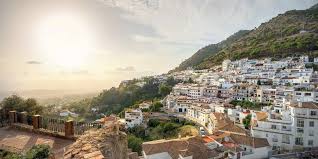 There is Mijas Pueblo up in the hills and Mijas Costa or Cala de Mijas down on the coast. Both are great, but in different ways. There is Mijas Pueblo up in the hills and Mijas Costa or Cala de Mijas down on the coast. Both are great, but in different ways.
Mijas Pueblo is enchanting, despite being full of "guiris" and being very expensive to eat, shop and buy property.
Mijas Pueblo [Visita Costa del Sol]
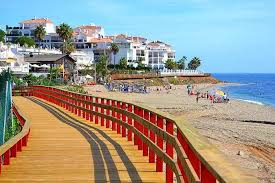 Mijas Costa is one of my favourite beaches on the Costa del Sol. Also full of "guiris" - residents and tourists - it's also a working town. And you don't have to talk to the foreigners, do you? Mijas Costa is one of my favourite beaches on the Costa del Sol. Also full of "guiris" - residents and tourists - it's also a working town. And you don't have to talk to the foreigners, do you?
The beach is splendid, lots of yellow sand, easy swimming and a great coastal path.
There's a great shopping centre just inland, if you're that way inclined.
Mijas Costa [Hoteles.net]
Unspoilt beaches, dunes and diving on the eastern Costas
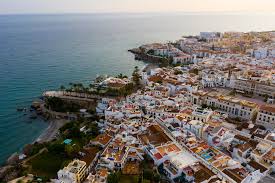 Jennie Rhodes has put together an excellent piece about eastern Malaga and the Costa Tropical (Granada). Jennie Rhodes has put together an excellent piece about eastern Malaga and the Costa Tropical (Granada).
Her article takes in Rincon de la Victoria, Torre del Mar, Torrox, and Nerja, before crossing the border into Granada province and La Herradura, and Almuñecar.
Aerial view of Nerja [La Sexta]
BIRTHDAY OUTING TO FRIGILIANA - Help me, Ronda
NERJA - A LITTLE GEM - Help me, Ronda
Granada
Granada is a spectacular city. The Alhambra is stunning and just down the hill the Casco Antiguo is a delight.
To the north are snow-capped mountains and if you look south you can see the sun-drenched coast and the Costa Tropical.
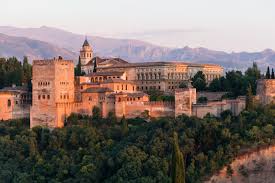 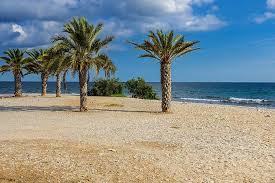
The Alhambra [Wikipedia] Costa Tropical [Granada Spain]
Head Inland for fun and adventure in Malaga province
 Jennie Rhodes writes about a maze in Humilladero ..... Jennie Rhodes writes about a maze in Humilladero .....
olive oil in LA Almazara in Ronda .....
and a zip-wire experience at Sunview Park in Alhaurin de la Torre.
LA Almazara, Ronda [Areall]
Malaga, a cycling paradise
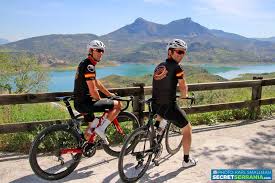 This excellent article is unattributed, yet it describes fantastic cycling routes which I have only travelled by car. This excellent article is unattributed, yet it describes fantastic cycling routes which I have only travelled by car.
There are routes in the Serrania de Ronda and in other inland locations.
Overlooking Zahara reservoir [Secret Serrania]
Malaga's cave art
Malaga province has some twelve caves. I have visited a few: Nerja, Cueva de la Pileta (Benaojan), Cueva del Gato (Benaojan), Cueva del Hundidero (Montejaque) and Ardales.
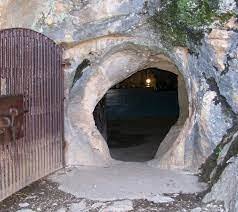 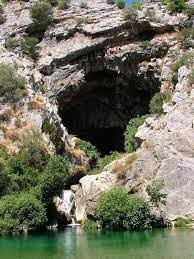 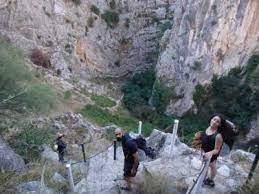
Cueva de la Pileta Cueva del Gato Cueva del Hundidero
[Above photos by Paul Whitelock]
Remote business and digital nomads
 Daryl Finch and Pilar Martinez inform us that between 11 and 12 per cent of passengers arriving at Malaga airport now travel for work-related reasons. Daryl Finch and Pilar Martinez inform us that between 11 and 12 per cent of passengers arriving at Malaga airport now travel for work-related reasons.
Many are digital nomads who have a special visa.
[Photo: Iberdrola]
A gateway to the world
 This article by Daryl Finch is about the expansion of the airport, which is already the third busiest in Spain after Madrid and El Prat de Llobregat (Barcelona). This article by Daryl Finch is about the expansion of the airport, which is already the third busiest in Spain after Madrid and El Prat de Llobregat (Barcelona).
[The Olive Press]
The End
© The Spanish Fly (Paul Whitelock)
Pix:
Areall, Granada Spain, Hoteles.net, Iberdrola, La Sexta, SUR in English, Paul Whitelock, Secret Serrania, Spain.info, The Olive Press, Visita Costa del Sol, Wikipedia
Thanks:
Costa Press Club, Jennie Rhodes, Paul Whitelock, The Spanish Fly, Wikipedia
Tags:
4-6 November, advertorial, Alhaurin de la Torre, Almeria, Almuñecar, Andalucia, Anya Soares, Ardales, Axarquia, Barcelona, Benalmadena, Benaojan, "bucket list", Cabo de Gata, Cadiz, cave art, Cordoba, Costa de Almeria, Costa del Golf, Costa del Sol, Costa Tropical, Cueva de la Pileta, Cueva del Hundidero, Daryl Finch, digital nomad, eastern Malaga, El Prat de Llobregat, Estepona, expansion of the airport, Fuengirola, Gibraltar, golf, Granada, Hiking in the Ronda Mountains, Hoteles.net, Huelva, Humilladero, Jaen, Javier Almellones, Jennie Rhodes, La Herradura, LA Almazara, London, Madrid, Malaga, Malaga-based bank, Manilva, Marbella, maze, Mijas, Montejaque, Nerja, olive oil, Parador del Golf, Paul Whitelock, Pilar Martinez, Puerto Banus, Rincon de la Victoria, Ronda, Sevilla, Spain, Sunview Park, SUR in English, The Olive Press, The Spanish Fly, third busiest airport, Tony Bryant, Torre del Mar, Torremolinos, Torrox, Unicaja, Visita Costa del Sol, Wikipedia, World Travel Market, zip-wire
 1
Like
Published at 8:30 PM Comments (0)
1
Like
Published at 8:30 PM Comments (0)
I knew it! San Sebastian is Numero 1!
Sunday, November 2, 2025
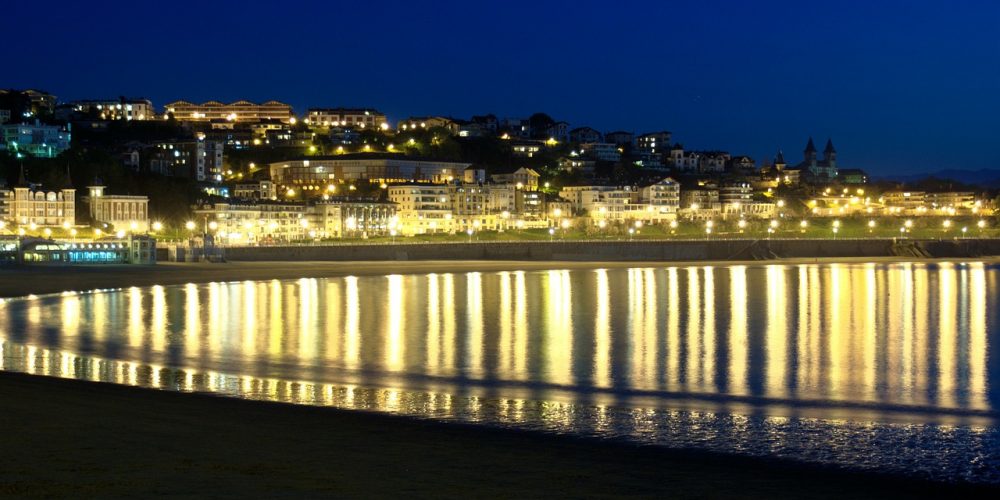 I love San Sebastian (Gipuzkoa)! The moment I arrived there at Easter 1971, late at night, aged just 20, I was hooked. Forget the Day 2 hangover - the worst of my life - I decided Spain was for me. I love San Sebastian (Gipuzkoa)! The moment I arrived there at Easter 1971, late at night, aged just 20, I was hooked. Forget the Day 2 hangover - the worst of my life - I decided Spain was for me.
San Sebastian by night [Photo: unattributed]
I spent six months there. I was studying Spanish at university and San Seb was where we were sent as an obligatory part of the degree course. I also got six months in Germany, as I was also studying German. But that's for another day.
San Sebastian - My Story
 I returned to Donostia (the name in euskera - Basque - that the city is now officially known by) for three more summers. I loved it! I returned to Donostia (the name in euskera - Basque - that the city is now officially known by) for three more summers. I loved it!
And I vowed to myself that one day I would emigrate to Spain to live. I eventually managed that 38 years later, but I chose Ronda (Malaga) not SanSe.
Bay of La Concha, San Sebastian [Spain.info]
There are many reasons for that choice, which I shan't list here, but I still have a soft spot for San Sebastian.
And now the international Press has declared that this Spanish city is the most perfect in the world.
I feel vindicated. I discovered it first!
La prensa internacional se rinde a esta ciudad española: "Es la más perfecta del mundo"
 As reported in the Spanish daily La Razón, Spain is the second most-visited country in the world after France. As reported in the Spanish daily La Razón, Spain is the second most-visited country in the world after France.
Yet, if you take out the visitors who flock to Disneyland Paris, Spain leaps into first place in the whole of the world.
Their reporter, known just as Nora, reports that:
Apart from a country's history, monuments, and so on, the truth is that its towns and cities are what count. That is why even the international press considers one Spanish city to be "the most perfect in the world," demonstrating its huge admiration for Spain and her islands.
[Kiosko.net]
From La Concha Beach to unbeatable cuisine: the international press highlights San Sebastián as 'the jewel of Spain and the world'.
Eddi Fiegel, a British journalist specializing in art, music, cinema, gastronomy, and of course, travel, considered it 'the perfect city' in an article in The Telegraph published in early 2025.
Rating a series of European cities she has visited, she gave San Sebastián a ten out of ten, the maximum score.
"This jewel of the Basque Country was one of the favorite vacation destinations of the Spanish royalty at the beginning of the 20th century, partly because of its large sandy beaches, its cool sea breezes, and its Belle Époque architecture, but above all because of its beauty," highlighted the journalist, citing as an example that "during the First World War, Maurice Ravel, Leon Trotsky, and Mata Hari visited San Sebastian; nowadays, it is film stars who go there."
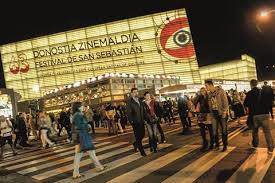 "Especially during the San Sebastian annual film festival," adds Eddi. But she also highlights the city's gastronomy, which she describes as 'unbeatable.' "Especially during the San Sebastian annual film festival," adds Eddi. But she also highlights the city's gastronomy, which she describes as 'unbeatable.'
"San Seb has one of the highest concentrations of Michelin-starred restaurants and top-notch pintxo bars in Spain."
[Screen Daily]
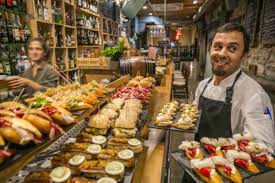 The U.S. travel website "Islands" also begins by talking about its gastronomy, highlighting that it is "a paradise, home to the most famous cheesecake in the world and twenty Michelin stars." The U.S. travel website "Islands" also begins by talking about its gastronomy, highlighting that it is "a paradise, home to the most famous cheesecake in the world and twenty Michelin stars."
The website highlights the important culinary culture of San Sebastián, which "is not limited to high-end restaurants, but is also home to pintxos."
"Chefs in this city are always trying to outdo each other, but the classics are unbeatable."
[EL PAIS]
In another article from the same publication, journalist Rick Steves described San Sebastián as "the coastal city with the most beautiful golden sand beach in Europe."
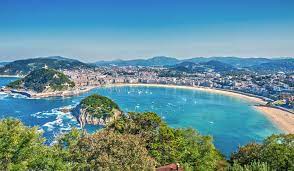 "It enjoys a privileged location with a golden beach flanked by two peaks and a charming little island off the coast." "It enjoys a privileged location with a golden beach flanked by two peaks and a charming little island off the coast."
The Playa de La Concha received the TripAdvisor Travelers' Choice award for Best Beach in 2024.
[Civitatis]
Final thought
I haven't been to San Sebastian for years. High time I checked it out again! Maybe next year .....
© The Spanish Fly (Paul Whitelock)
Piccies:
Civitatis, EL PAIS, Kiosko.net, Screen Daily, Spain.info,
Thanks:
Google Translate, La Razon, Paul Whitelock, The Spanish Fly, Wikipedia
,
Tags:
arquitectura Belle époque, Basque, Civitatis, Donostia, Eddi Fiegel, EL PAIS, euskera, Google Translate, Kiosko.net, La Razon, León Trotsky, Mata Hari, Maurice Ravel, Michelin, País Vasco, Paul Whitelock, pintxos, Playa de la Concha, Rick Steve, Screen Daily, Spain.info, The Spanish Fly, The Telegraph, Travelers' Choice, TripAdvisor,
 3
Like
Published at 5:05 PM Comments (0)
3
Like
Published at 5:05 PM Comments (0)
El Valle del Genal - La Serrania de Ronda
Sunday, October 19, 2025
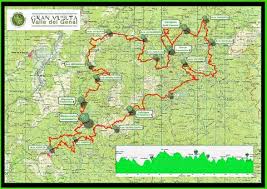 I haven't done this trip for a few years, so I was looking forward to our excursion last Friday. Starting from home in Ronda we headed for the start of the Genal Valley, which begins with the pretty "Enchanted Forest" (El Bosque Encantado) in Parauta. I haven't done this trip for a few years, so I was looking forward to our excursion last Friday. Starting from home in Ronda we headed for the start of the Genal Valley, which begins with the pretty "Enchanted Forest" (El Bosque Encantado) in Parauta.
Genal Valley map [Ayuntamiento de Juzcar]
We then continued on to Cartajima, the Village of Murals (Pueblo de Murales); to the Smurfs' village of Juzcar, mostly still painted blue; past Farajan; and on to Alpandeire, which celebrates Fray Leopoldo, a recently created saint. Alpandeire was our lunch destination. After a leisurely lunch it was back to Ronda on the Algeciras Road. A total of 86 kilometres.
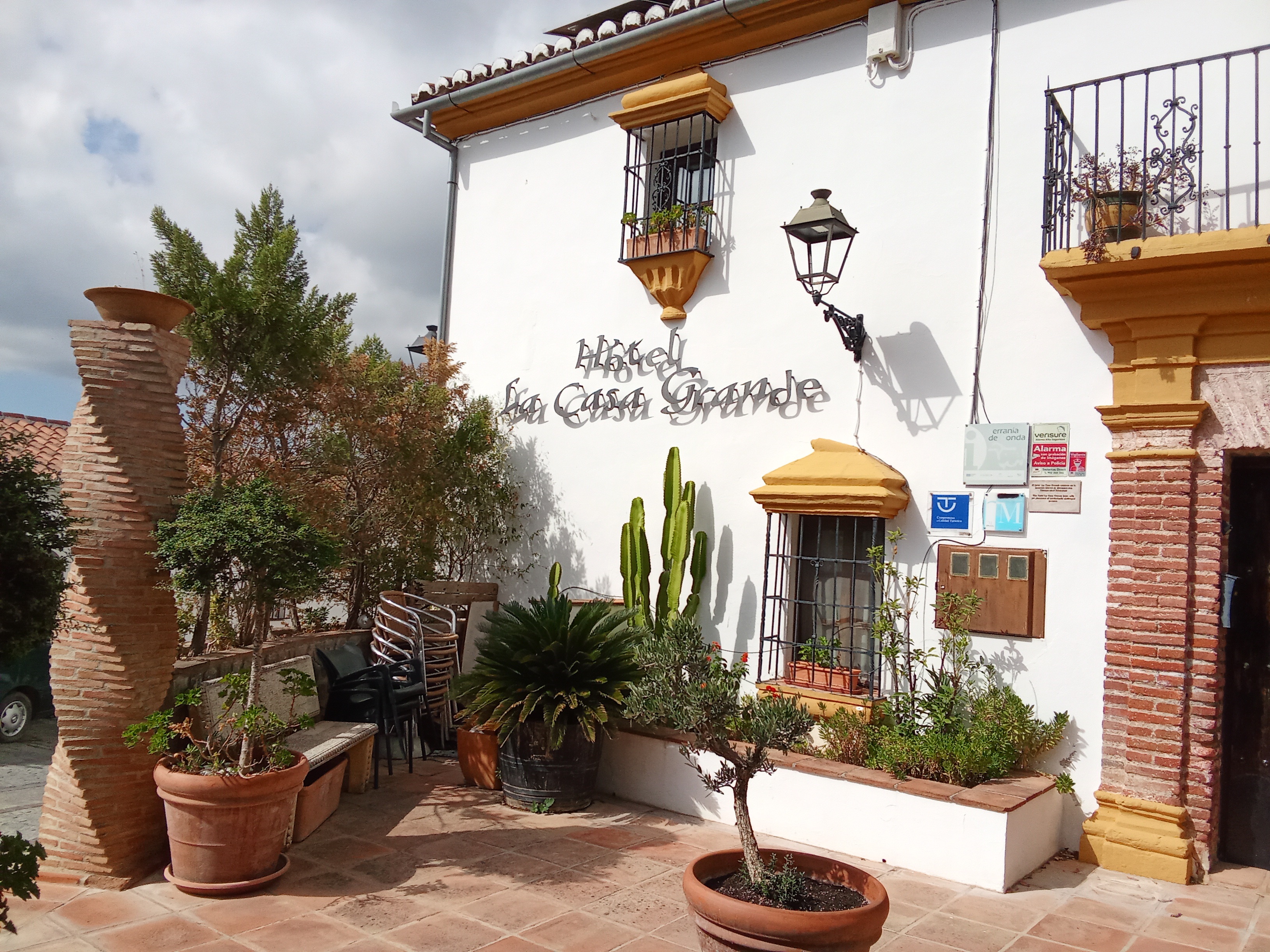 The idea for the trip came about when our Maltese friends, John and Lorraine, owners of a house in Montejaque, invited us to join them for lunch at La Casa Grande in Alpandeire. I'd eaten there some years previously and remembered it being very good. For Rita it was to be a new experience. The idea for the trip came about when our Maltese friends, John and Lorraine, owners of a house in Montejaque, invited us to join them for lunch at La Casa Grande in Alpandeire. I'd eaten there some years previously and remembered it being very good. For Rita it was to be a new experience.
Hotel La Casa Grande [Photo: Paul Whitelock]
Parauta
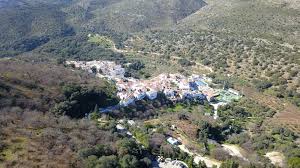 I always liked Parauta. I went there with Maude, a girlfriend, some 20 years ago and we nearly bought a place in the centre of the village. I always liked Parauta. I went there with Maude, a girlfriend, some 20 years ago and we nearly bought a place in the centre of the village.
Now it has all changed. Vehicles are no longer allowed into the village and this ban is enforced with GPS technology.
Parauta [Photo: Wikipedia]
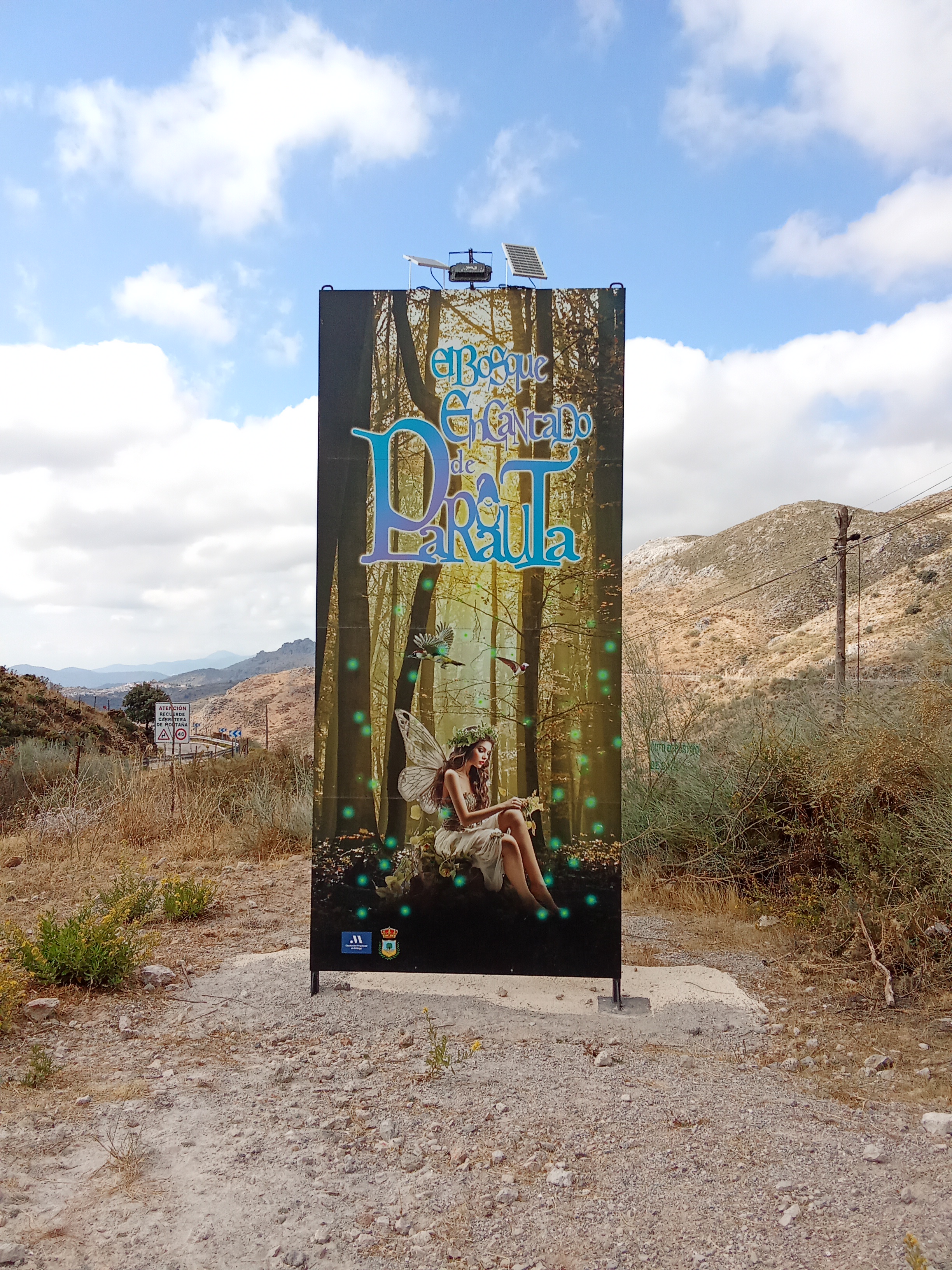 Parauta has invested heavily in a major upgrade in an attempt to halt population decline. Parauta has invested heavily in a major upgrade in an attempt to halt population decline.
It is now the Enchanted Village, with a visitor attraction, guided walks and other activities.
The aim is to attract more visitors and to provide employment for young people who are leaving the village in droves in search of work.
[Paul Whitelock]
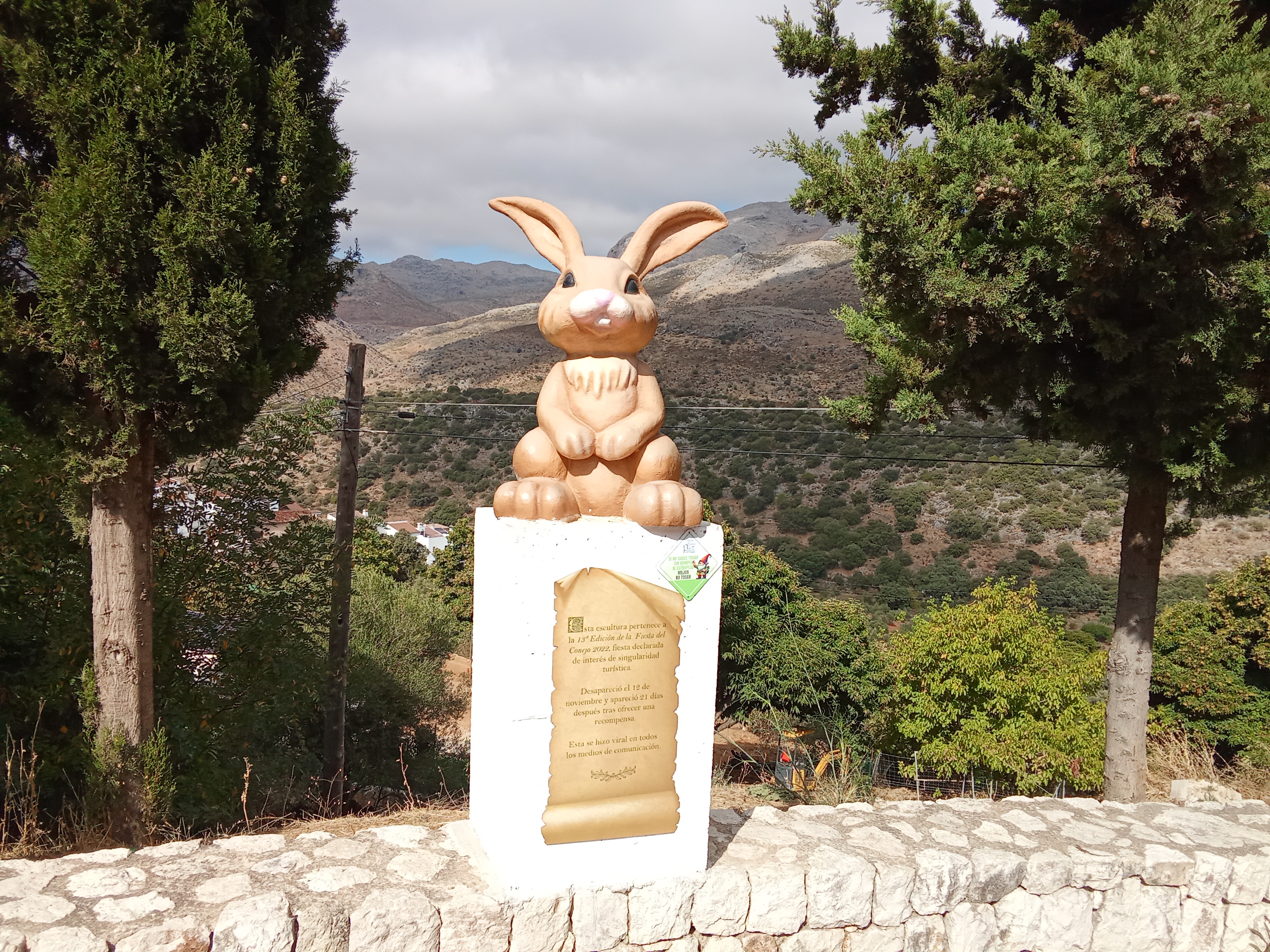 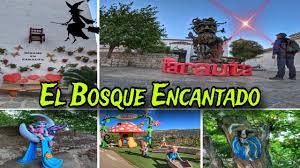
[YouTube] [Paul Whitelock]
Cartajima
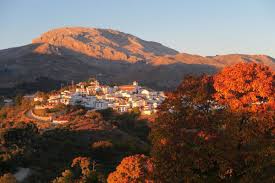 "El Pueblo de Las Murales", as it is known nowadays. "El Pueblo de Las Murales", as it is known nowadays.
Cartajima has become famous in the last few years for its many murals painted on walls, gable ends, buildings and other surfaces.
As with Parauta, this is part of a strategy to attract more tourism to the village and to halt population decline.
Cartajima at sunset [Photo: Europa Press]
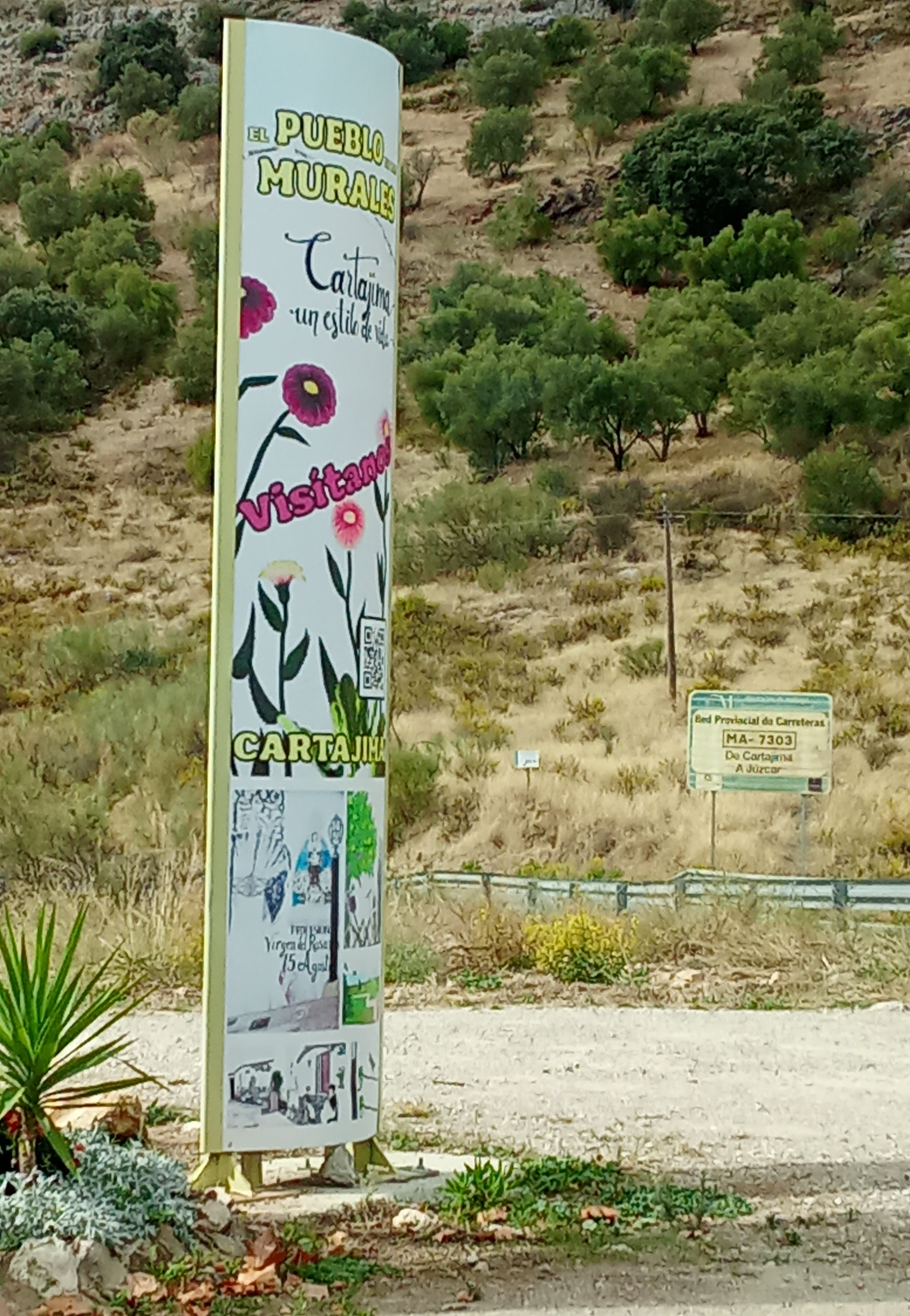 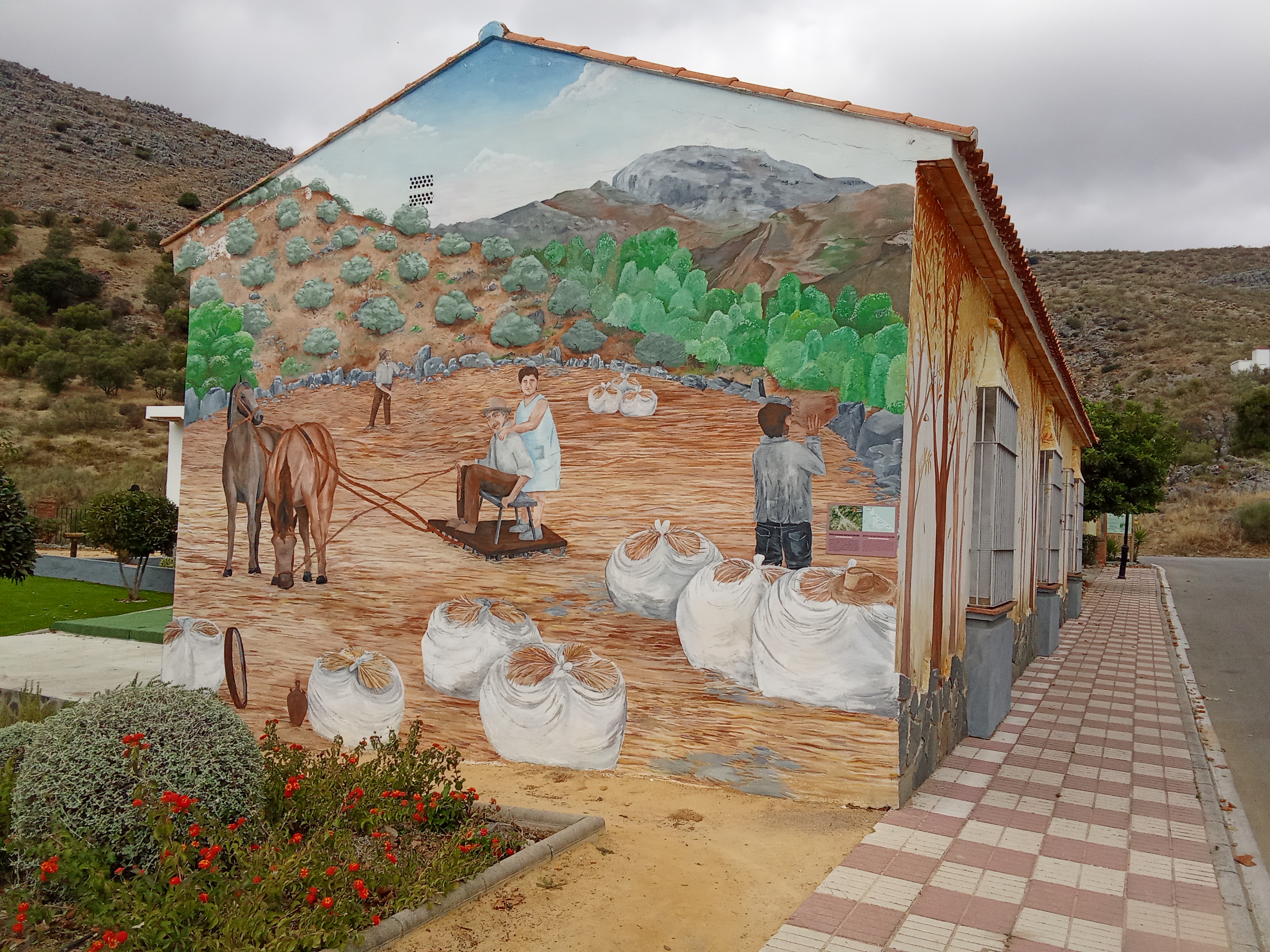
[Photos of Cartajima by Paul Whitelock]
Juzcar
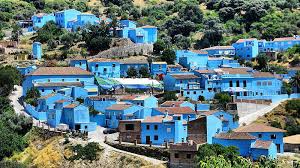
Famous since 2016 as "El Pueblo Azul" or "El Pueblo Pitufo" ("The Smurfs Village"), Juzcar arrived with a bang on the tourist map and money has poured in from the pockets of visitors keen to see where the Smurfs movie was filmed by Walt Disney Enterprises of Hollywood.
Juzcar [Photo: Rustica Estates]
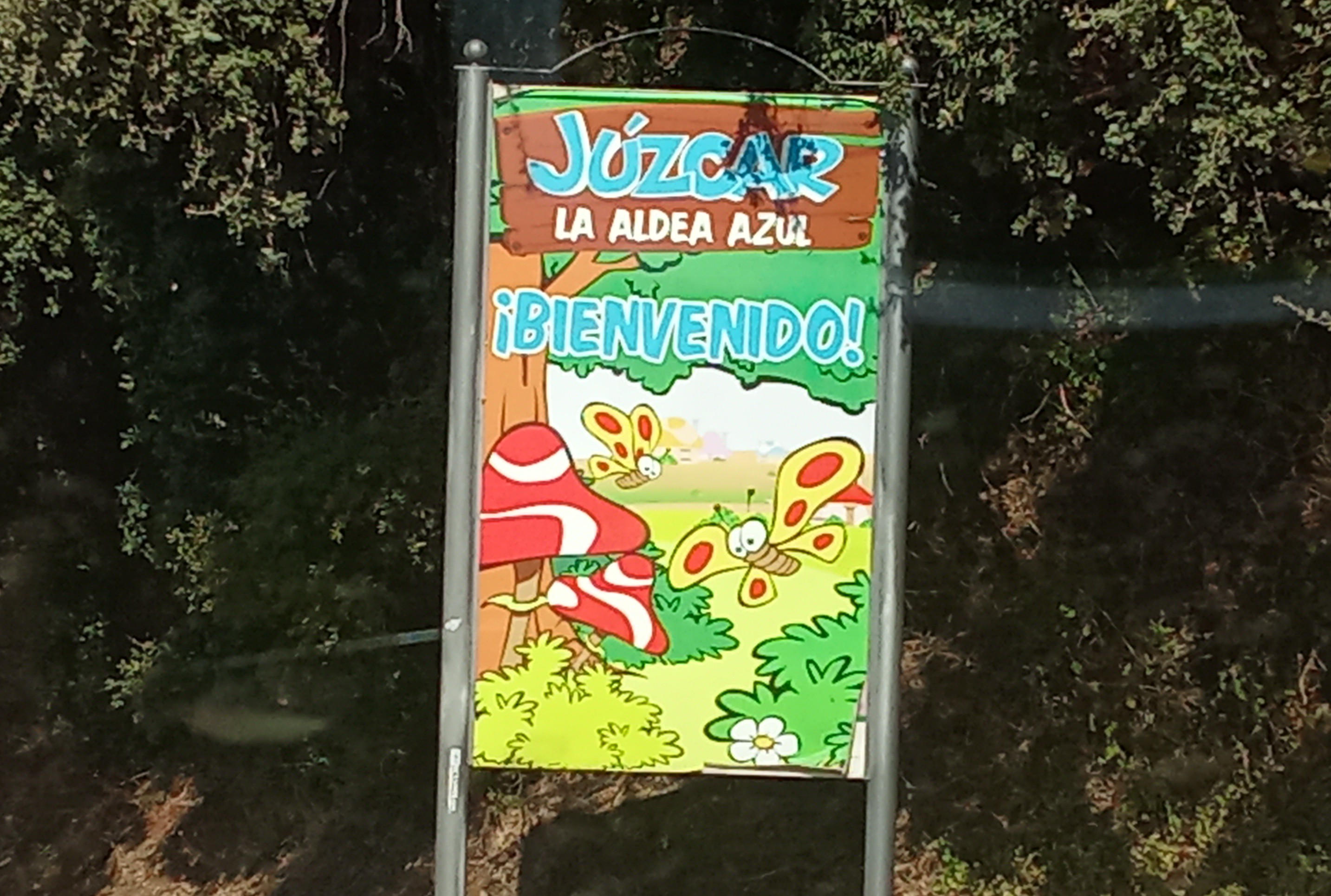 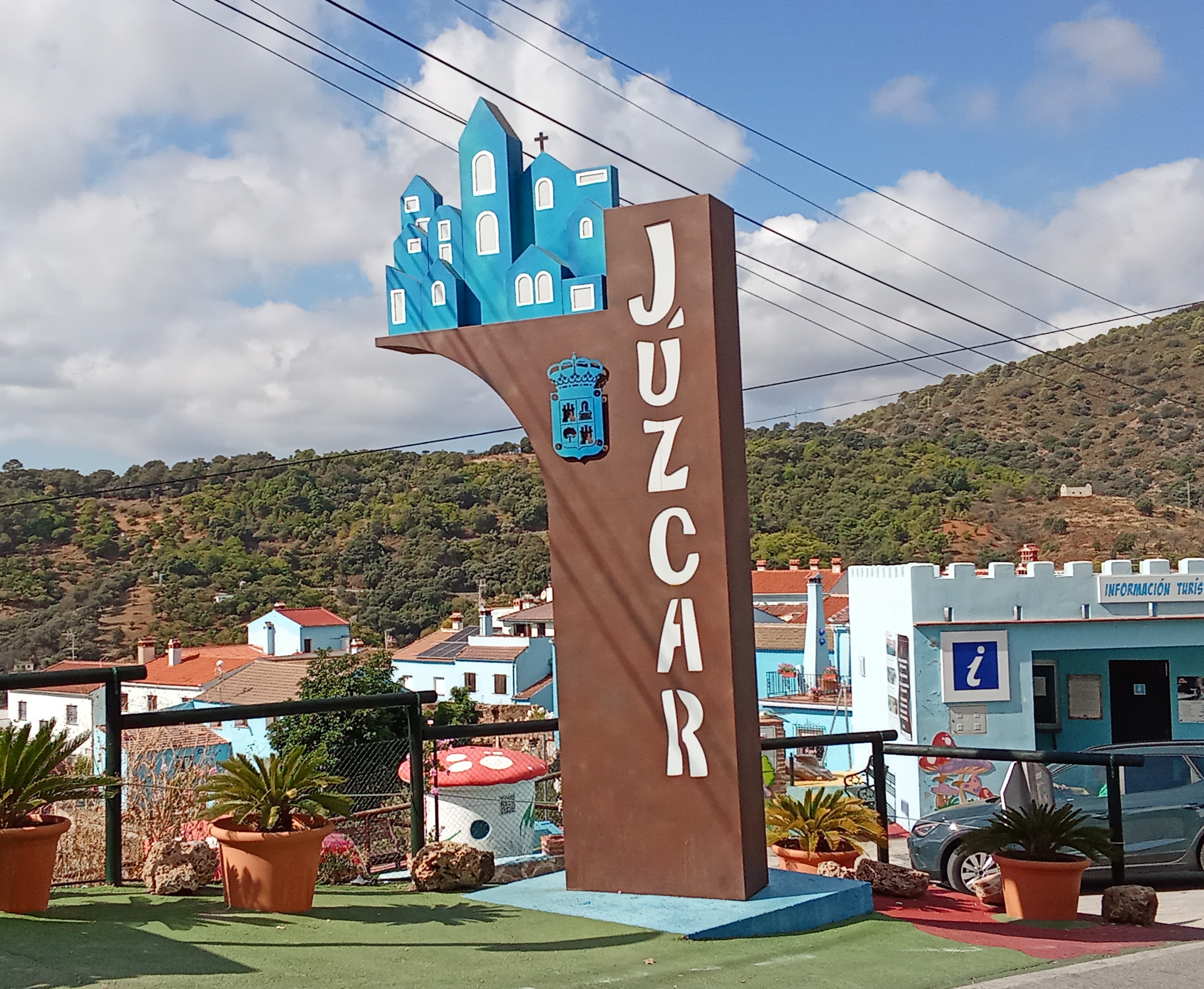
Signs as you enter the village
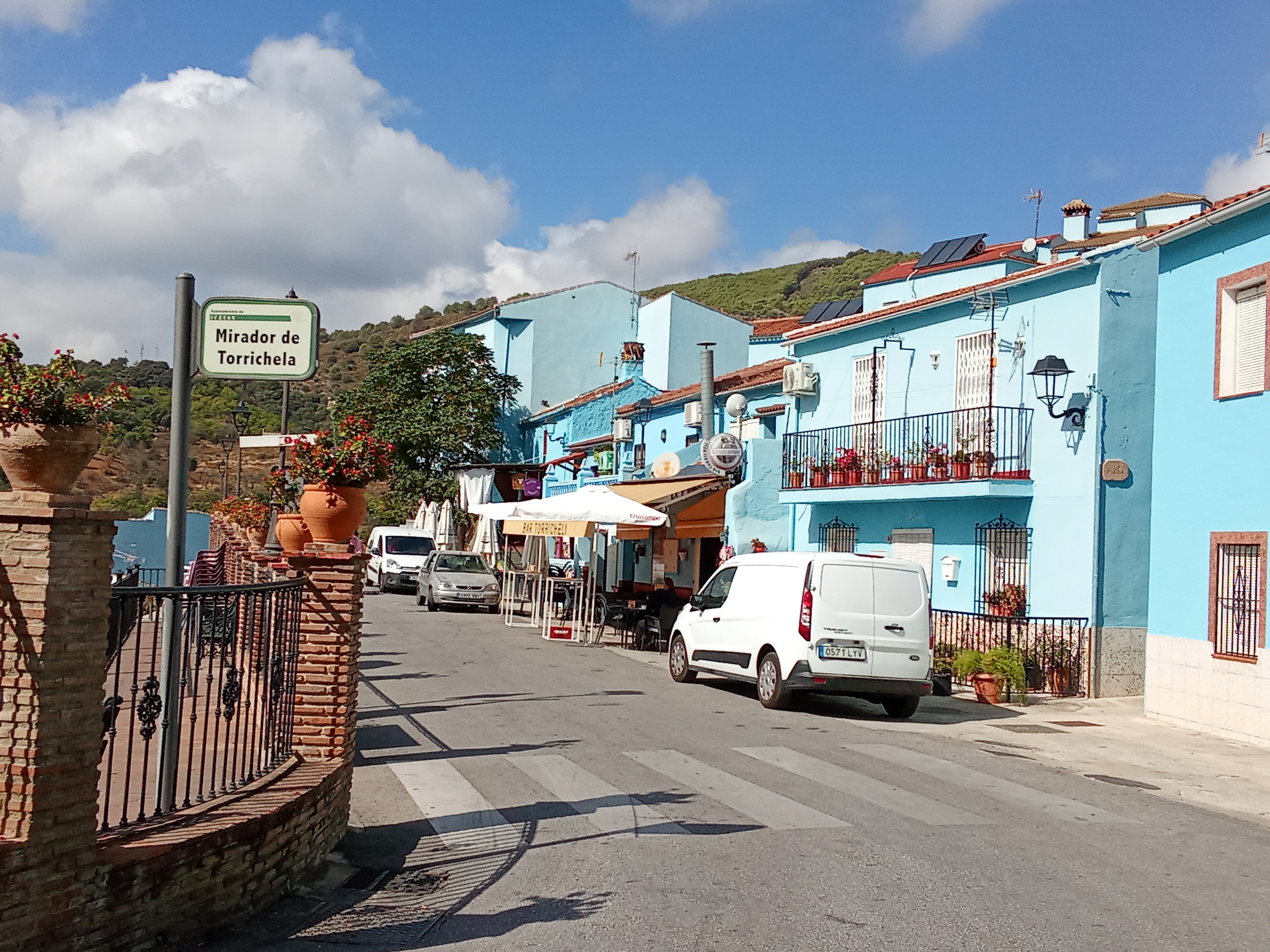 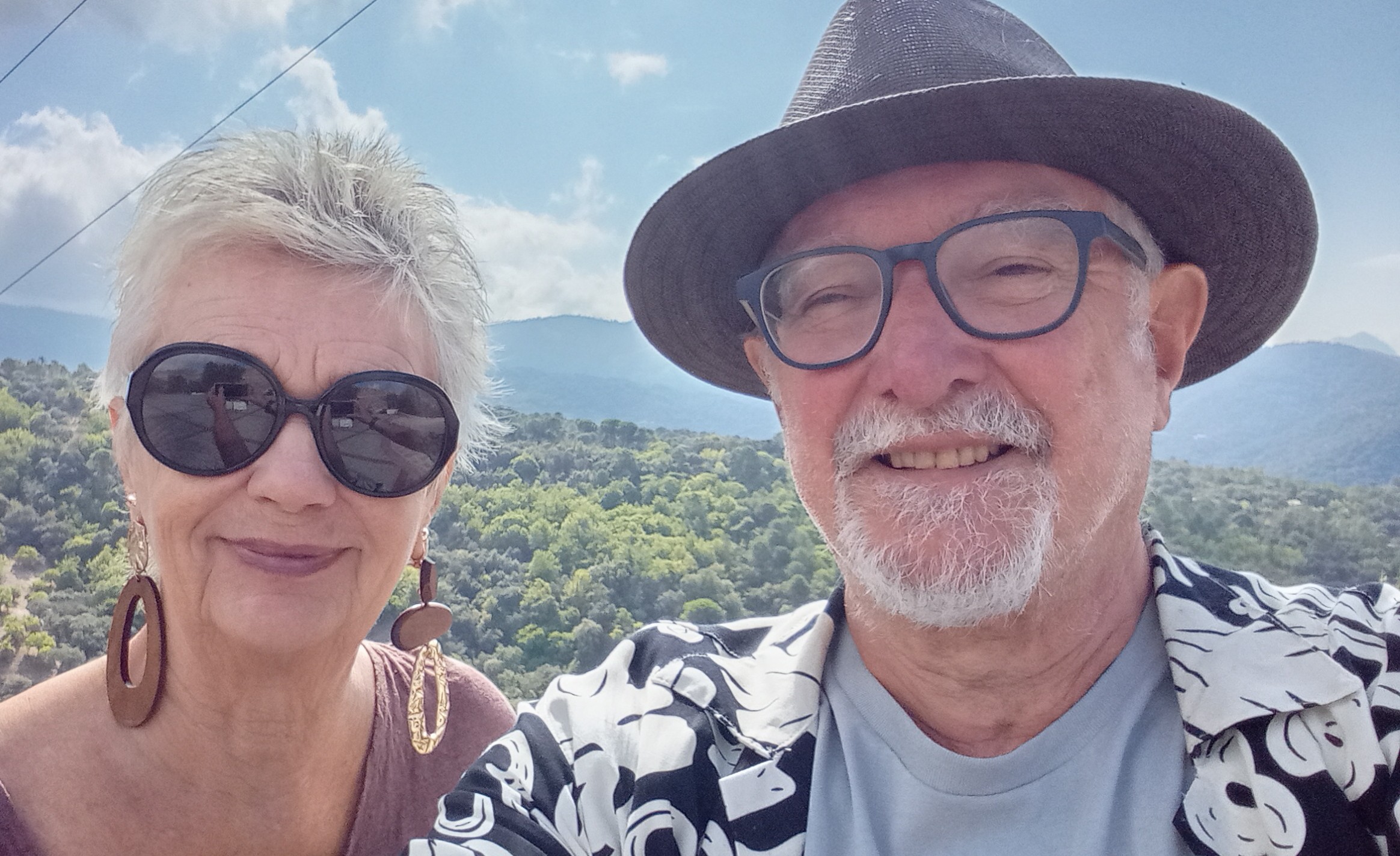
Juzcar village centre Rita and Paul (selfie)
[All above photos by Paul Whitelock]
Farajan
The name of the village, Farajan, comes from the Arabic language and means "pleasant location".
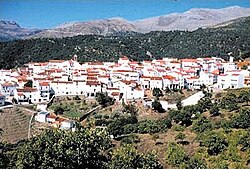 It is without doubt a most apt denomination as its geographical position at the head of the River Genal gives it a singular charm. It is without doubt a most apt denomination as its geographical position at the head of the River Genal gives it a singular charm.
Farajan is situated among deep ravines traversed by streams flowing into the River Genal, the dominant feature in the area.
It is small in size and has a populaation of just 284 (INE 2024). At 645 metres above sea level, it has stunning views all around.
On this occasion, we did not linger long, but it is definitely worth a visit.
Farajan from afar [Photo: Wikipedia]
Alpandeire
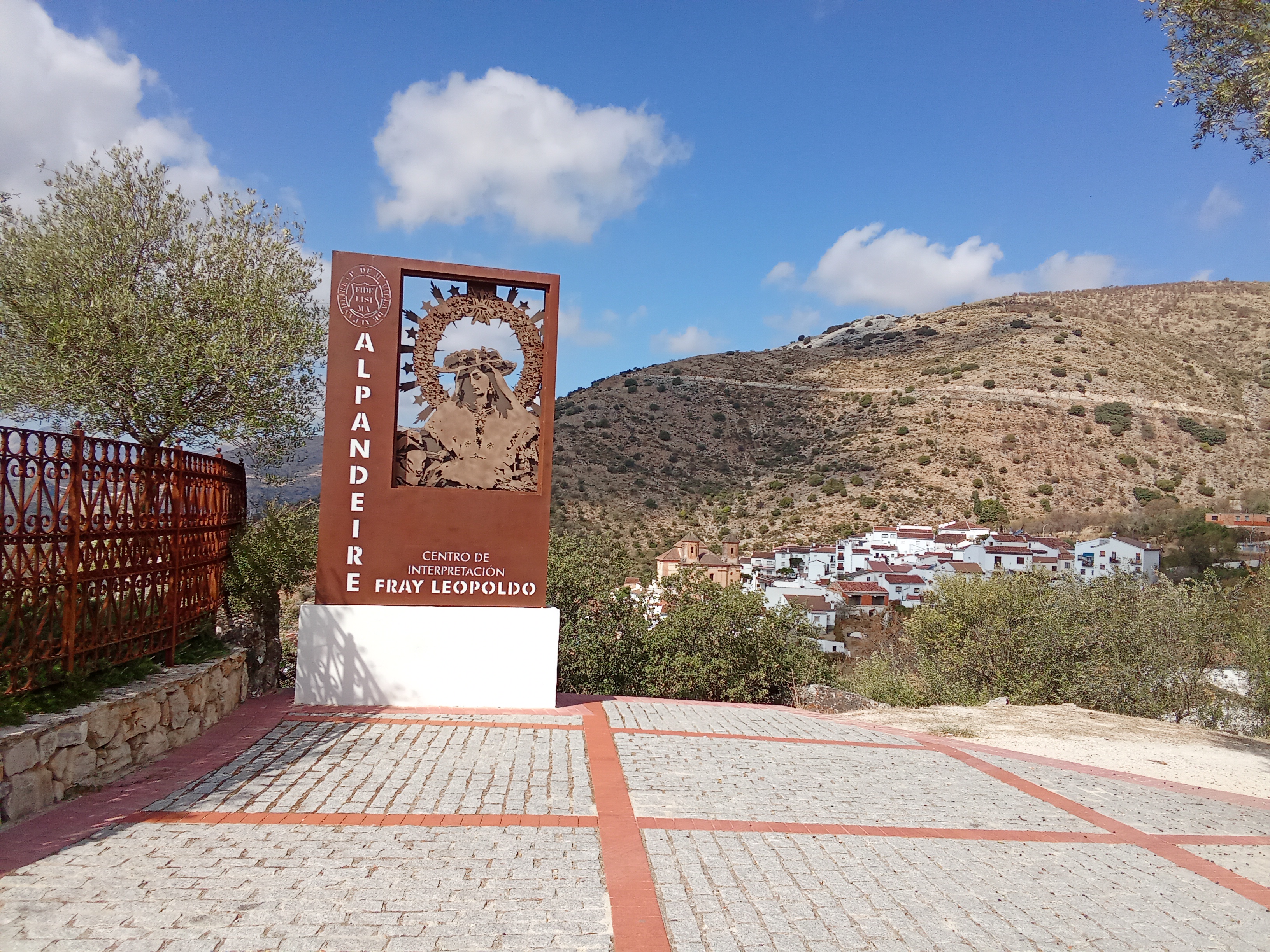 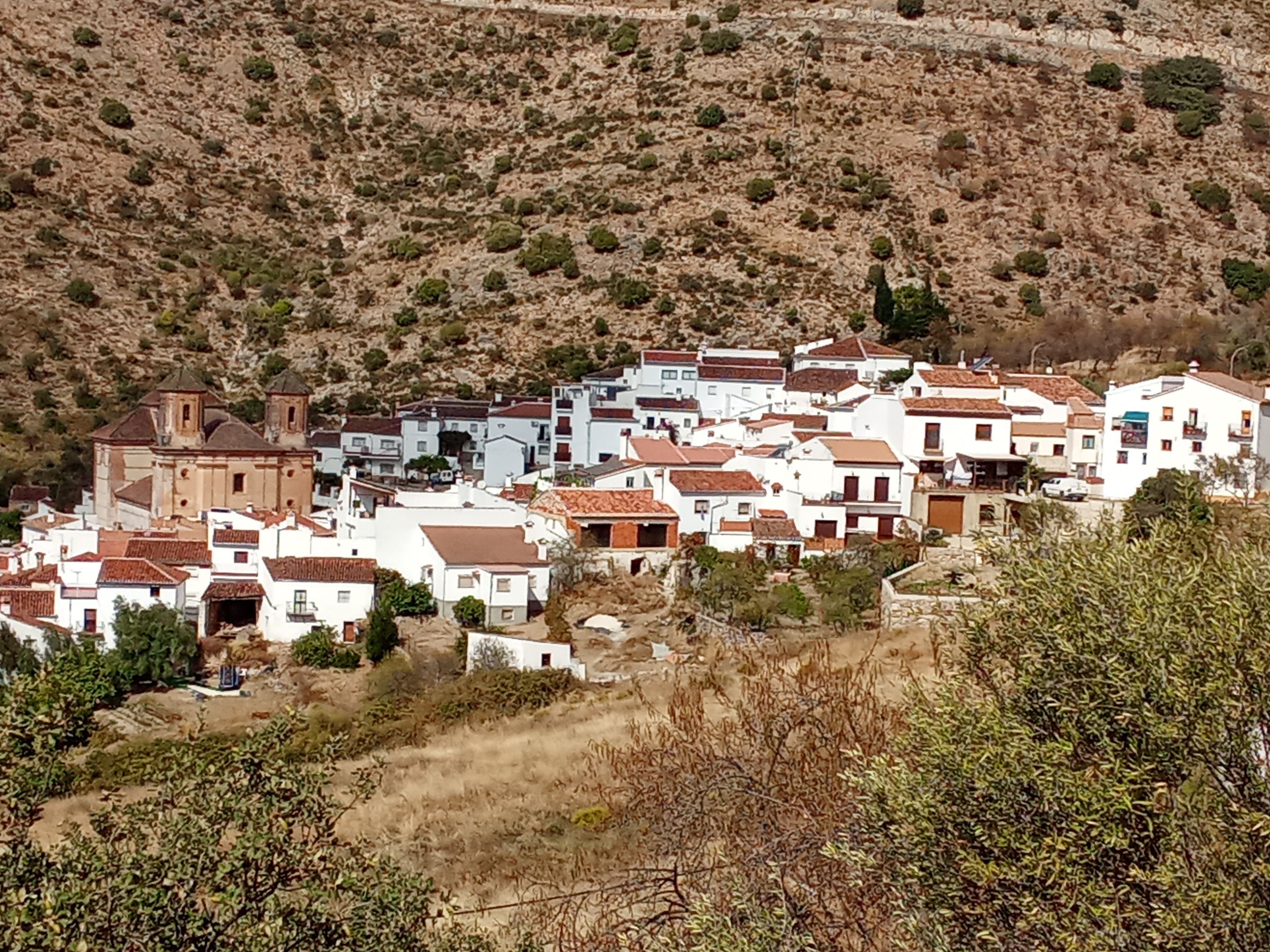
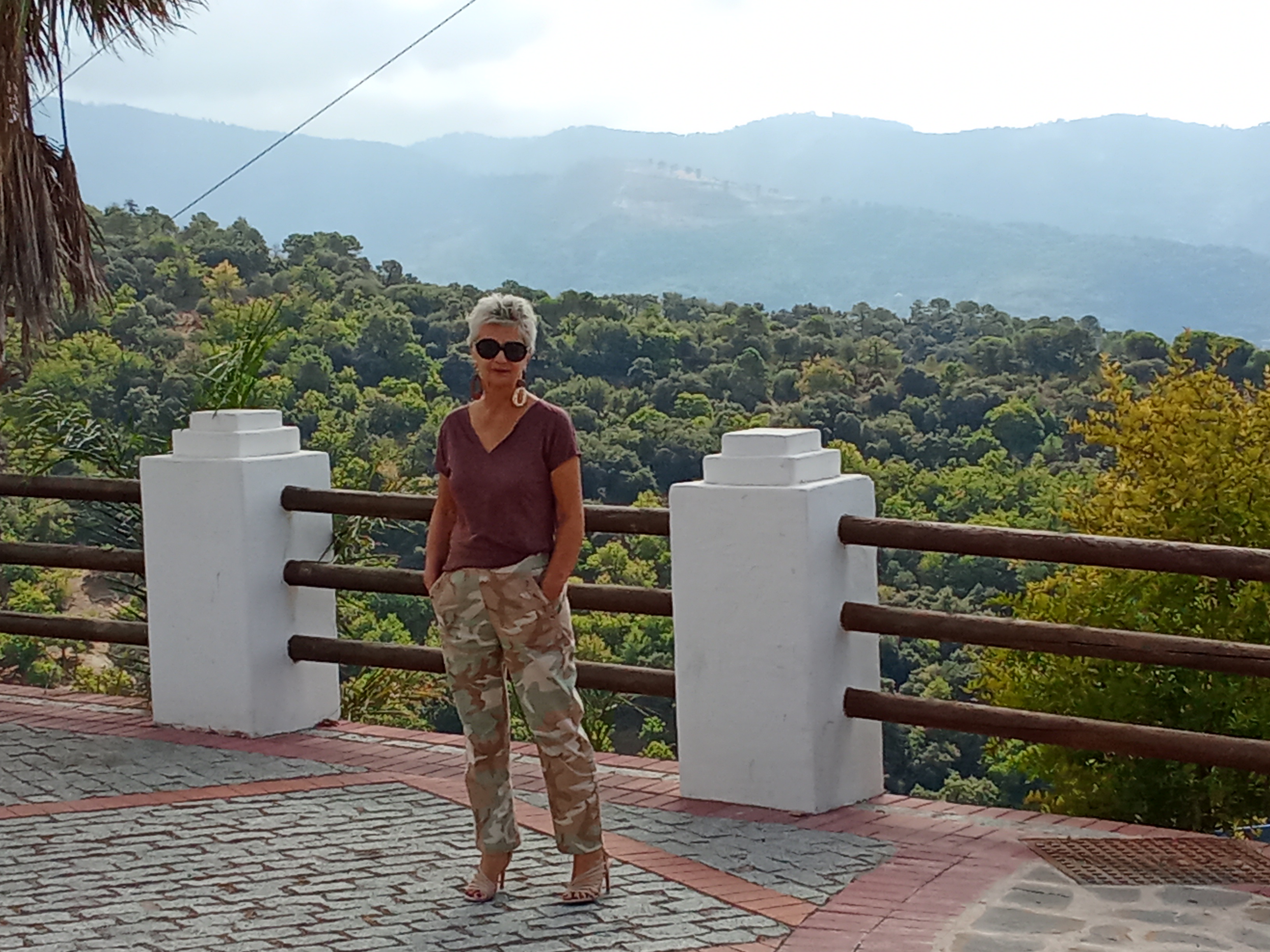
Our arrival [Photos by Paul Whitelock]
The birthplace of Fray Leopoldo, a recently created saint. There are frequent references to him throughout the village, as well as a signposted walk. Guides are available for this and other activities.
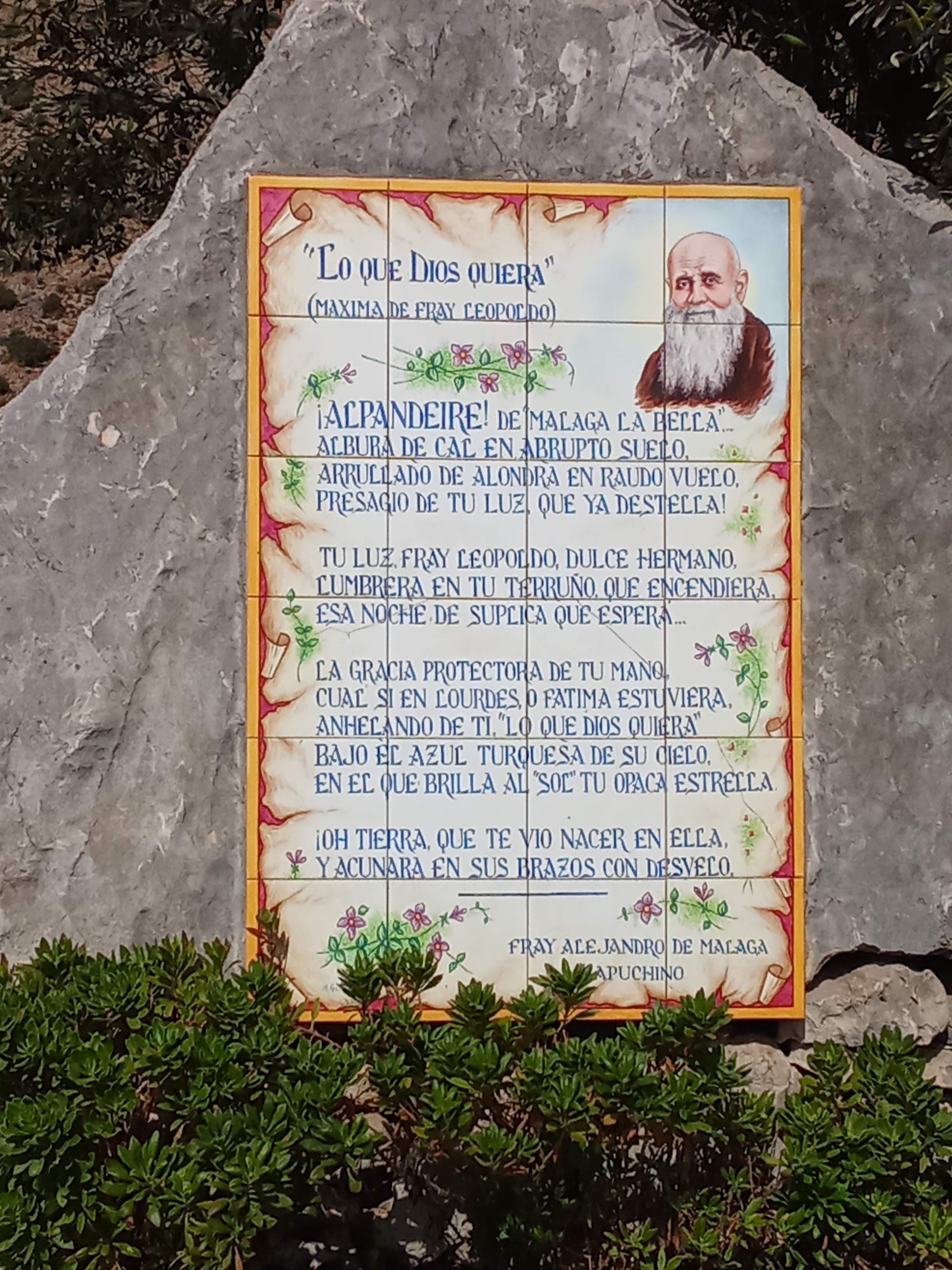 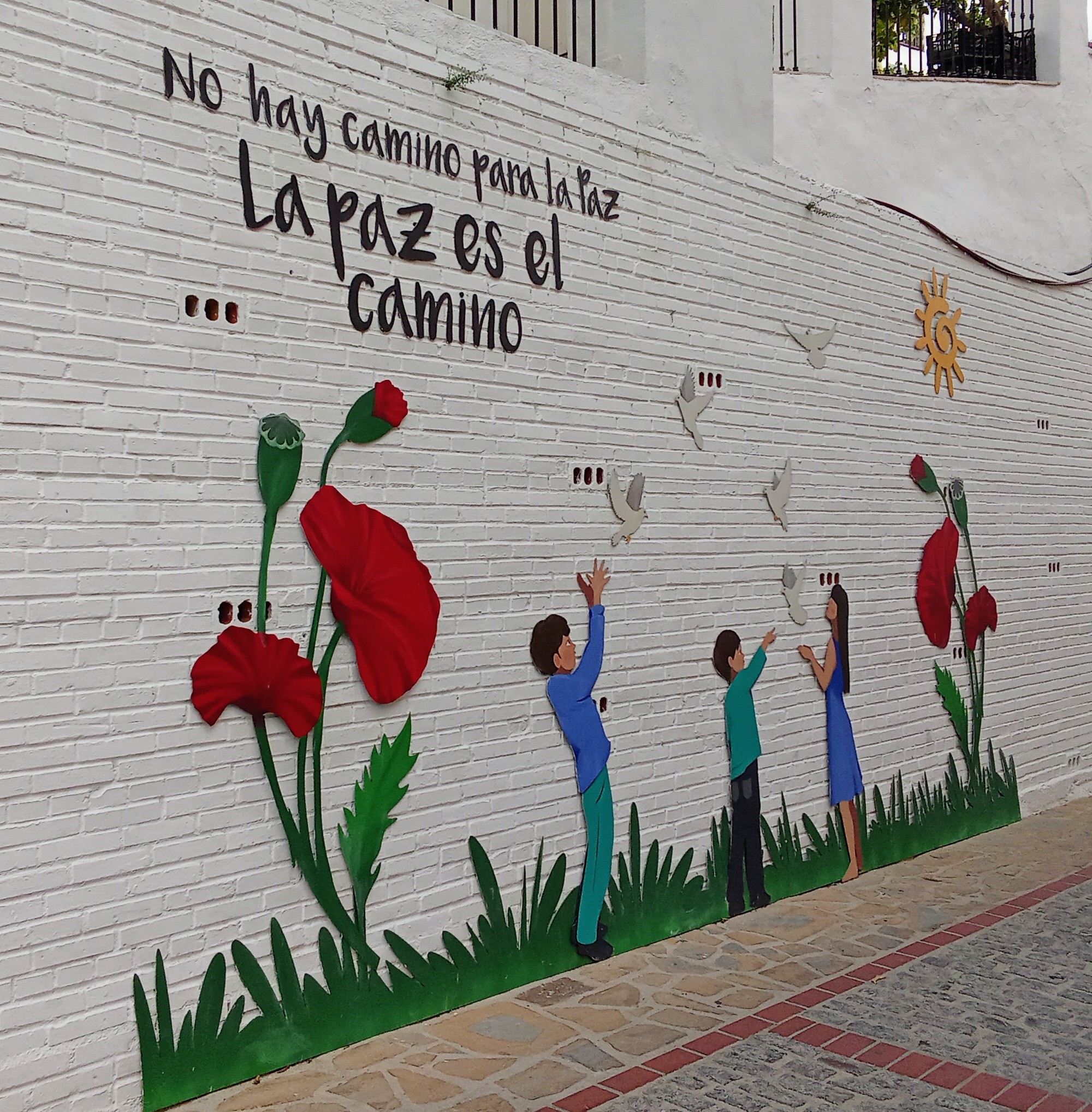 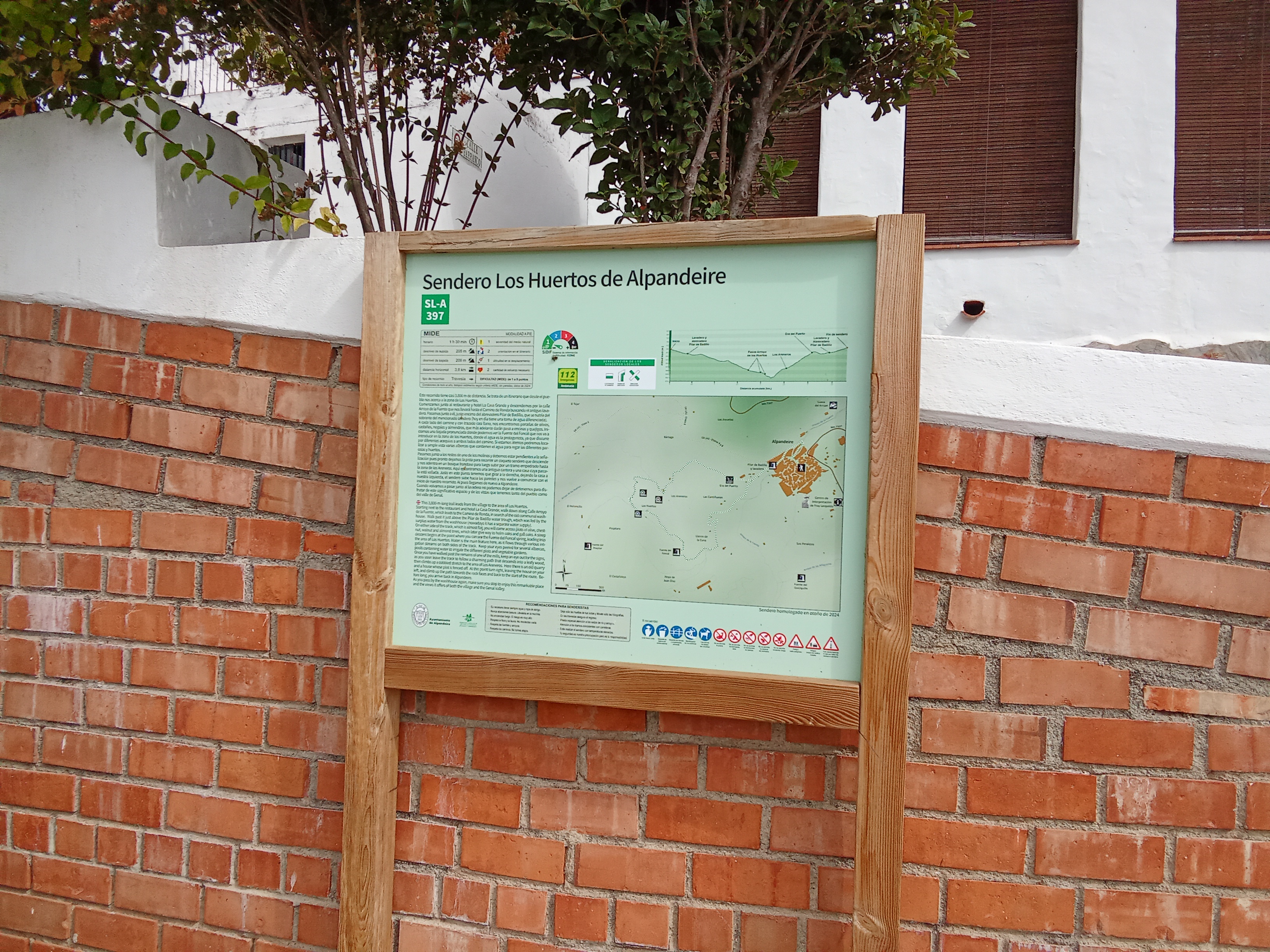
[All photos by Paul Whitelock]
However, we weren't there because of this worthy monk, but to dine at the restaurant attached to Hotel La Casa Grande.
Our friends John and Lorraine dined there a week ago and were so impressed they wanted to eat there again before heading to Portugal to catch their flight home to Malta from Lisbon airport.
The meal:
John and I chose the same starter, but apart from that we all enjoyed different dishes.
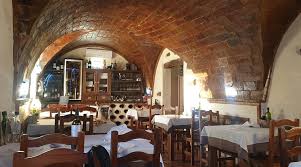 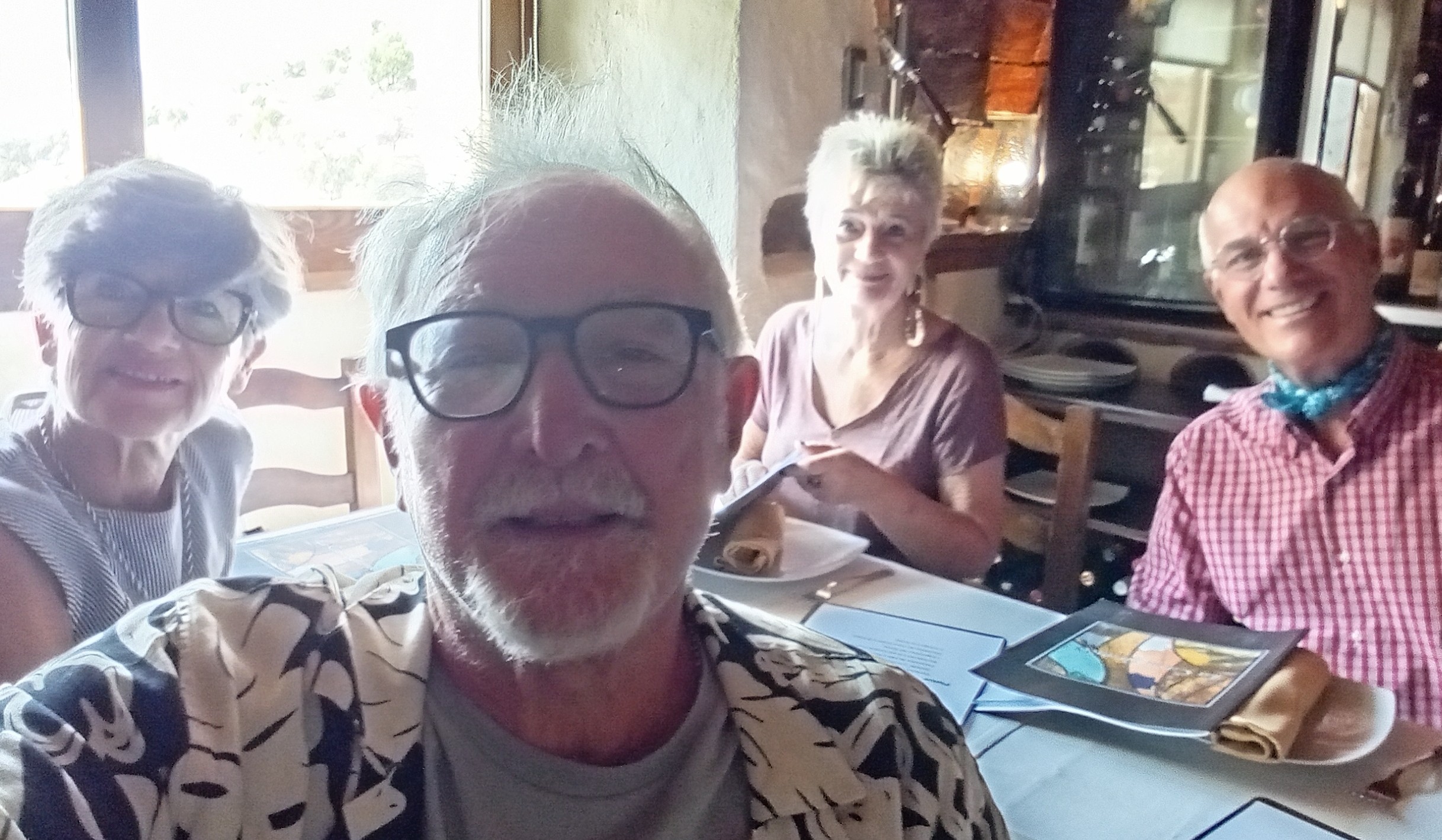 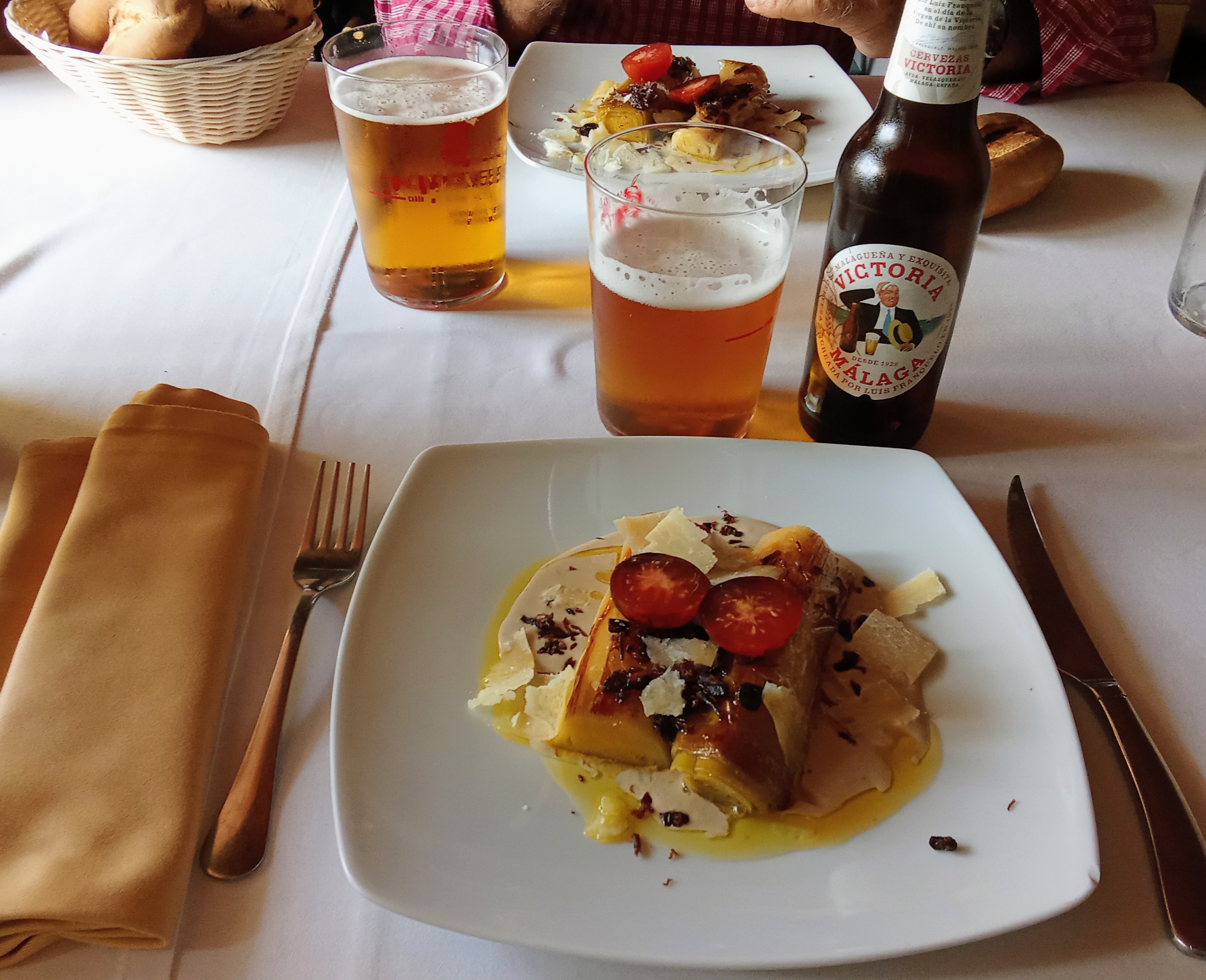 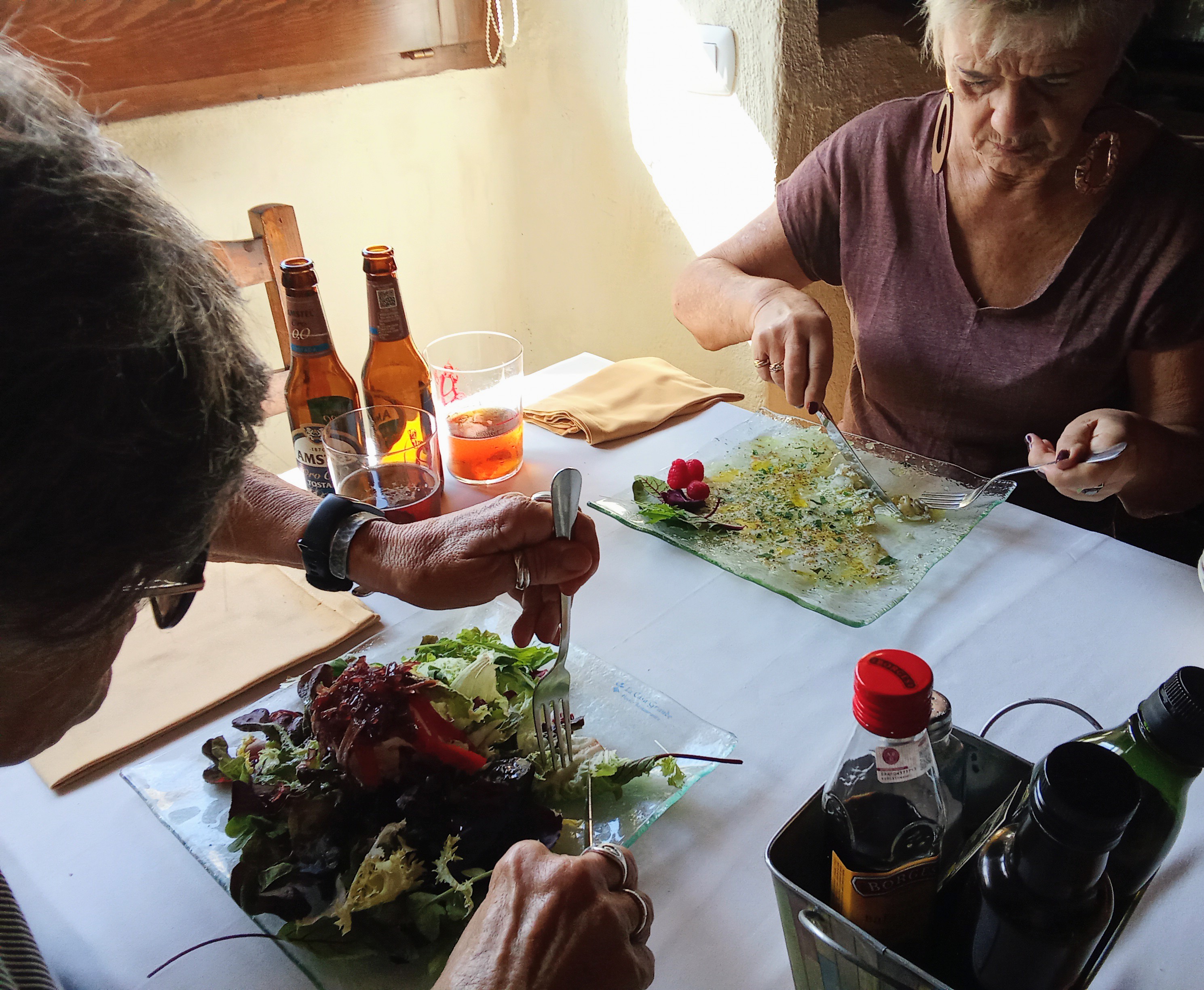
The Dining Room Lorraine, Paul, Rita and John Puerro Ensalada / Carpaccio
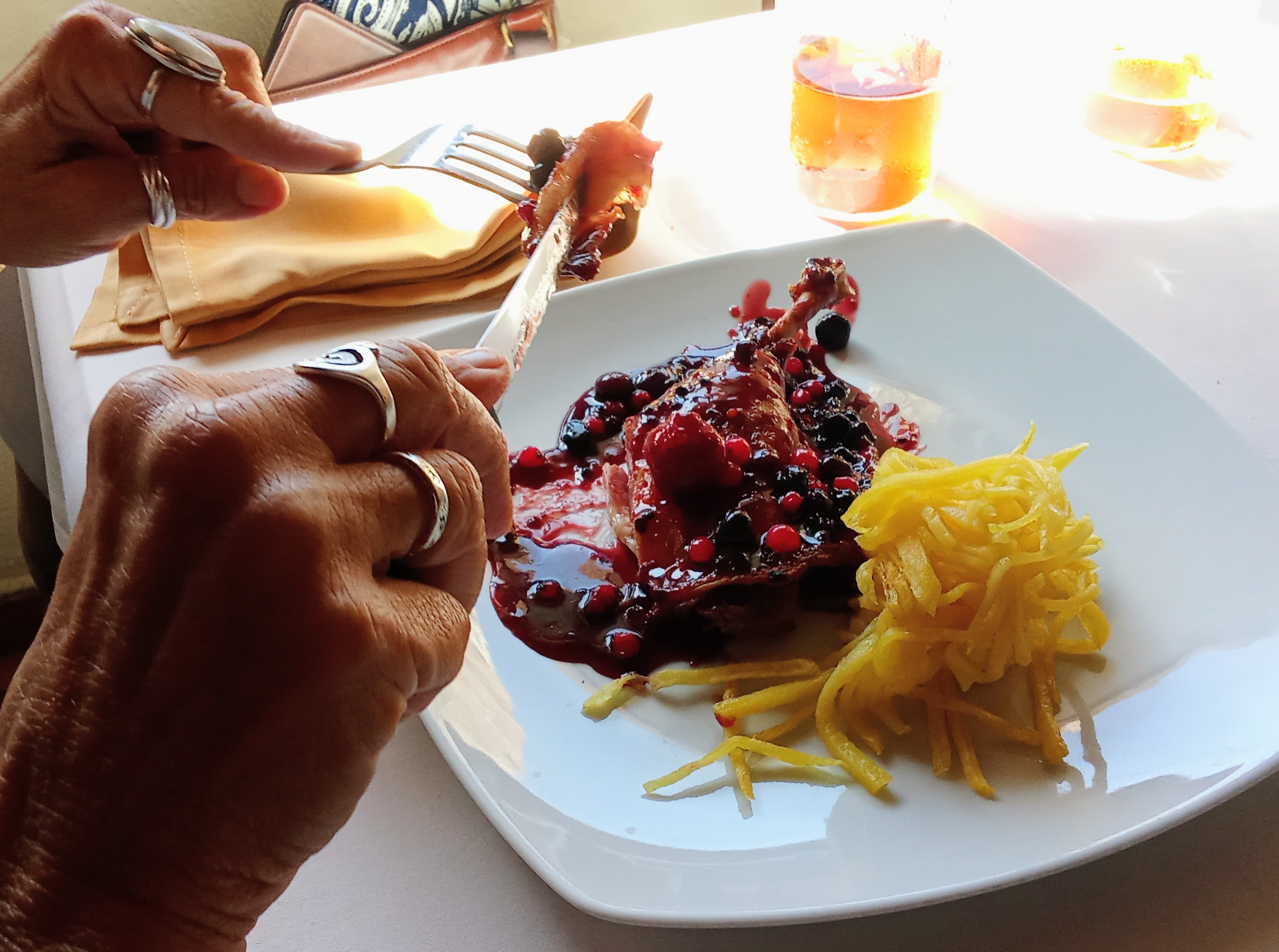 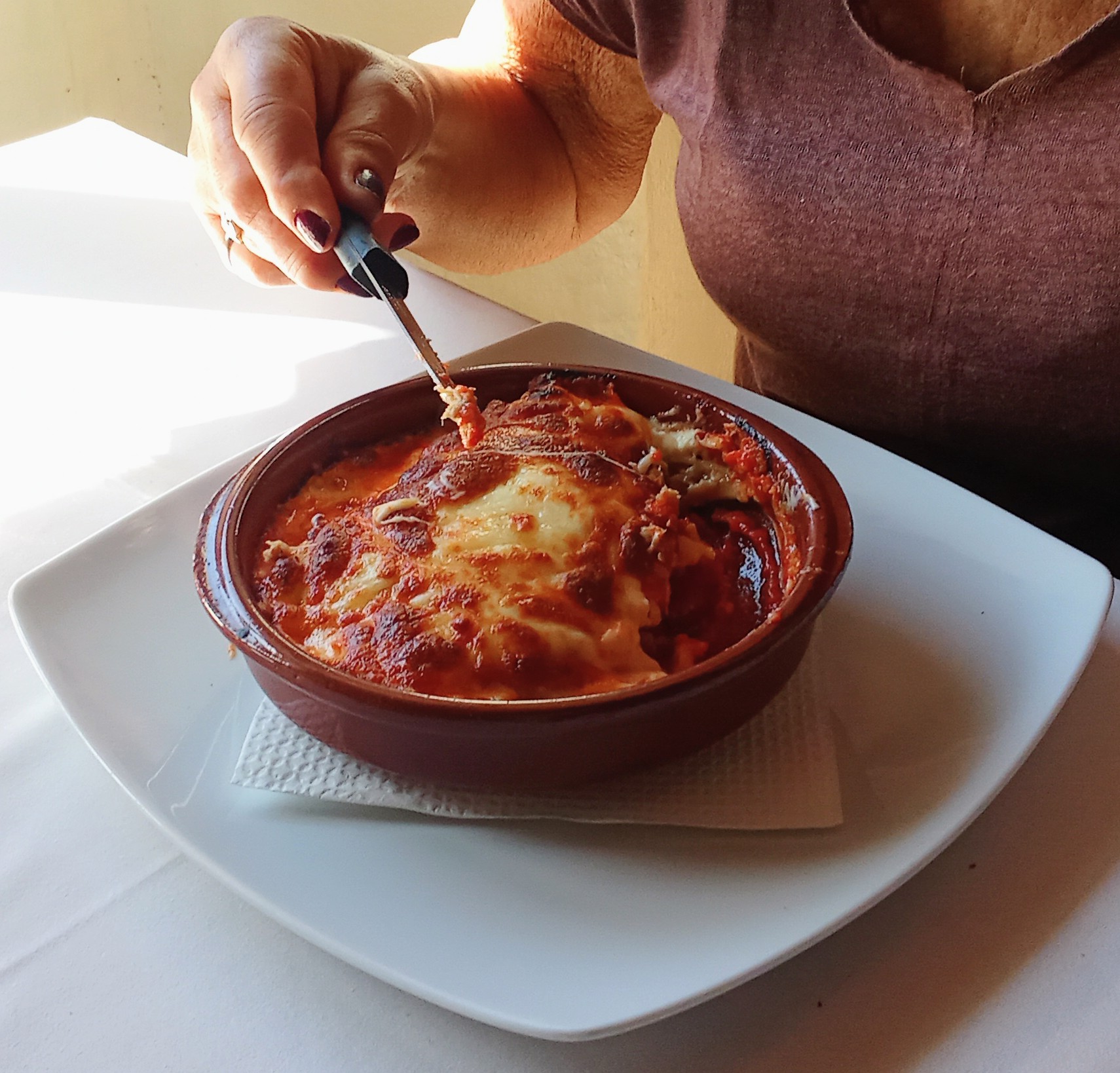 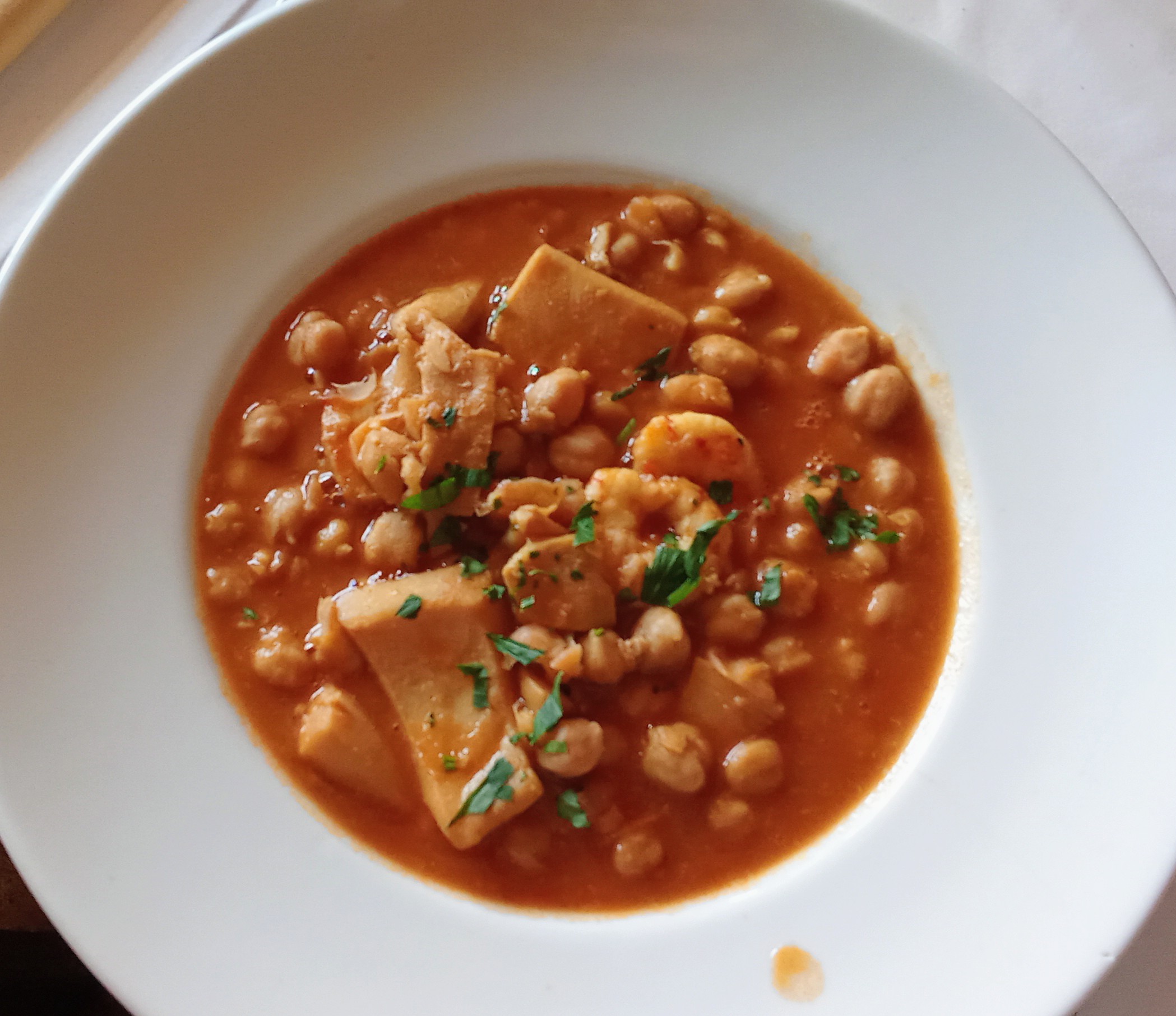 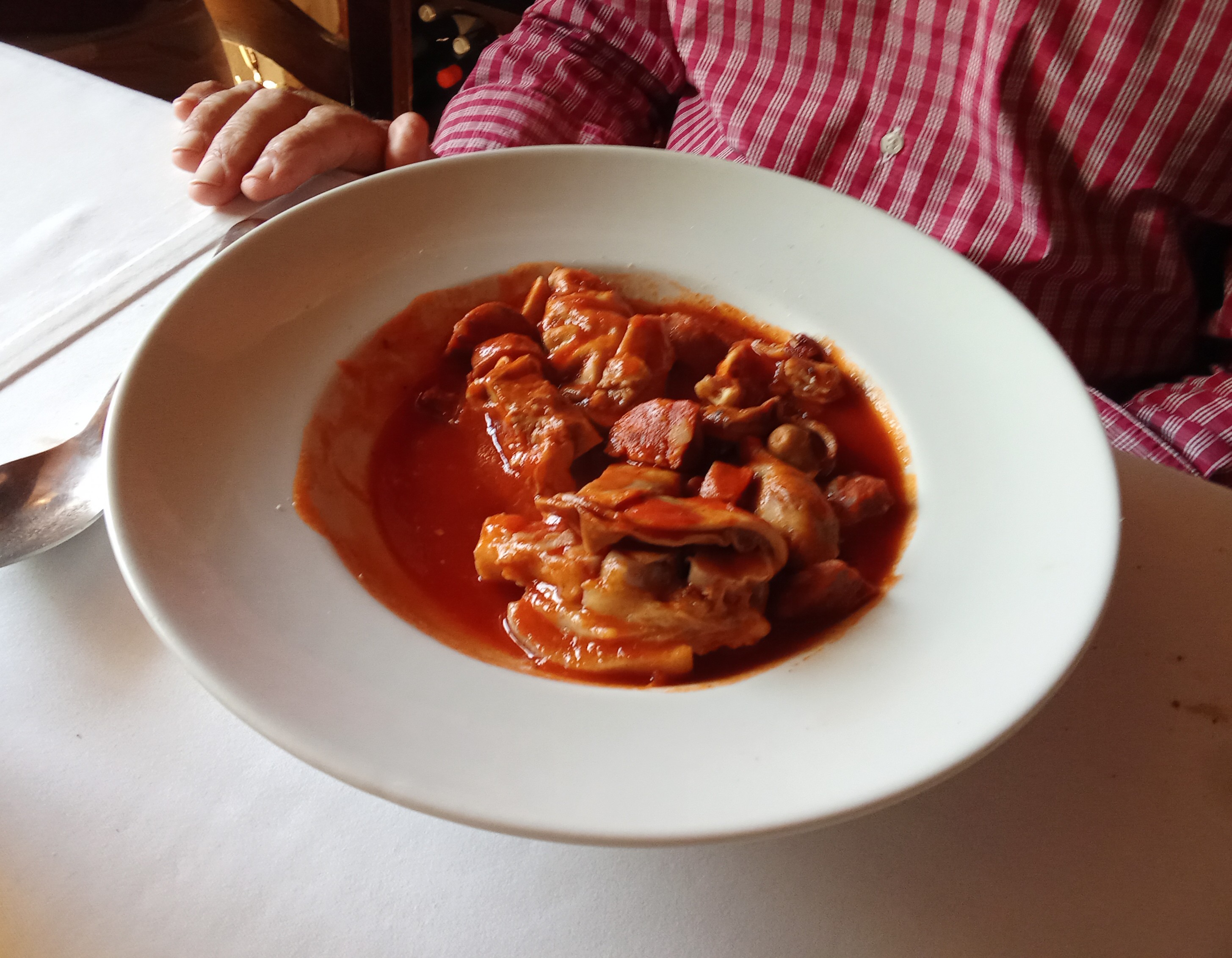
Confit de pato Canellones Garbanzos Offal stew
[All photos by Paul Whitelock]
Endword:
Our day out did not disappoint. It was fascinating to revisit the villages of the Genal Valley after a significant time gap and to see all the changes that have been made.
Our lunch at La Casa Grande was also a treat. We enjoyed the food and the occasion immensely and we were delighted at the warm welcome from owner Jesus, his wife Maria and their outstanding chef, local boy Antoñito.
"We'll be back!"
© The Spanish Fly (aka Paul Whitelock)
Pictures:
Ayuntamiento de Juzcar, Europa Press, Paul Whitelock, Rustica Estates, Trip Advisor, Wikipedia, YouTube
Acknowledgements:
Ayuntamiento de Alpandeire, Ayuntamiento de Juzcar, Diputacion de Malagaa, John Saliba, Karl Smallman, Paul Whitelock, Secret Serrania, Wikipedia
Tags:
Algeciras, Alpandeire, Ayuntamiento de Juzcar, Cartajima, El Bosque Encantado, Europa Press, Farajan, Fray Leopoldo, Genal Valley, Juzcar, La Casa Grande, Maude, Montejaque, Parauta, Paul Whitelock, population decline, Pueblo Azul, Pueblo de Las Murallas, Rita, Rustica Estates, Serrania de Ronda, Smurfs, The Spanish Fly, Trip Advisor, Valle del Genal, Wikipedia, YouTube
 3
Like
Published at 6:25 PM Comments (1)
3
Like
Published at 6:25 PM Comments (1)
National Geographic Spain No. 306
Wednesday, October 8, 2025
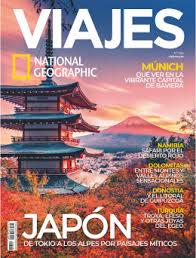 This publication, originally American, has been showing readers the rest of the world for decades, with fabulous photos and well-researched write-ups. This publication, originally American, has been showing readers the rest of the world for decades, with fabulous photos and well-researched write-ups.
The Spanish version, "Viajes" has recently published its 306th edition.
I was attracted by the front cover which promised features on Munich and San Sebastian (Donostia), cities I used to know well.
So, I bought a copy!
[Front cover by Tienda RBA]
Pre-amble
Imagine my surprise when I flicked through the magazine, while I partook of Sunday morning breakfast in a café in Ronda.
There were also articles about Asturias, where I spent a week in 2003; Barcelona, which I had visited often in the past; Ibiza, where I spent my first honeymoon; Cantabria (Spain), where I have been quite a few times; Gran Canaria (a week's family holiday back in the late 1980s); Luxembourg, the Grand Duchy, which I have visited regularly over the years, the last time being a three-month sojourn in 2008, when I enjoyed a summer romance (I was divorced and single by then, and she was a widow, so it was legitimate).
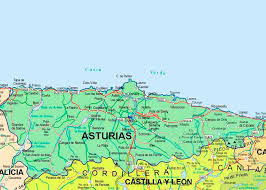 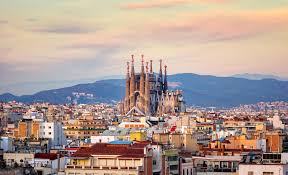
Map of Asturias [Centro Asturiano de B A] Sagrada Familia, Barcelona [The Independent]
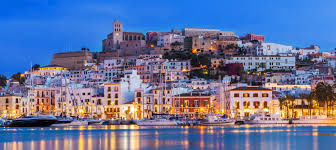
Ibiza Town [Club Villamar]
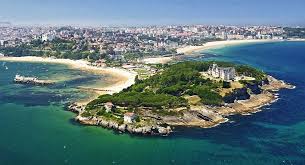
Santander [Turismo de Santander]
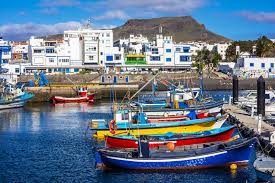 
Colourful boats in Gran Canaria [Hostelworld] Luxembourg Ville [Outdooractive]
The magazine also had features on the Dolomites (Italy); Turkey; Japan; and Namibia. I have not been to any of these countries, but judging by the photos, I've missed out!
So, Italy and Turkey are now on my "bucket list". Namibia and Japan, probably not - I don't enjoy long-haul flights.
Donostia (San Sebastian)
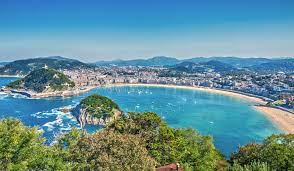 This elegant Victorian seaside town was the first place I went to in Spain back in 1970. This elegant Victorian seaside town was the first place I went to in Spain back in 1970.
I and some 20 other undergraduates studying for a degree in Spanish were sent to the Basque city for six months as part of our course.
Bahia de La Concha, San Sebastian [Civitatis]
I was smitten. I fell in love with the town straightaway. I loved the people, the lifestyle, the ambience, in short, I fell in love with Spain, despite the country still being a fascist dictatorship under General Franco. He was to live for five more years, dying of natural causes in November 1975.
You can read more about my San Sebastian story here:
The Top Dozen MIPs in My Life – Part 1
Munich, Germany
 I was sent to Germany immediately after my six months in San Sebastian. I had a placement at Daimler-Benz AG in Stuttgart. My pal Roger also had a placement in Stuttgart at Bosch. We decided to go a bit earlier to take in the Munich Oktoberfest, the beer festival, which, despite its name, takes place in September. I was sent to Germany immediately after my six months in San Sebastian. I had a placement at Daimler-Benz AG in Stuttgart. My pal Roger also had a placement in Stuttgart at Bosch. We decided to go a bit earlier to take in the Munich Oktoberfest, the beer festival, which, despite its name, takes place in September.
[Photo: La Voz de Galicia]
What a culture shock (and a weather shock!).
I've been to Munich a couple of times since.
After I "hooked up" with Rita, a German "traffic warden" living in the Ronda area ("Lovely Rita, Meter Maid" by the Beatles), we went to Munich to visit her former sister-in-law, Ulrike, for a week.
I also visited briefly with Rita's daughter's family, following our marriage in 2010.
Here's the Beatles song:
youtube lovely rita - Búsqueda
Epilogue
So, I was very pleased with my Spanish National Geographic "Viajes" edition 306. It reminded me of some fabulous places I've been to and gave me a couple more, Italy and Turkey, for my "bucket list".
© The Spanish Fly
Links:
My Special Places in Spain
The Top Dozen MIPs in My Life – Part 1
Working for free? Why? Er… why not? Part 2.
youtube lovely rita - Búsqueda
Pictures:
Civitatis, Club Asturiano de B A, Hostelworld, La Voz de Galicia, Paul Whitelock, Tienda RBA,
Thanks:
Paul Whitelock, Wikipedia
Tags:
306th edition, Asturias, Barcelona, Beatles, Bosch, "bucket list", Cantabria, Civitatis, Club Asturiano de B A, Daimler-Benz AG, degree in Spanish, Dolomites, Donostia, German "traffic warden", Gran Canaria, Grand Duchy, Hostelworld, Ibiza, Italy, Japan, La Voz de Galicia, "Lovely Rita, Meter Maid", Luxembourg, Munich, Namibia, National Geographic, Oktoberfest, Paul Whitelock, Rita, San Sebastian, Stuttgart, summer romance, The Spanish Fly, Tienda RBA, Turkey, "Viajes", Wikipedia
 2
Like
Published at 8:39 PM Comments (0)
2
Like
Published at 8:39 PM Comments (0)
Marbella, Nerja and Almáchar - a magical mini-break
Saturday, September 13, 2025
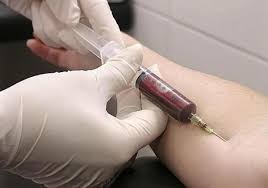 We had to go to the coast early on Thursday for medical appointments. Coincidentally our English friends Ian and Christine were staying in Nerja, where they have been holidaying regularly for some 30 years. As always since I have lived in Spain (17 years and counting) they invited us to come and stay. We had to go to the coast early on Thursday for medical appointments. Coincidentally our English friends Ian and Christine were staying in Nerja, where they have been holidaying regularly for some 30 years. As always since I have lived in Spain (17 years and counting) they invited us to come and stay.
[Photo courtesy of La Verdad]
Marbella
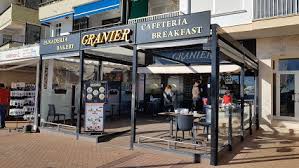 After our "blood-letting" at hospital Quirón in Marbella, we headed to Fuengirola to our favourite breakfast cafe, Granier, on the seafront. After our "blood-letting" at hospital Quirón in Marbella, we headed to Fuengirola to our favourite breakfast cafe, Granier, on the seafront.
There we hungrily scoffed a classy, if somewhat expensive, breakfast. But, hey, we were at the seaside!
[Photo courtesy of Wecake]
From Fuengirola we took the A7 motorway around Malaga City, then exited at Rincon de la Victoria in order to pick up the coast road heading east to Nerja.
After a coffee and loo stop in delightful Torre del Mar, we got to Nerja just after 1.00 pm.
Nerja
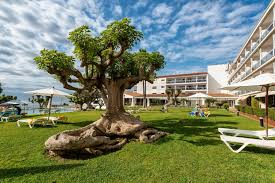 I parked opposite Ian and Christine's rental apartment by the parador de turismo in a loading bay. According to the sign private cars could park there from 2.00 pm until 5.00 pm. It was 1.15 pm. The other car parked there had already received a ticket. I parked opposite Ian and Christine's rental apartment by the parador de turismo in a loading bay. According to the sign private cars could park there from 2.00 pm until 5.00 pm. It was 1.15 pm. The other car parked there had already received a ticket.
I put my hazard warning lights on and laid my Press pass on the dashboard, hoping for the best.
[Paradores]
After lugging our stuff up to the 2nd floor apartment (no lift!) we had drinks on the enormous roof terrace before going out for a couple more libations in local bars.
I paid the bill. It was by now gone 5.00 pm and I was interested to find out whether my Press pass had worked .....
It had!
Then it was back up to the roof terrace for a late barbecue lunch, courtesy of Ian.
Dorada con ensalada. Marvellous!

On the next-door terrace was a whole bunch of Irish people. I had a good natter with them about a range of topics dear to their hearts and mine.
Siesta time! I went for a lie-down. I was tired and I'd drunk a fair bit!
[Photo courtesy of the New York Times]
After around half an hour it was time to go out again! We walked to the "West End" of Nerja, where there are fewer tourists.
We went to three bars - La Rienda, La Casa de Ana and another place, the name of which I can't remember - each different but very good. The "free" tapas went down extremely well and were more than sufficient for our evening meal.
On the walk back to the apartment the other three wanted a dessert, so they went to an ice-cream parlour. I was "stuffed" so opted out.
Back at the flat we retired straightaway.
Friday
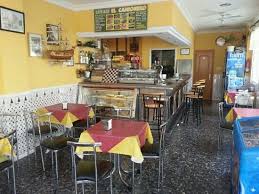 I was up early as usual and went for an early morning coffee. I was up early as usual and went for an early morning coffee.
My car was still "unticketed" but I thought it wise not to push my luck, so by car I went to my cafe bar of choice, El Camionero, up on the main road.
I found a free parking spot nearby and spent a very pleasant hour during which I caught up with the latest news on the TV, had two coffees, a chupito, and a breakfast of ham and cheese on a pitufo.
[Cafe Bar Camionero by Trip Advisor]
Then I headed back to the apartment and managed to park legally and free nearby. I needed to go to the bank to check whether my pension had arrived, so I walked down to the Balcón de Europa, where the banks are all located.
Yes, my money was in my account.
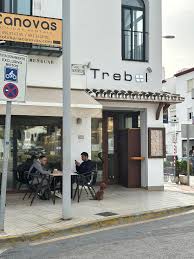 I headed back to the cafe - Treból - where we had agreed to meet for breakfast, arriving before the others. I headed back to the cafe - Treból - where we had agreed to meet for breakfast, arriving before the others.
We breakfasted well (I had my customary second breakfast, recommended by my doctor for my diabetes) before we got ready for the day ahead.
[Facebook]
Almáchar
This was where I had been a week earlier on a Press Trip. The other three had never been there before so that was our plan for a couple of hours.
Almáchar was hot and shut. Apparently, weekends in the Axarquia are no big deal.
So, after some refreshment in a cool bar we discussed where to have lunch. I suggested the seafront in Torre del Mar. Ian and Chris had never been there, so that's what we did.
We parked and chose the Chiringuito El Boquerón. We snaffled a table overlooking the splendid beach and each ordered what we wanted. We all had fresh fish of some kind.
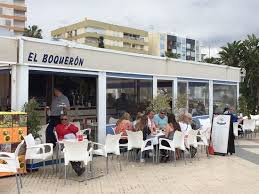 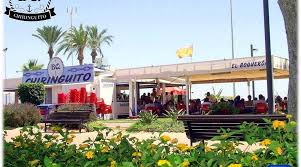
[Photos: Trip Advisor]
I indulged in some great beers - El Alcázar (Jaén) and El Águila (Madrid) and Rita, who stuck to her cerveza 'sin' tostada, agreed to drive our hosts back to Nerja.
***
We dropped Ian and Christine off, said our farewells, and hit the road for home. Rita drove all the way and we got home around 7.20 pm, where we learned that our terminally ill next-door-neighbour, Manolo, had passed away and been "buried" while we were on our break. He was just 66 years old.
What a shame!
At home the cats were there to welcome us, so we fed them and then I went to my local, the Ronda Valley Hotel, to meet up with our cat-sitter Ollie and pay him.
Then I started to write this up .....
And, finally .....
A great couple of days were over. I have known Ian and Christine since before kids and our oldest children, theirs and mine with Jeryl, are now in their 40s, so that's a long relationship.
They have known Rita since 2008 when she and I had just met and were courting.
Thank goodness everybody gets on fine!
Links:
Early morning coffee in Spain - Secret Serrania de Ronda
Nerja - a little gem - Eye on Spain
The best and worst of the Western Costa del Sol - Eye on Spain
© The Spanish Fly (Paul Whitelock)
With thanks to:
Facebook, La Verdad, Paradores, The New York Times, Trip Adviser, Wecake, Wikipedia
Tags:
A7 motorway, Almáchar, Balcón de Europa, CaixaBank, Christine, chupito, El Camionero, Facebook, Fuengirola, Granier, Ian, Jaén, La Verdad, Marbella, Nerja, Parador de Turismo, Paradores, Paul Whitelock, pitufo, Quirón, Rincón de la Victoria, The New York Times, The Spanish Fly, Torre del Mar, Trip Adviser, Vélez-Málaga, Wecake, Wikipedia
 2
Like
Published at 8:48 PM Comments (0)
2
Like
Published at 8:48 PM Comments (0)
Swimming Pools
Friday, August 22, 2025
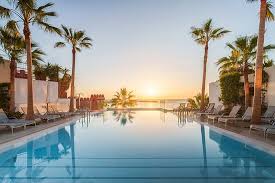 According to a recent survey the number of open air swimming pools in different parts of Spain is rather interesting. In a study by Cadastral / Instituto Nacional de Estadisticas (INE), the province with the most pools is Comunidad de Madrid with 145,881. According to a recent survey the number of open air swimming pools in different parts of Spain is rather interesting. In a study by Cadastral / Instituto Nacional de Estadisticas (INE), the province with the most pools is Comunidad de Madrid with 145,881.
[Photo courtesy of Trip Advisor]
Second is Alicante province with 130,813 and third is Barcelona province with 106,681.
Given that Alicante and Barcelona are on the Mediterranean coast, this is somewhat surprising.
Malaga province comes in fifth with 82,559 open air pools, despite having a lengthy coastline (Costa del Sol).
Preamble
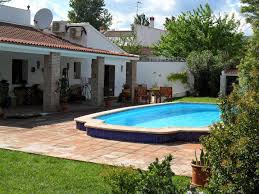 One of the pools in Malaga province is mine. I live in inland Ronda, over an hour's drive to the nearest beach, so my pool is a "must". One of the pools in Malaga province is mine. I live in inland Ronda, over an hour's drive to the nearest beach, so my pool is a "must".
With the high summer temperatures I am in and out of the pool all day, in an effort to keep cool.
My pool [Photo: A1 Inmobiliaria]
Pools by municipality
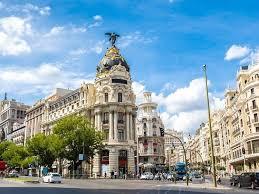 Madrid city comes out top with 14,757 pools. Located in the geographical centre of Spain this is hardly surprising. It's a long way to the coast whichever direction you choose! Madrid city comes out top with 14,757 pools. Located in the geographical centre of Spain this is hardly surprising. It's a long way to the coast whichever direction you choose!
Second is Cordoba, which surprises me. There are 12,053 pools there. Another surprise is Murcia City, which has 10,852, despite being on the coast. Fourth on the list is Chiclana de la Frontera (Cadiz), also on the coast (Costa de la Luz - Atlantic).
Madrid [Photo: Time Out]
Pools in Malaga Province
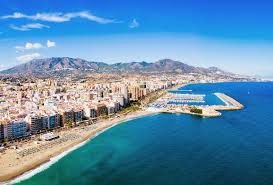 Marbella is number one with 11,296 despite being right on the coast. Number 2 is Mijas with 8.770. Malaga City is third with 6,549, also on the coast. Marbella is number one with 11,296 despite being right on the coast. Number 2 is Mijas with 8.770. Malaga City is third with 6,549, also on the coast.
Ronda apparently has 1,729, of which one is mine (see above).
Benahavis, a well-to-do town, has 2,181 pools, and Frigiliana, also an expensive village inland from Nerja, has 1,048.
Marbella [Colliers]
Endword
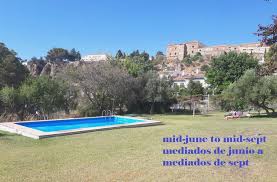 I am the only British ex-teacher I know who has a pool. Then, most British ex-teachers live in the UK. Who needs an open air pool there? I am the only British ex-teacher I know who has a pool. Then, most British ex-teachers live in the UK. Who needs an open air pool there?
My first property in Spain, Piso Blanco purchased in 2001, had a shared pool in a comunidad de propietarios of 12 dwellings.
My second, Casa Blanca, didn't, nor did my fourth, Casa Real. But we survived.
The pool at Piso Blanco [Photo: Trip Advisor]
My third property, our domicilio, has its own private pool. Which is perfect! We've even been known to "skinny-dip", when we don't have family staying, although our German visitors are quite partial to a bit of FKK (Freikorperliche Kultur) also!
I have to say that a swimming pool is a "must". It's not even a luxury down here in Andalucia.
© Paul Whitelock
Photos:
A1 Inmobiliaria, Colliers, Karl Smallman, Paul Whitelock, Time Out, Trip Advisor
Tags:
A1 Inmobiliaria, Alicante, Barcelona, Benahavis, Cadastral, Casa Blanca, Casa Real, Chiclana de la Frontera, Colliers, Cordoba, Cristina Vallejo, Diario Sur, Frigiliana, INE, Instituto Nacional de Estadisticas, Karl Smallman, Madrid, Marbella, Mijas, Murcia, Nerja, Paul Whitelock, Piso Blanco, SUR in English, swimming pool, Time Out, Trip Advisor
 1
Like
Published at 10:21 PM Comments (0)
1
Like
Published at 10:21 PM Comments (0)
The Camino de Santiago
Monday, June 30, 2025
The Camino de Santiago
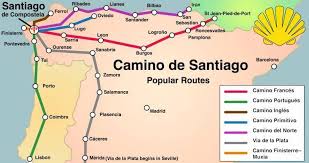 I first heard about this pilgrimage route when I was an undergraduate studying Spanish in the north west of England. Then The Camino kept cropping up. I first heard about this pilgrimage route when I was an undergraduate studying Spanish in the north west of England. Then The Camino kept cropping up.
[Map courtesy of Facebook]
Several writers on Spain referred to it. I went on a course through the European Union Socrates programme which was held in one of the starting points, Jaca (Aragon).
Two parishioners from my local church in Cheshire did the walk and gave a talk in church one evening with slides, which I attended.
Hollywood star Shirley MacLaine wrote a book after she had walked the route.
There was a TV series and several films. As it happens I live not far from the approved southern route.
Why this article now?
 Today at my libreria in Ronda, I stumbled across a great illustrated book on the Camino. At just 19,95 euros I couldn't resist it. A belated birthday present from me to me. Today at my libreria in Ronda, I stumbled across a great illustrated book on the Camino. At just 19,95 euros I couldn't resist it. A belated birthday present from me to me.
I regret not walking The Camino when I was younger and fitter. Now, aged 75, I will not be able to manage it. Covid-19 left me with issues of balance, mobility and breathlessness, so, unless I do it by car, which I shan't, I will have to continue to enjoy The Camino vicariously.
Indeed the book I bought, "Atlas Ilustrado del CAMINO DE SANTIAGO", stated on the back cover:
"Es una obra para disfrutar de la cultura y los pueblos del Camino, tanto si se piensa en hacerlo como si ya se ha hecho o solo se desea conocerlo desde casa."
[Photo by Paul Whitelock]
The Camino at 20
When I started to study Spanish ab initio at Salford University in 1968, I knew very little about Spain. That changed quickly once we got into the course and even more so when we were sent on our six months to San Sebastian.
I started to hear about the Camino de Santiago and realised it was a big deal. The cathedral in Santiago de Compostela, the ultimate destination and endpoint, is one of the most popular pilgrimage sites in Europe. There are six official routes starting at different points around Spain.
More on the Camino
Washington Irving, Laurie Lee and George Orwell all mentioned the Camino in their writings.
.jpg) 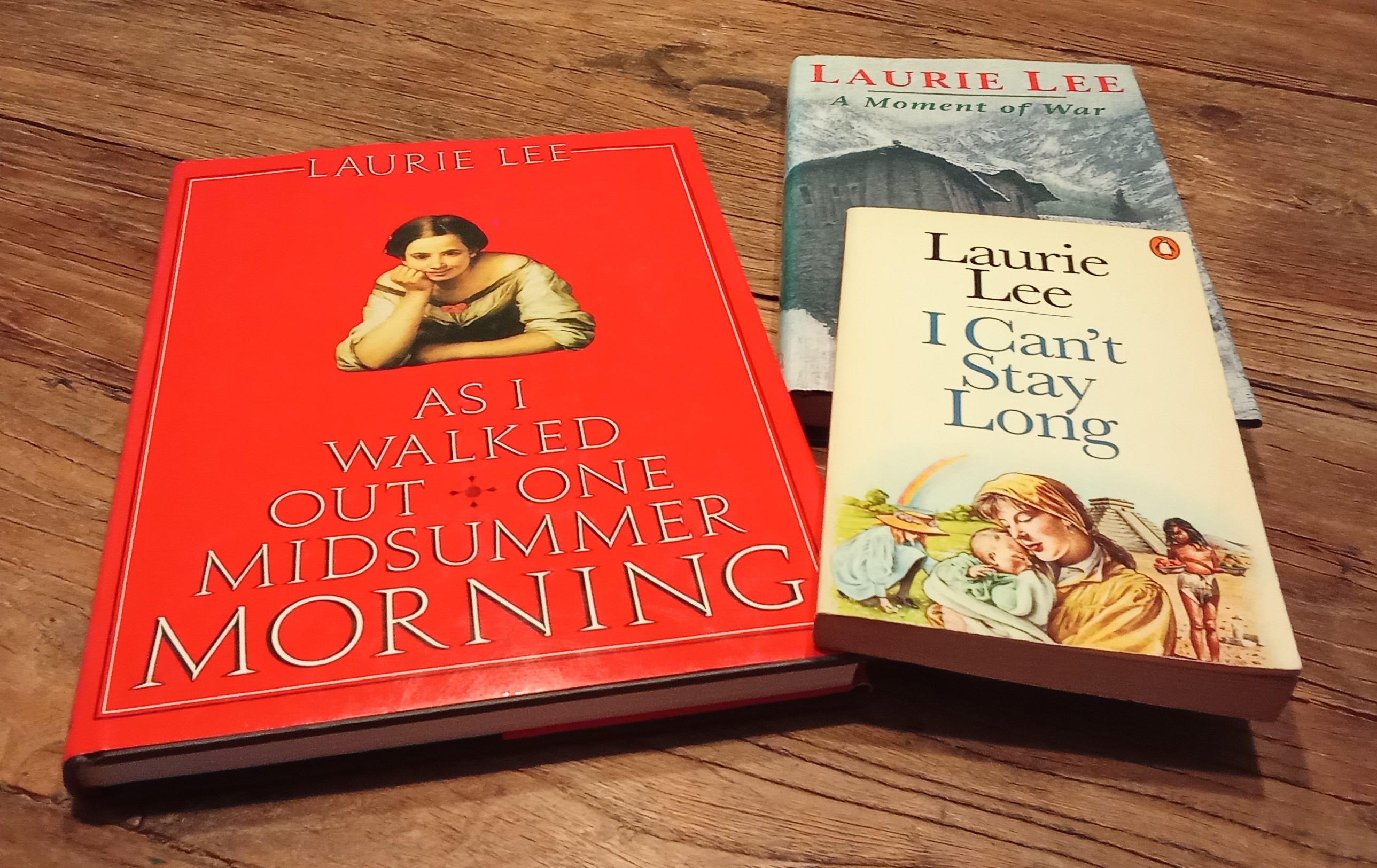 
[Photos (L to R): Wikipedia; Paul Whitelock; Wikipedia]
Jaca 1998
A quarter of a century into my career in education (15 years as a languages teacher and then as a schools adviser and OfSTED inspector) I got the chance to attend a European Union Socrates Programme Spanish course in Jaca, Aragon. The course was a refresher course for professional linguists from across Europe.
Those two weeks over 25 years ago remain amongst the highlights of my life. I went with my girlfriend at the time, a languages advisory teacher based in London. Anne was predominantly a French expert with some Spanish and needed to improve her level of Spanish. I had been "out of the classroom" for nearly 10 years, so I had become somewhat rusty and needed a refresher.
We flew from Gatwick to Tarbes in France, hired a car and headed off to Aragon via San Sebastian and Fuenterrabia. A night in the Hotel Niza on the bay of La Concha in the elegant Victorian resort followed by a night in the Parador in Fuenterrabia, arguably one of the best paradores in the near-100-strong chain.
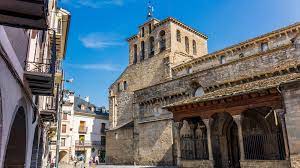 When we got to Jaca and checked in to the training centre of the University of Aragon, we learned that this Pyrennean town was the starting point for one of the northern routes of the Camino de Santiago. The place was heaving with pilgrims/walkers. When we got to Jaca and checked in to the training centre of the University of Aragon, we learned that this Pyrennean town was the starting point for one of the northern routes of the Camino de Santiago. The place was heaving with pilgrims/walkers.
"We should walk the Camino one day," I pronounced. Of course we never did, as our relationship sadly ended the following year.
Jaca, Aragon [Facebook]
Oviedo 2002
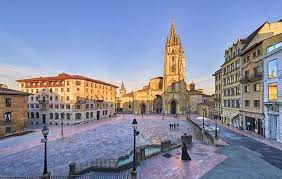 My next "contact" with The Camino came when I took part in a EU Study Visit to Asturias to look at early years foreign language provision. A foreign language, usually English, is compulsory in Spanish schools from the age of three. My next "contact" with The Camino came when I took part in a EU Study Visit to Asturias to look at early years foreign language provision. A foreign language, usually English, is compulsory in Spanish schools from the age of three.
On of the northern pilgrimage routes passes close by Oviedo, the town in which we were based.
Apart from the course which was excellent and the visits to schools, I drank cider in the traditional way, enjoyed a different part of Spain and - ahem - had a little dalliance on the side. With a very open-minded German headteacher.
Oviedo [Turismo de Asturias]
Thelwall, Cheshire
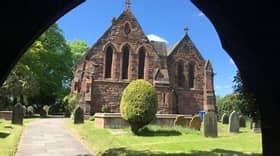 John and Joan Arthurs, neighbours of ours, walked The Camino the year they both retired from work. John and Joan Arthurs, neighbours of ours, walked The Camino the year they both retired from work.
They gave a presentation with slides, anecdotes and not a little humour at All Saints Church in Thelwall.
I attended and felt inspired by their achievement.
[https://allsaints.org.uk]
Shirley MacLaine
 Her book "The Camino" was, for me, a disappointment. It was more a book about her mental state at the time. Her book "The Camino" was, for me, a disappointment. It was more a book about her mental state at the time.
[Photo: Paul Whitelock]
TV Series
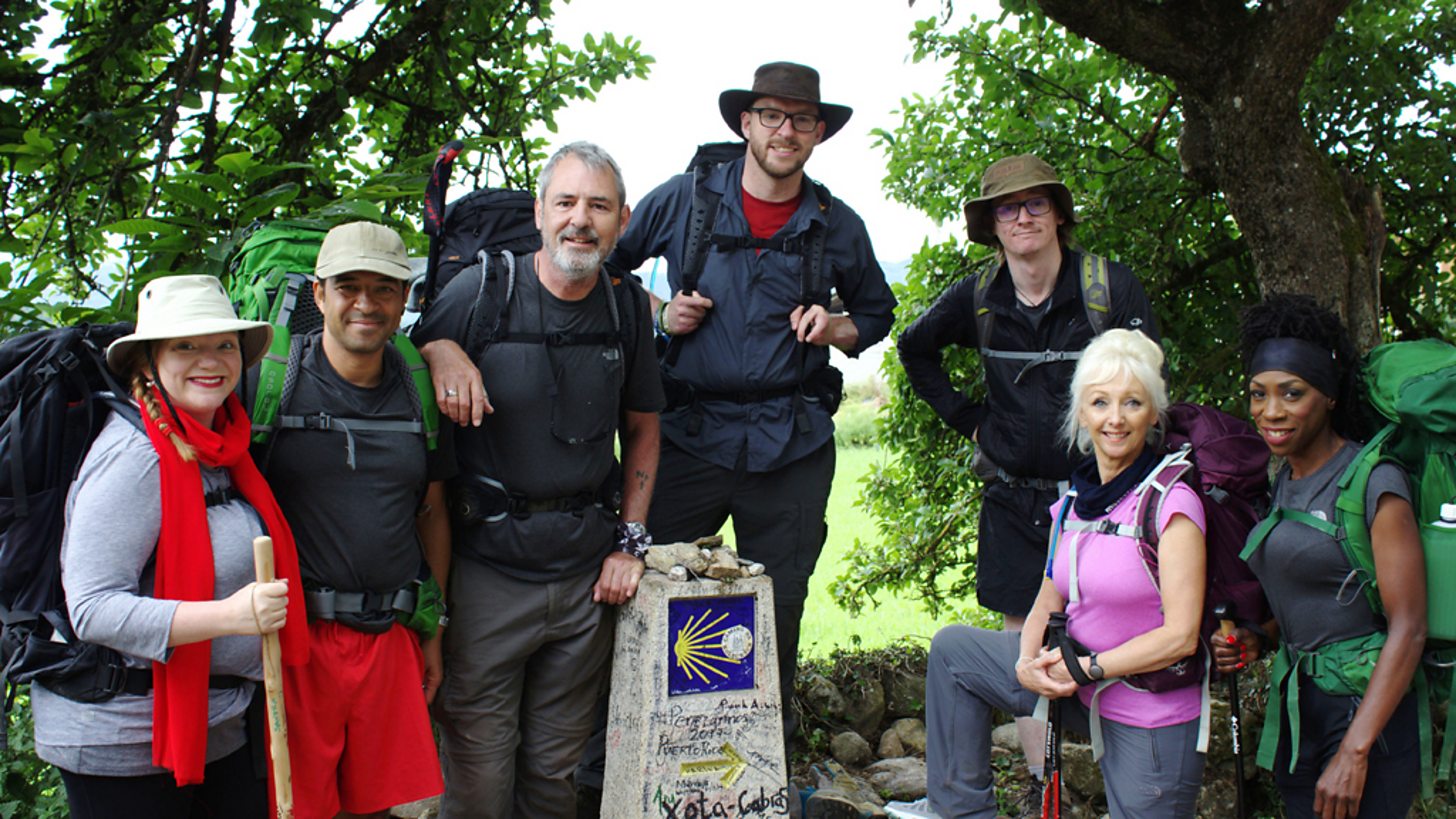 In a 2018 three-part travelogue series for BBC Two, seven famous faces were stripped of their everyday comforts to live as modern day pilgrims as they set out on the famous medieval pilgrimage, the Camino de Santiago. In a 2018 three-part travelogue series for BBC Two, seven famous faces were stripped of their everyday comforts to live as modern day pilgrims as they set out on the famous medieval pilgrimage, the Camino de Santiago.
L to R: Kate Bottley, Raphael Rowe, Neil Morrissey, JJ Chalmers, Ed Byrne, Debbie McGee and Heather Small [BBC]
With just over a fortnight to tackle this ancient path, actor Neil Morrissey, entertainer Debbie McGee, comedian Ed Byrne, singer Heather Small, priest Kate Bottley, journalist Raphael Rowe and TV presenter JJ Chalmers hiked through France and northern Spain to the Cathedral of Santiago de Compostela and the shrine of St James.
The group - made up of a variety of faiths and beliefs, including Christian, atheist and humanist - lived as simple pilgrims. But did this journey of a lifetime change the way they thought about themselves and their faith?
The pilgrimage sorted the seasoned walkers like Ed and JJ from the strollers, such as Neil, who soon realised he might not be prepared for the task ahead. As a former Catholic, and now atheist, Neil soon discovered that the arduous experience was not bringing him any closer to God.
Meanwhile, Kate’s faith took a knock as she struggled to keep up with the group, while Raphael refused to be swayed by anything religious - in prison he clung to hope, not God, after serving time for a crime he did not commit. For Debbie, she found solace in a fellow traveller after opening up about the loss of her husband, the late magician Paul Daniels.
As they moved along the route through vast mountain ranges and stunning landscapes in France and Spain, the group explores their differing religious beliefs, bond over the physical task and find humour when they realise what living like a simple pilgrim entails.
 The Film "El Camino" (The Way) The Film "El Camino" (The Way)
This was a fictional Hollywood film from 2010, which starred Martin Sheen and was directed by his son Emilio Estevez.
A father (Sheen) heads to Spain from the USA to recover the body of his estranged son, who died while walking the "Camino de Santiago", and decides to complete the pilgrimage in honour of his son.
I've not seen the film, but I will have a look sometime soon.
[Image courtesy of Amazon.es]
Me and the Camino
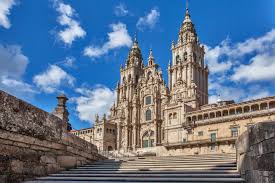 On my bucket list for 2025 is a visit to Galicia, the only one of Spain's 17 regions I've never visited. That will include a visit to Santiago de Compostela, the ultimate destination of all the pilgrimage routes along The Way of St James. On my bucket list for 2025 is a visit to Galicia, the only one of Spain's 17 regions I've never visited. That will include a visit to Santiago de Compostela, the ultimate destination of all the pilgrimage routes along The Way of St James.
Otherwise, as I indicated earlier my experience of The Camino will be vicarious, ie at a distance.
Photo of Santiago Cathedral [Turismo de Galicia]
© The Spanish Fly
Links:
BBC 2: 'Pilgraimage - The Road To Santiago'
The best movies and series based on the Way of St. James - I Love Compostela
Photos:
amazon.es, BBC, Facebook, IMDb, Paul Whitelock, Turismo de Galicia, Wikipedia
Thanks:
Paul Whitelock, Wikipedia
Tags:
All Saints Church Thelwall, amazon.es, Aragon, Asturias, "Atlas Ilustrado del CAMINO DE SANTIAGO", BBC, Camino, Camino de Santiago, cider, Debbie McGee, Ed Byrne, Emilio Estevez, European Union Socrates programme, EU study visit, Facebook, Fuenterrabia, George Orwell, Heather Small, Hotel Niza, IMDb, Jaca, JJ Chalmers, John and Joan Arthurs, Kate Bottley, La Concha, Laurie Lee, Martin Sheen, Neil Morrissey, Oviedo, Parador, Paula, Paul Daniels, Paul Whitelock, pilgrimage, Raphael Rowe, San Sebastian, Shirley MacLaine, "The Way", Turismo de Galicia, Washington Irving, Wikipedia, YouTube
 0
Like
Published at 6:08 PM Comments (2)
0
Like
Published at 6:08 PM Comments (2)
Day Trip to El Puerto de Santa Maria
Friday, June 27, 2025
At the last minute it fell to me to take our German friends Iris and Heidi to Jerez airport for their Condor flight back to Hamburg.
We left Ronda at 06.00 am with the aim of getting to this delightfully small airport by 08.00 am.
Jerez Airport [andalucia.com]
To Jerez Airport
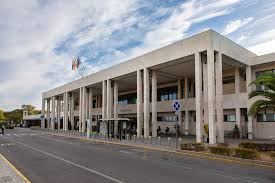 We only took 90 minutes, as there was very little traffic at that ungodly hour. I thought I might get sleepy at the wheel, so we had arranged that Iris would take over. As it turned out she kept me awake - we didn't stop talking for the entire journey. We only took 90 minutes, as there was very little traffic at that ungodly hour. I thought I might get sleepy at the wheel, so we had arranged that Iris would take over. As it turned out she kept me awake - we didn't stop talking for the entire journey.
At Jerez Airport, you can park right by the Terminal Building, so I went in and had a coffee with them while we queued and helped with their luggage.
My car park charge was a mere 1.85 euros.
Then I headed off to El Puerto de Santa Maria, to spend a day in this delightful area. I'd been there once before in 2024 and liked it a lot.
El Puerto de Santa Maria
It was still early when I got there, just before 09.00 am. First I went to ALDI to buy some provisions before setting off to find somewhere to park.
I found a spot near the canal, but it was early and nothing was open.
So, I headed into the Old Part to look for somewhere to leave the car. I put it in an underground car park and then went for breakfast - I was starving!
I found an agreeable looking cafe with a table on the shady terrace and ordered a breakfast to die for.
Strolling around I took a series of photos to compile a photo essay on the town.
Then I stumbled on a Solidarios charity shop where I got two pictures, a belt and a cuddly toy for a mere 10 euros.
Later, after I had retrieved my car, I headed off to La Puntilla beach for a siesta.
La Puntilla
La Puntilla beach is divided into six zones. There are no chiringuitos on the beach and no hamacas to rent. It's all very natural.
I chose Zone 1, which was not busy and had a wide beach backed by palm trees. I was able to indulge my passion of nude sunbathing. I don't think I was the only one!
It was rather cloudy, which was a good thing. I drank a beer, ate some snacks and had a snooze.
Then, I went to the quiosko for a beer and had a great chat with the owner, Paco.
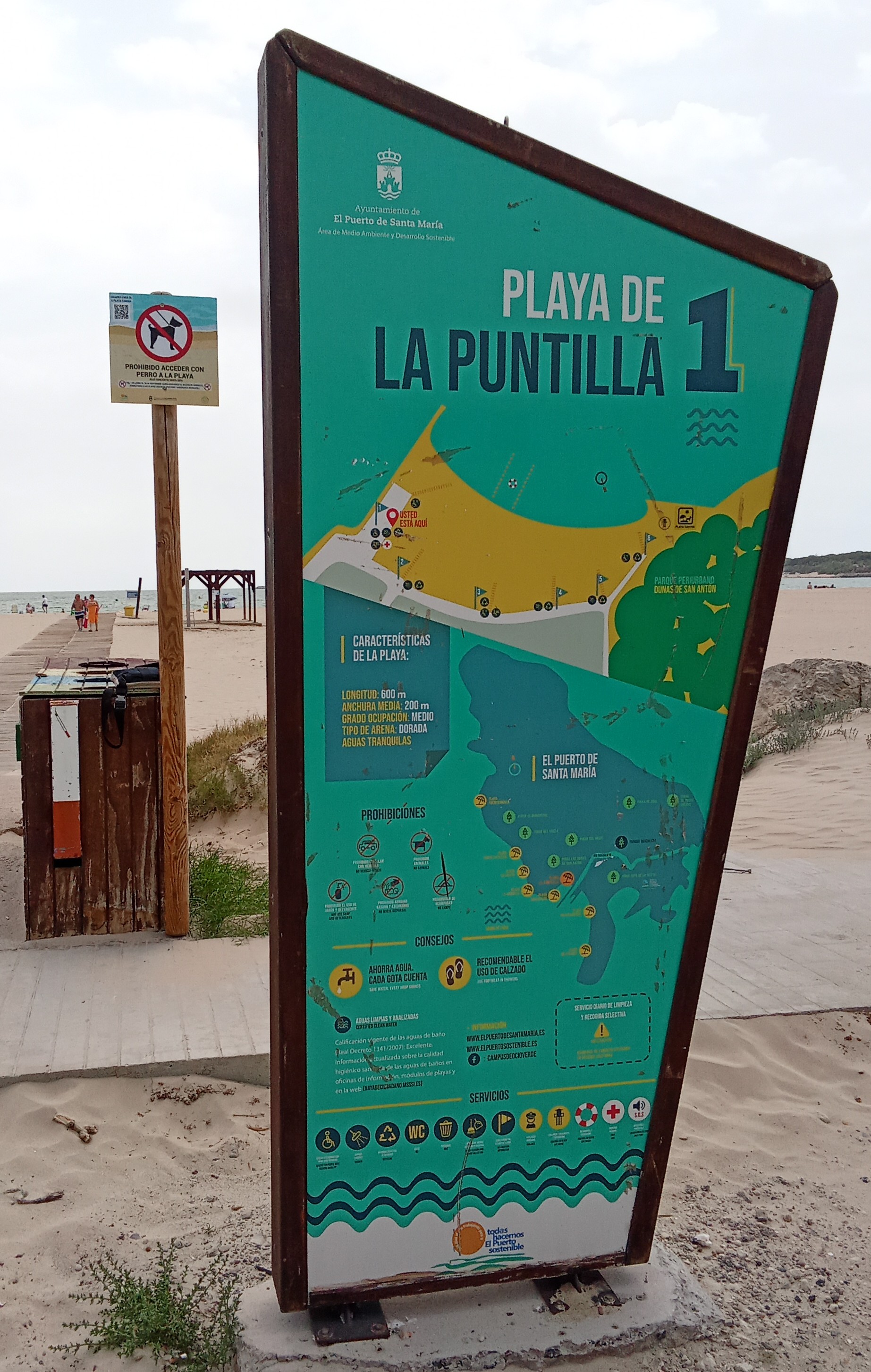 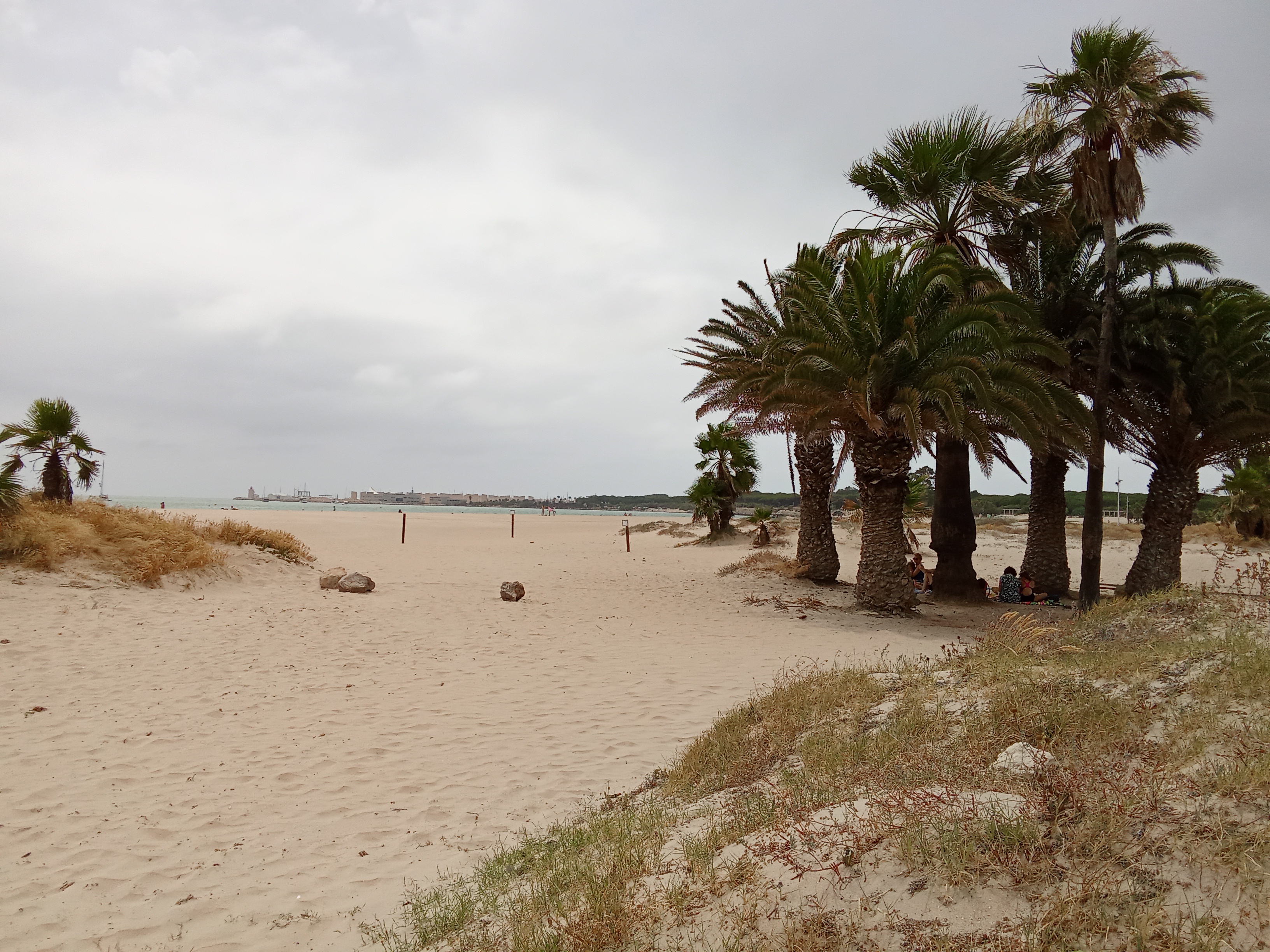 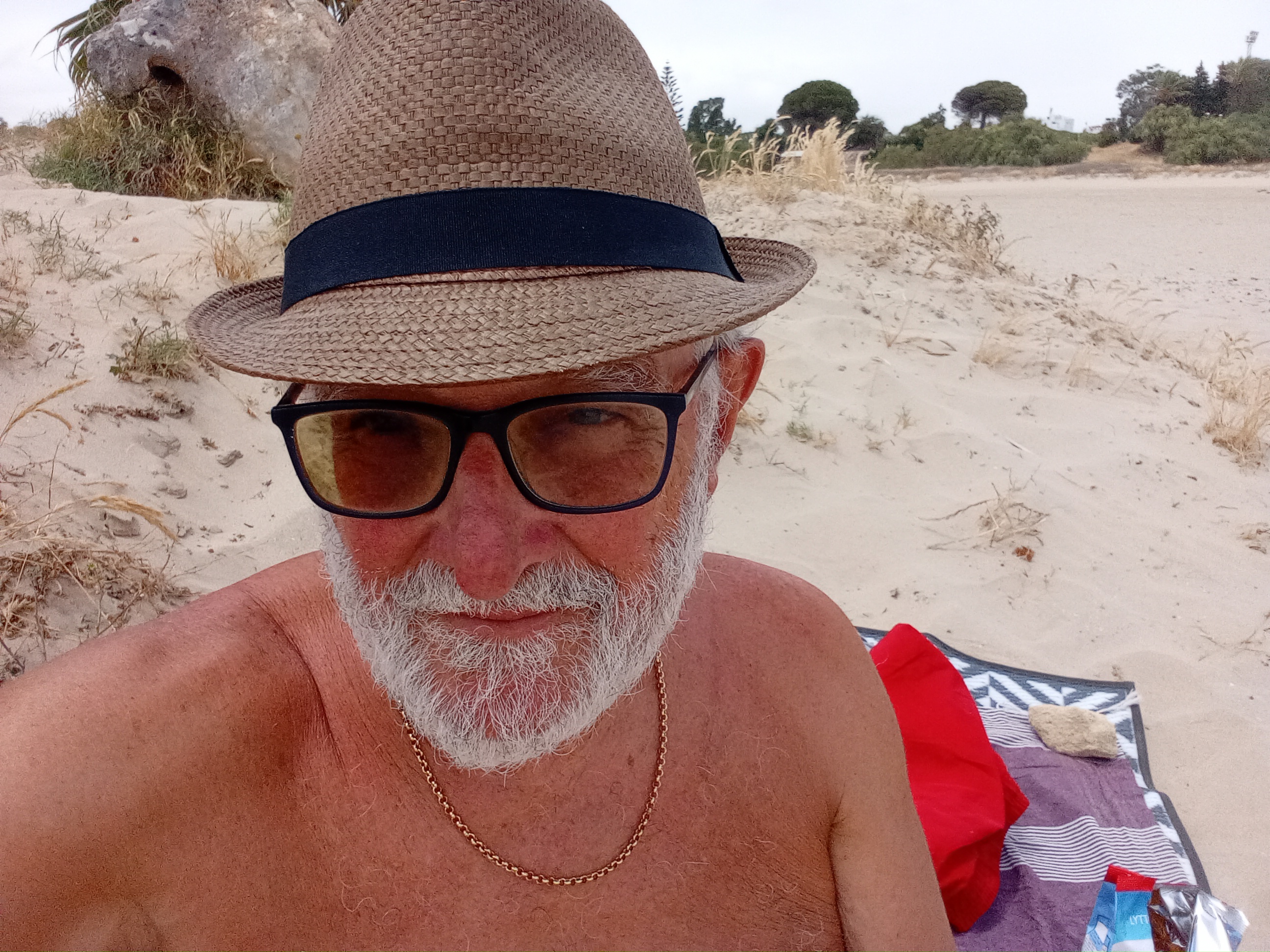
[Photos by Paul Whitelock]
Home time
I left the beach around 18.00 pm and headed off home to Ronda via Median Sidonia and Arcos de la Frontera.
What a great day!
© The Spanish Fly
Links:
With thanks to:
Paul Whitelock, The Spanish Fly
Tags:
Arcos de la Frontera, El Puerto de Santa Maria, Paul Whitelock, The Spanish Fly
 0
Like
Published at 11:24 PM Comments (0)
0
Like
Published at 11:24 PM Comments (0)
Journey to the East
Tuesday, June 24, 2025
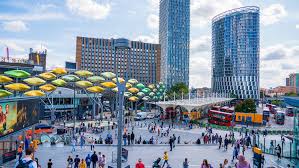 The other weekend I went on a journey into the unknown - to the East. To East London, to Stratford. To visit my daughter in her new home there. I still hadn't seen it since she moved last year. The other weekend I went on a journey into the unknown - to the East. To East London, to Stratford. To visit my daughter in her new home there. I still hadn't seen it since she moved last year.
Stratford, East London [Photo courtesy of Time Out]
She was away on school camp with her youngest, (Hey!) Jude, my grandson.
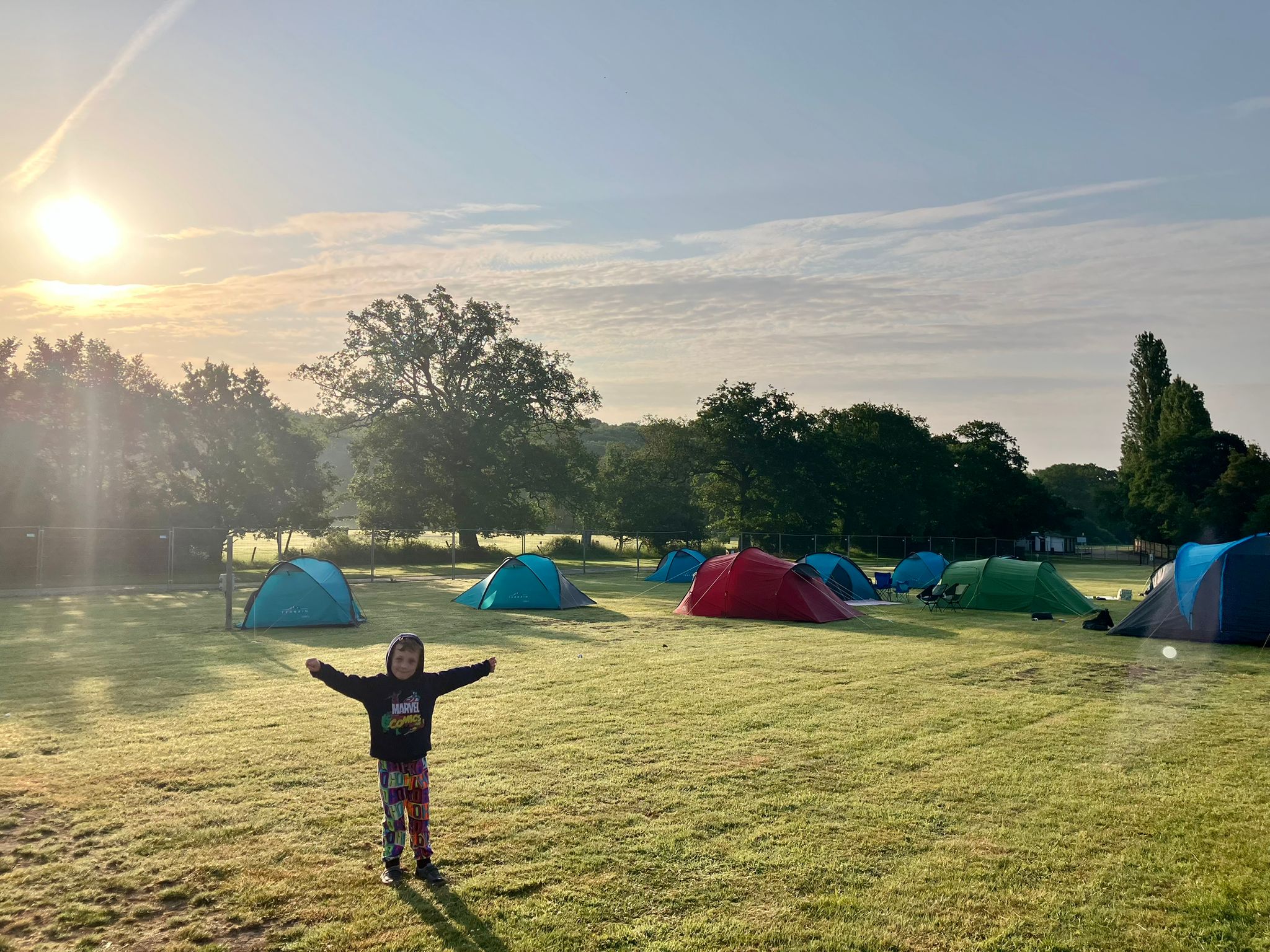  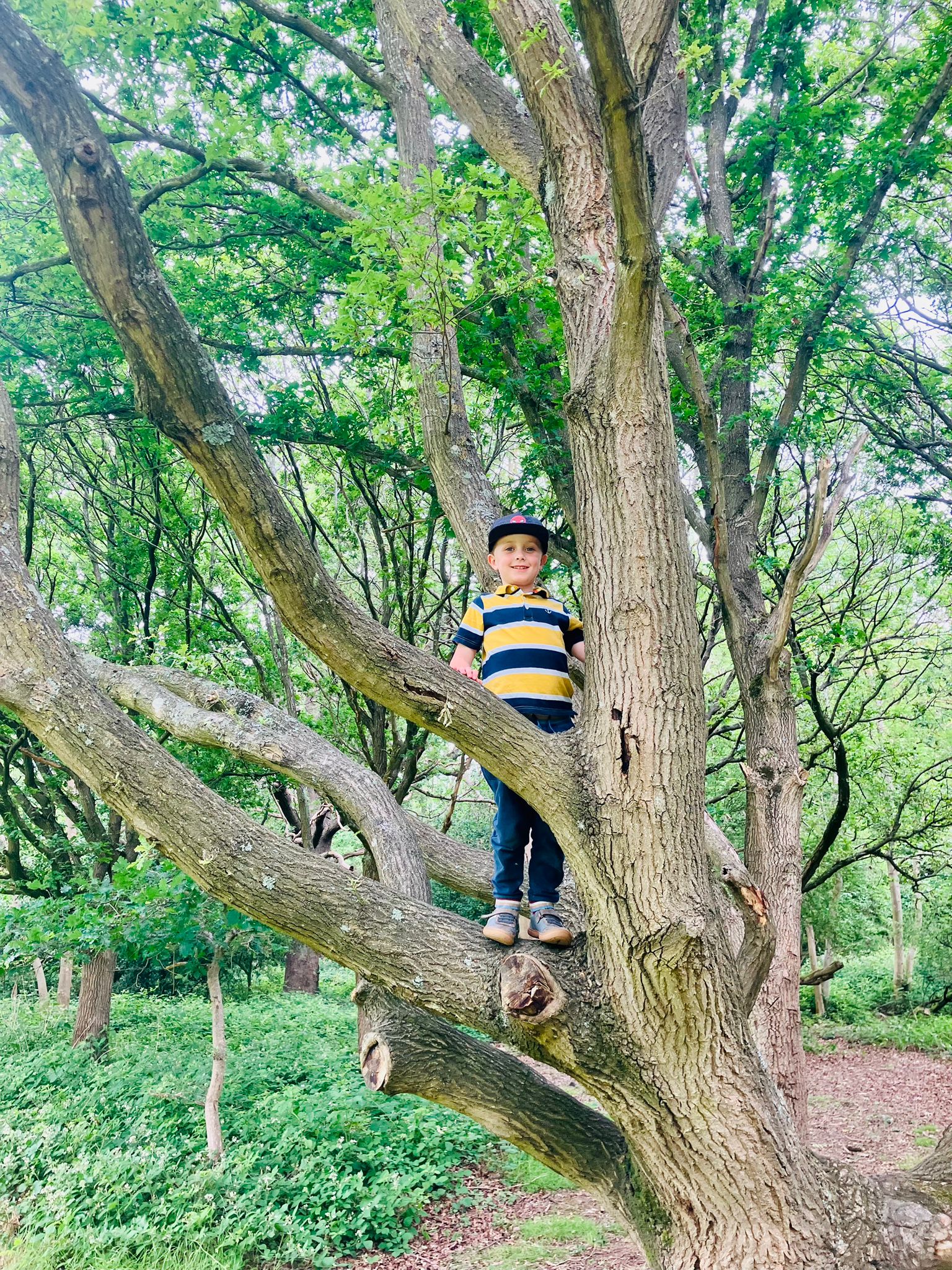
(Hey!) Jude at camp [Photos: Amy Gibbs]
Arrival in the unknown
So, I had to find her flat and get in, as it turned out, without the aid of Google Maps, since my mobile had no signal and then it ran out of charge.
 My UK bank card was constantly declined so I popped into a local branch of said bank, Santander UK, the biggest bank in Britain, by the way, to try and resolve the problem. My UK bank card was constantly declined so I popped into a local branch of said bank, Santander UK, the biggest bank in Britain, by the way, to try and resolve the problem.
"Sorry, sir, your card has been blocked, We'll have to issue a new one."
I explained my situation, ie that I don't live in the UK and I was only in the UK for a short family visit.
The nice lady said they would send a new card to my home address in Spain.
"That will take ages and won't solve my current problem. Can't I pick one up here, say tomorrow, Saturday morning or Monday?"
"Sorry, sir, it isn't that fast."
[Santander Bank UK logo]
 I was beginning to hate my bank with a passion ..... until the nice lady said I could get cash from her if I could ID myself. I was beginning to hate my bank with a passion ..... until the nice lady said I could get cash from her if I could ID myself.
I handed her my passport and Spanish residence permit and she gave me 500 pounds in cash.
500 pounds [Image courtesy of FinSMEs]
First things first
I was starving. I had eaten a very small and very early breakfast on the plane, but now needed something further.
Nowhere was open, until I discovered a Bulgarian cafe which was doing a roaring trade in breakfasts and also had a range of beers from that former eastern bloc country.
So I ordered a fry-up, which I washed down with two different beers from Bulgaria.
 .jpg)
My Bulgarian breakfast [Photos: PW]
When it came to paying I had a choice of cash or my Spanish credit card.
No such luck when I boarded a bus. I had no Oyster Card and, I thought, no functioning UK bank card.
"Sorry, sir, we don't take cash!" the polite West Indian bus driver informed me. So I tried tapping my cancelled bank card. It worked! Or so the driver said. I think he had taken pity on me.
Finding the flat
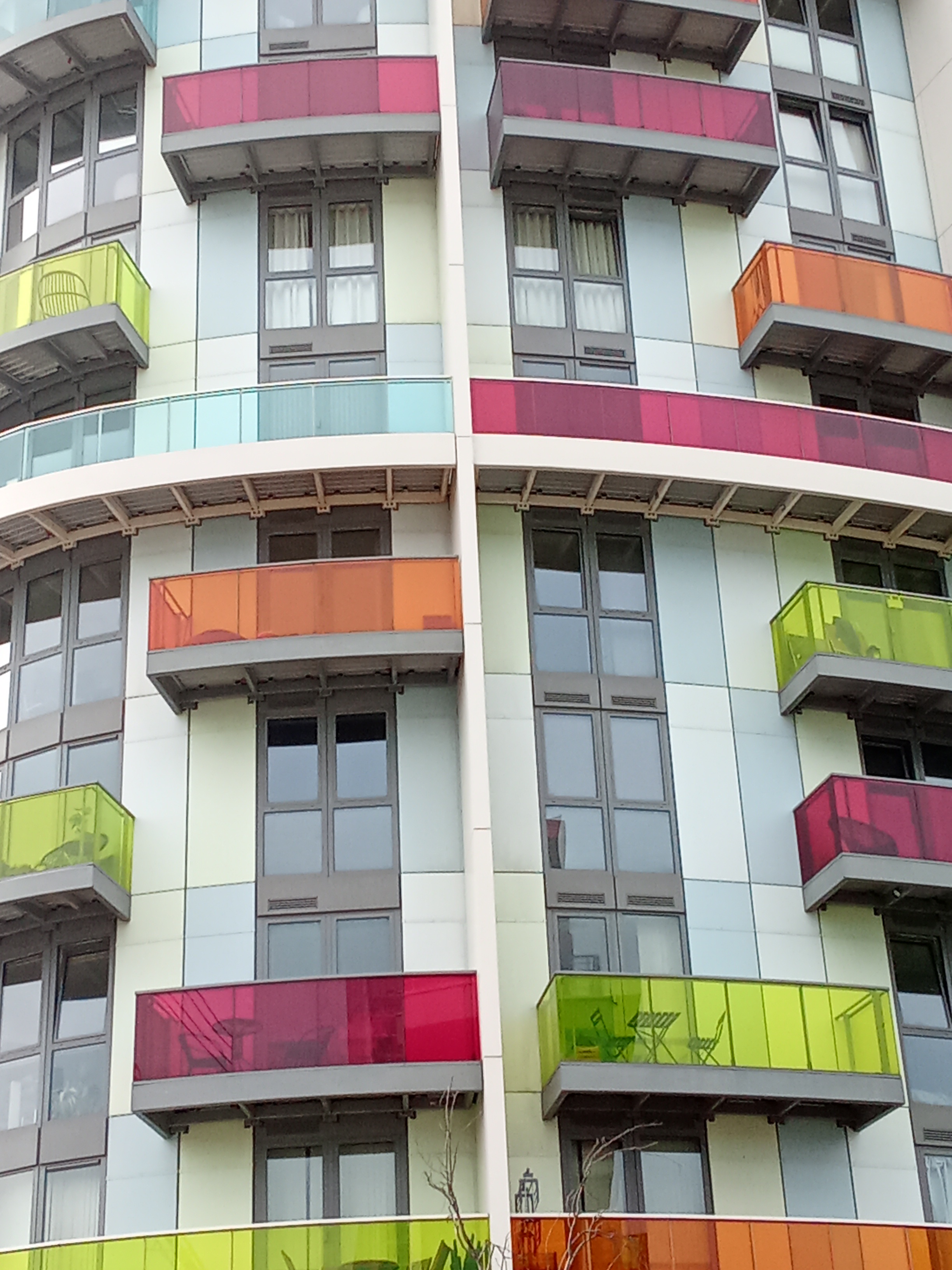
Having acquired some cash, all I had to do was find Amy's flat without a mobile to lead me there.
Well, I managed it in the end, but it had taken a while.
I settled in, then went for a walk to The Westfield Centre, where I bought some little gifts for the grandkids and Amy and Tom. I could pay with my Spanish credit card.
I had left my 500 quid at the flat, but I had enough small change for a half pint of Beavertown at The Crown and Anchor, before heading back to Icona Point.
Icona Point [Photo courtesy of PW]
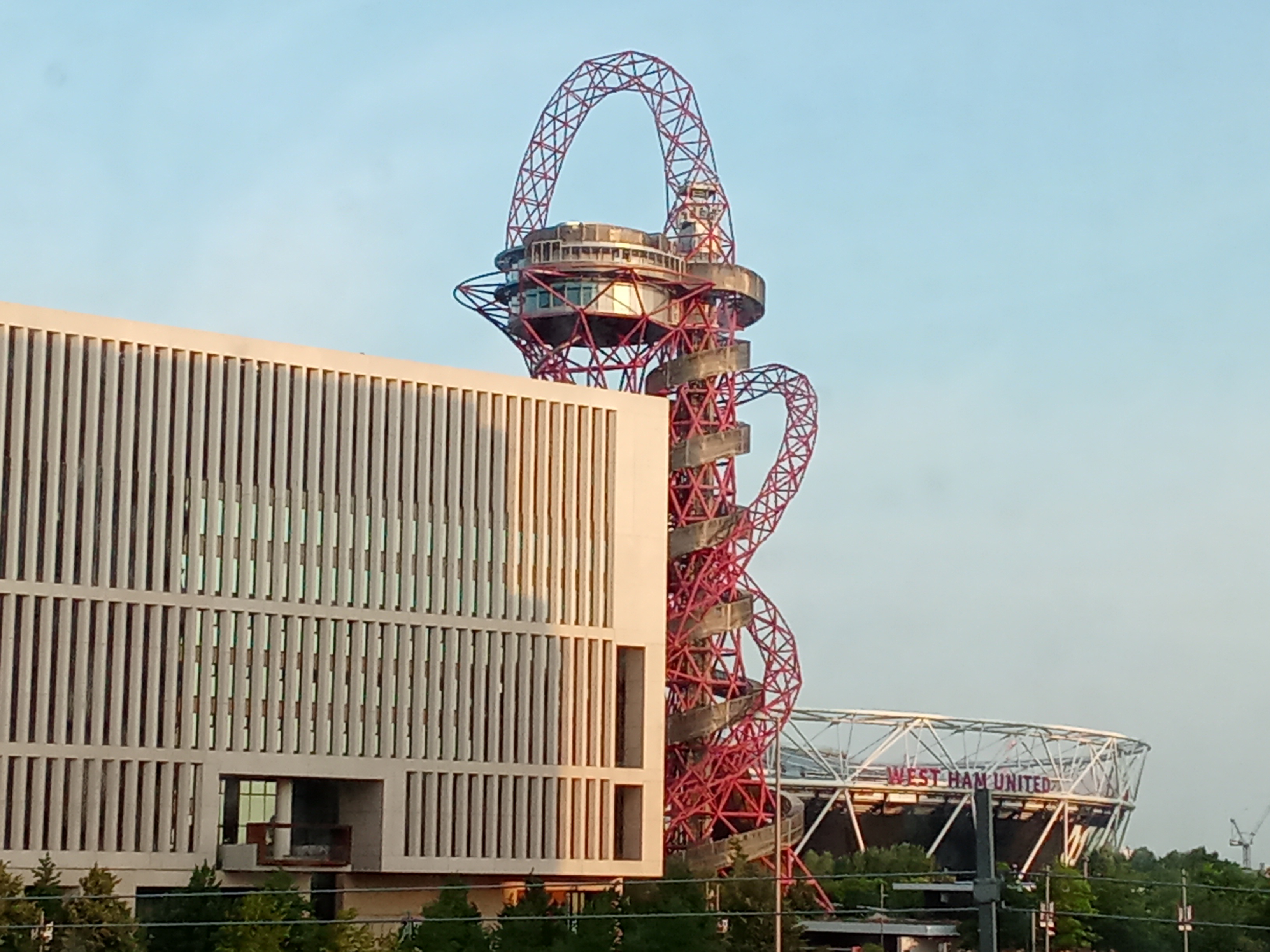 Amy's flat is in an excellent location with views of The Olympic Village from its two balconies. West Ham United FC has taken over the former Olympic Athletics Stadium and the highest tunnel helter-skelter in the world looms large. Amy's flat is in an excellent location with views of The Olympic Village from its two balconies. West Ham United FC has taken over the former Olympic Athletics Stadium and the highest tunnel helter-skelter in the world looms large.
Between The Olympic Village and Amy's flat lies Stratford International Railway Station, a noisy junction for trains to the continent, Southern Rail, the DLR, and the London Underground.
But you soon get used to the constant noise. Let's face it, big cities are noisy places.
The Olympic Village [Photo: PW]
The East London Beer Scene
The East End is a veritable real ale drinker's paradise, with a range of cask ales from various brewers, as well as a few brew-pubs.
I knew Tap East; King Edward VII; Ye Olde Black Bull; The Bow Bells and a few others from previous visits.
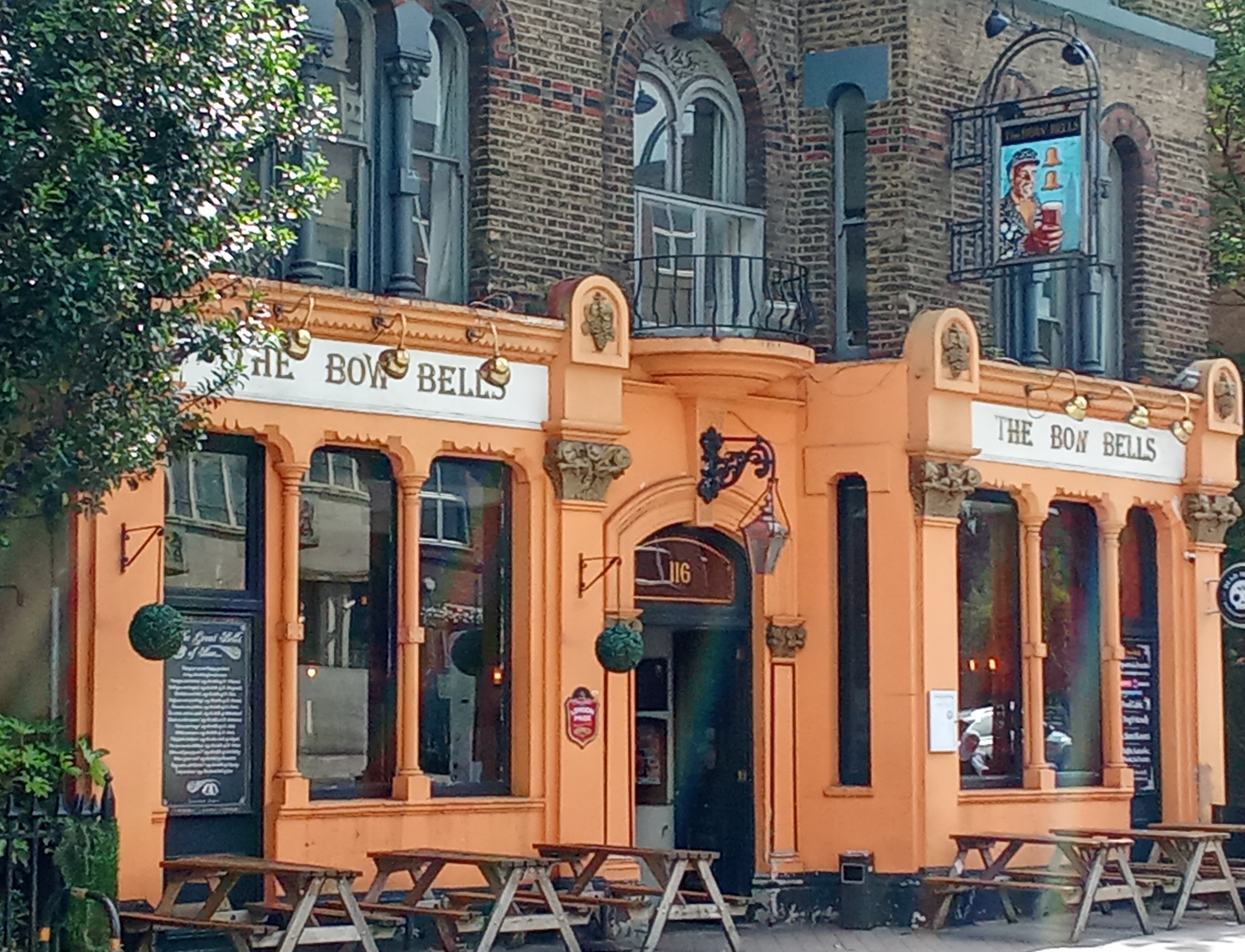 
The Bow Bells, Bow
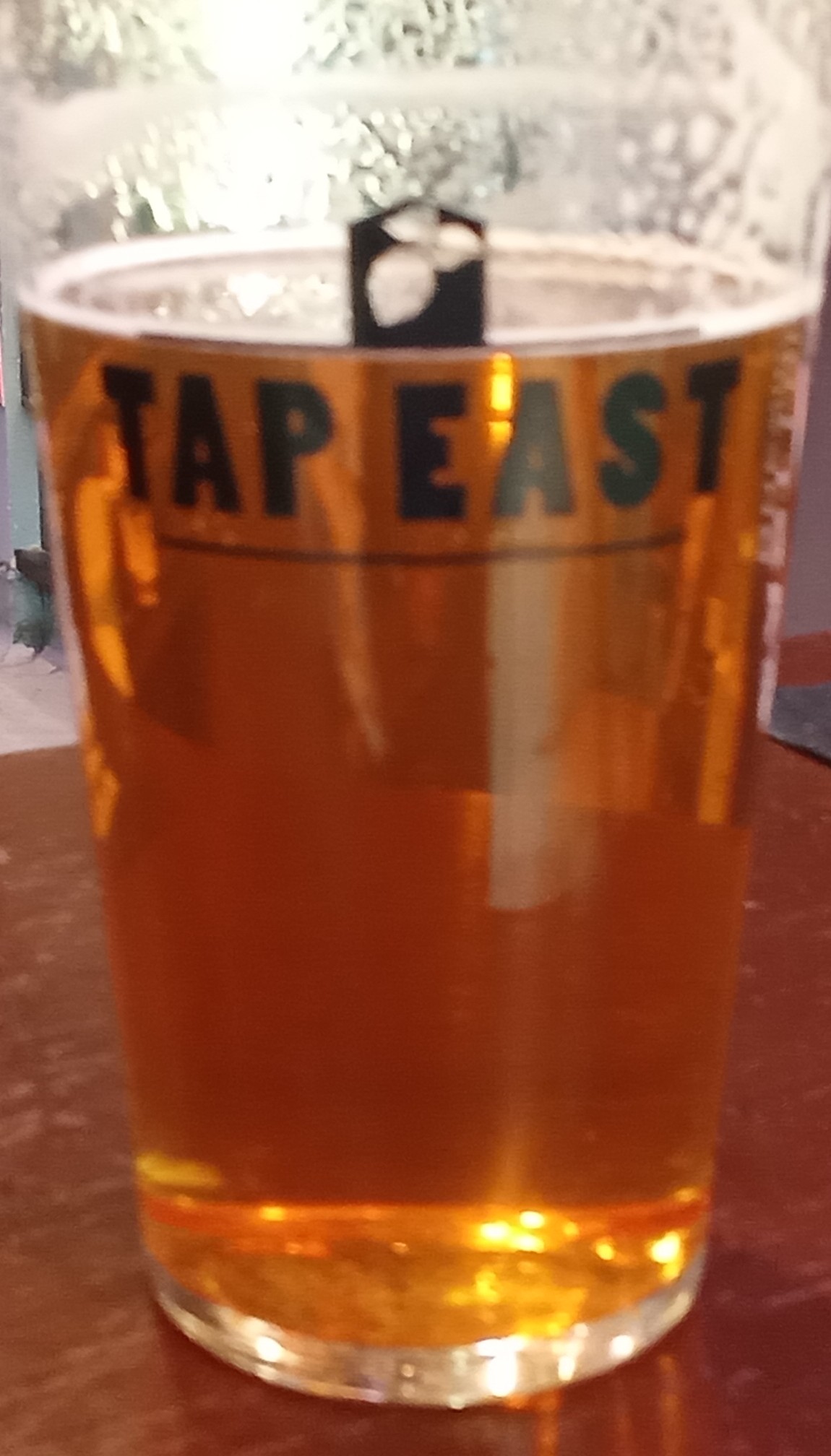 
Tap East Brew Pub, Stratford Centre
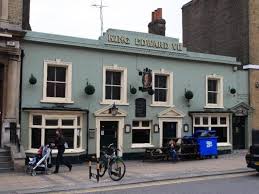 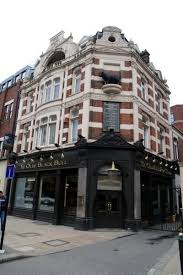
King Edward VII, Stratford [CAMRA] Ye Olde Black Bull, Stratford [CAMRA]
All the above photos by Paul Whitelock, unless otherwise stated.
Thursday night in Stratford
In the evening I went for a stroll in the Olympic Village area looking for something to eat. Can you believe it? Everywhere was shut or in the process of closing. So I had to dine on good beer!
Then I found somewhere open, another pub with its own brewery, the quirkily named Jim &Tonic.
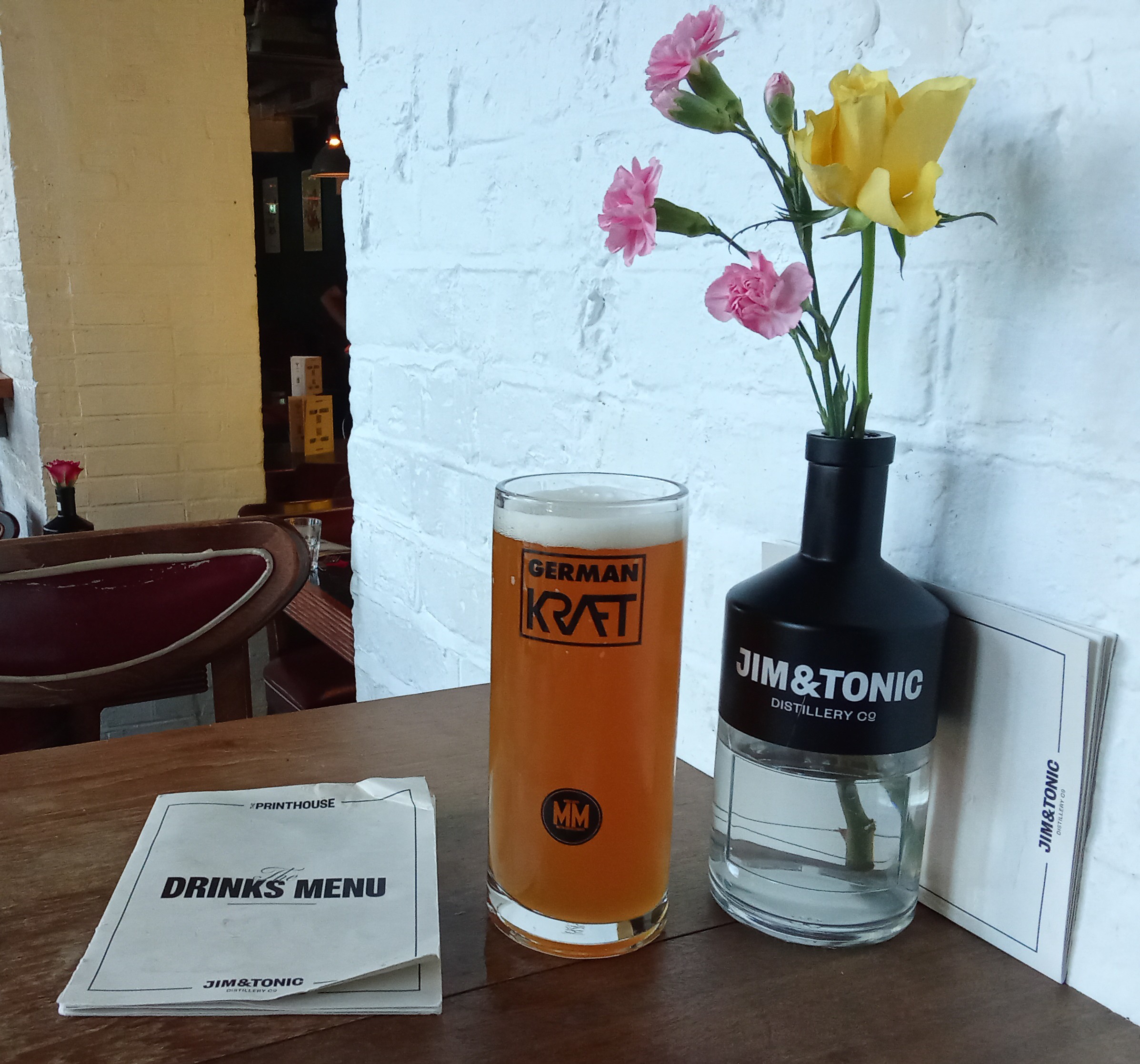 
Jim & Tonic, Stratford [Photos by Paul Whitelock]
Friday Fun
Amy got back from camp late morning, so after she had freshened up went for lunch at Riverside East.
We sat outside and had a nice time, "great bantz", tasty food and quality beers from the US and Italy.
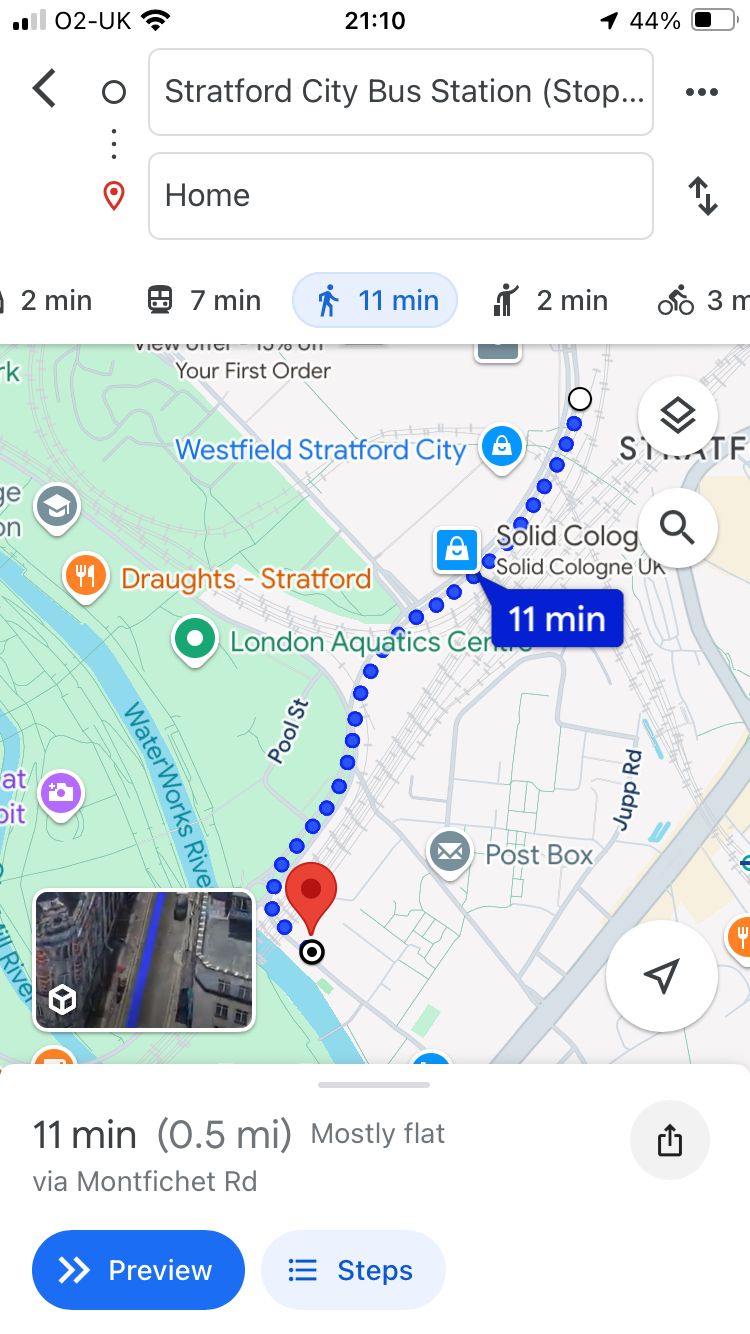 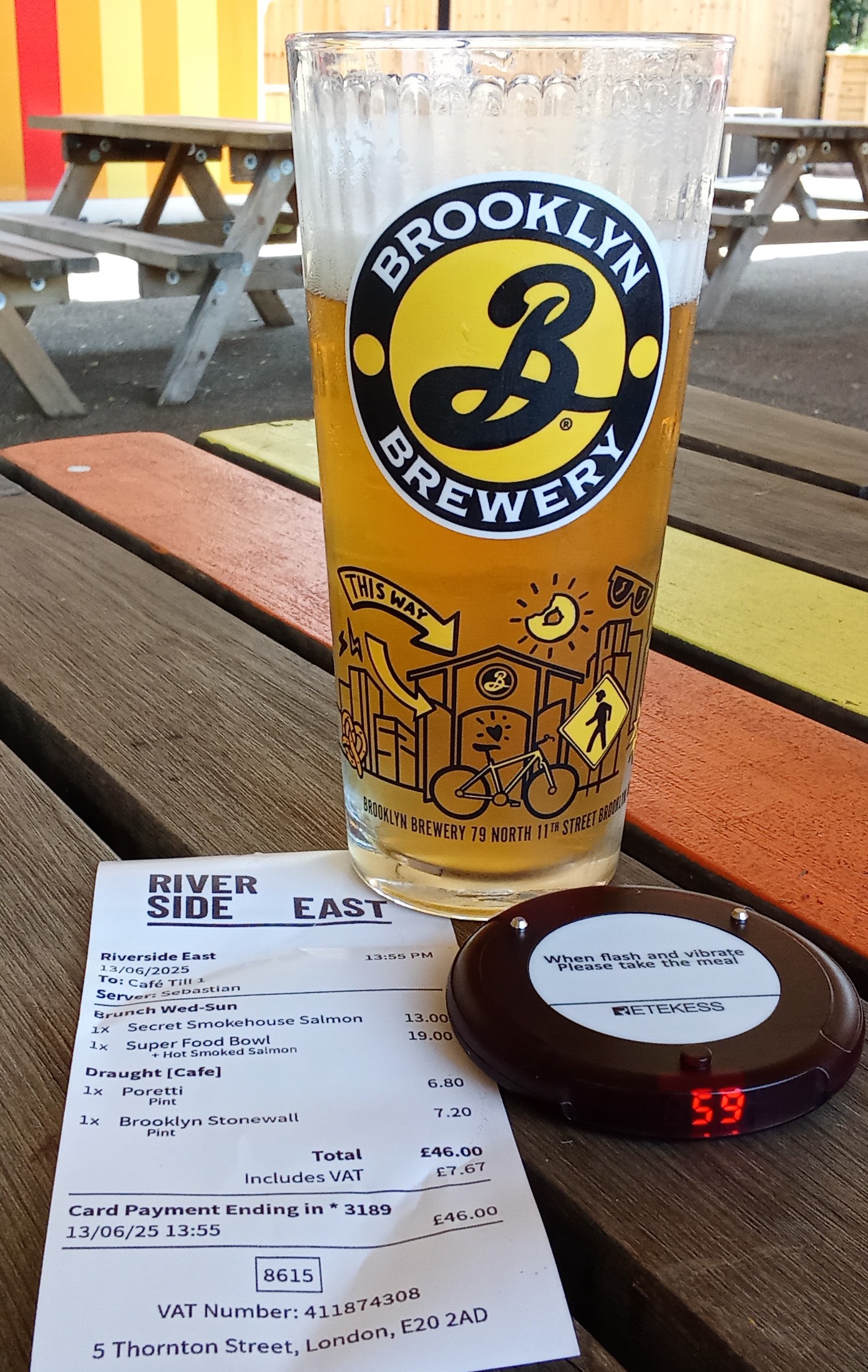
Map: GoogleMaps Photo: Paul Whitelock
Then it was time to go and pick up the boys from school.
School 360, very soviet-sounding, but a great school with an amazing OfSTED judgement - well deserved, in my opinion.
I had been an OfSTED inspector during my career and was very impressed with what I saw on a prior visit to the school a few years ago, when Felix first started there.
 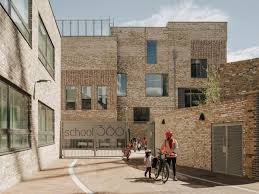 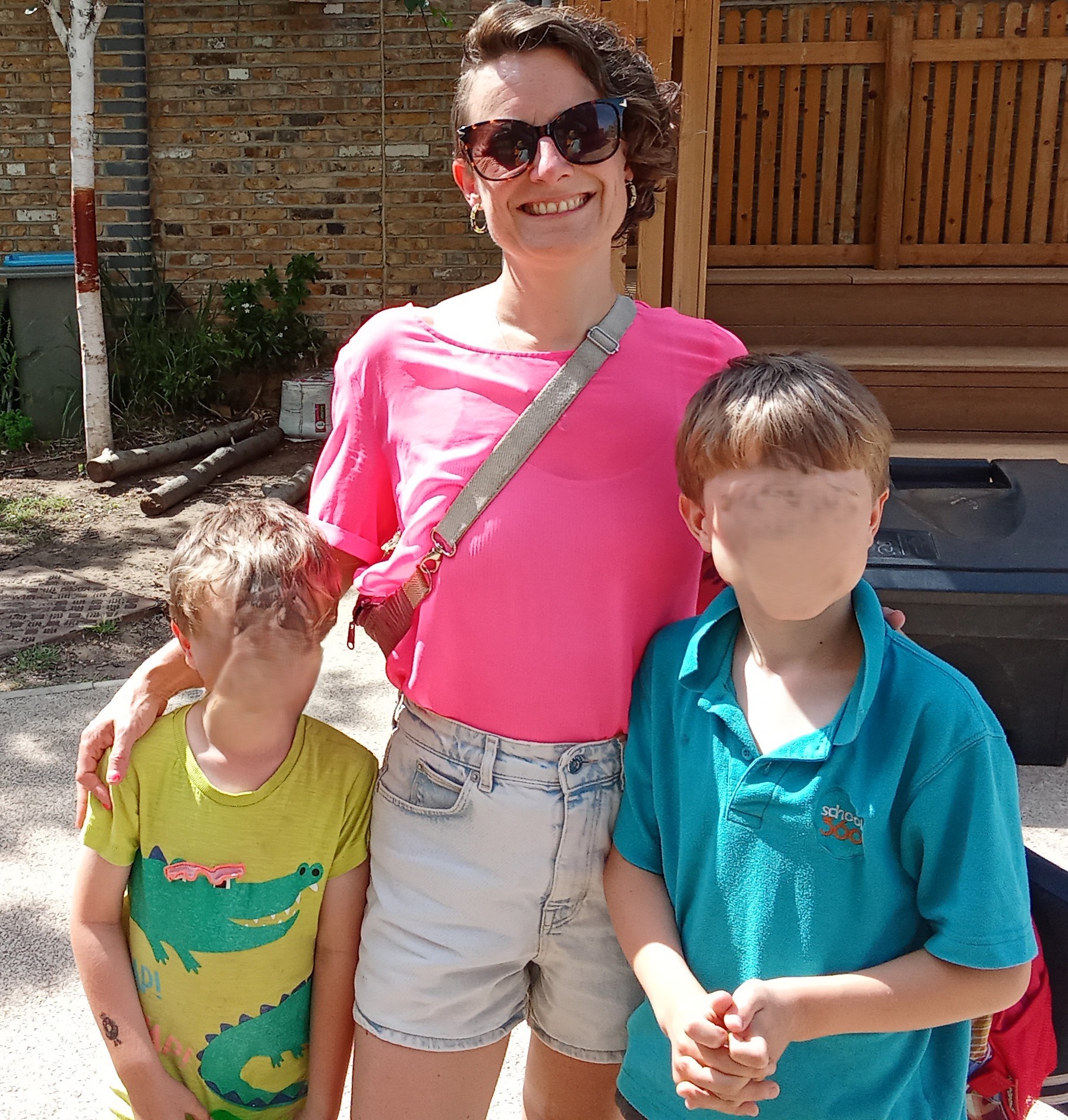
[logo courtesy of school360.org.uk] [Photo courtesy of e-architect] Jude, Amy and Felix [Photo: PW]
After school we went to the nearby shop for ice creams and drinks, then headed home via the park.
 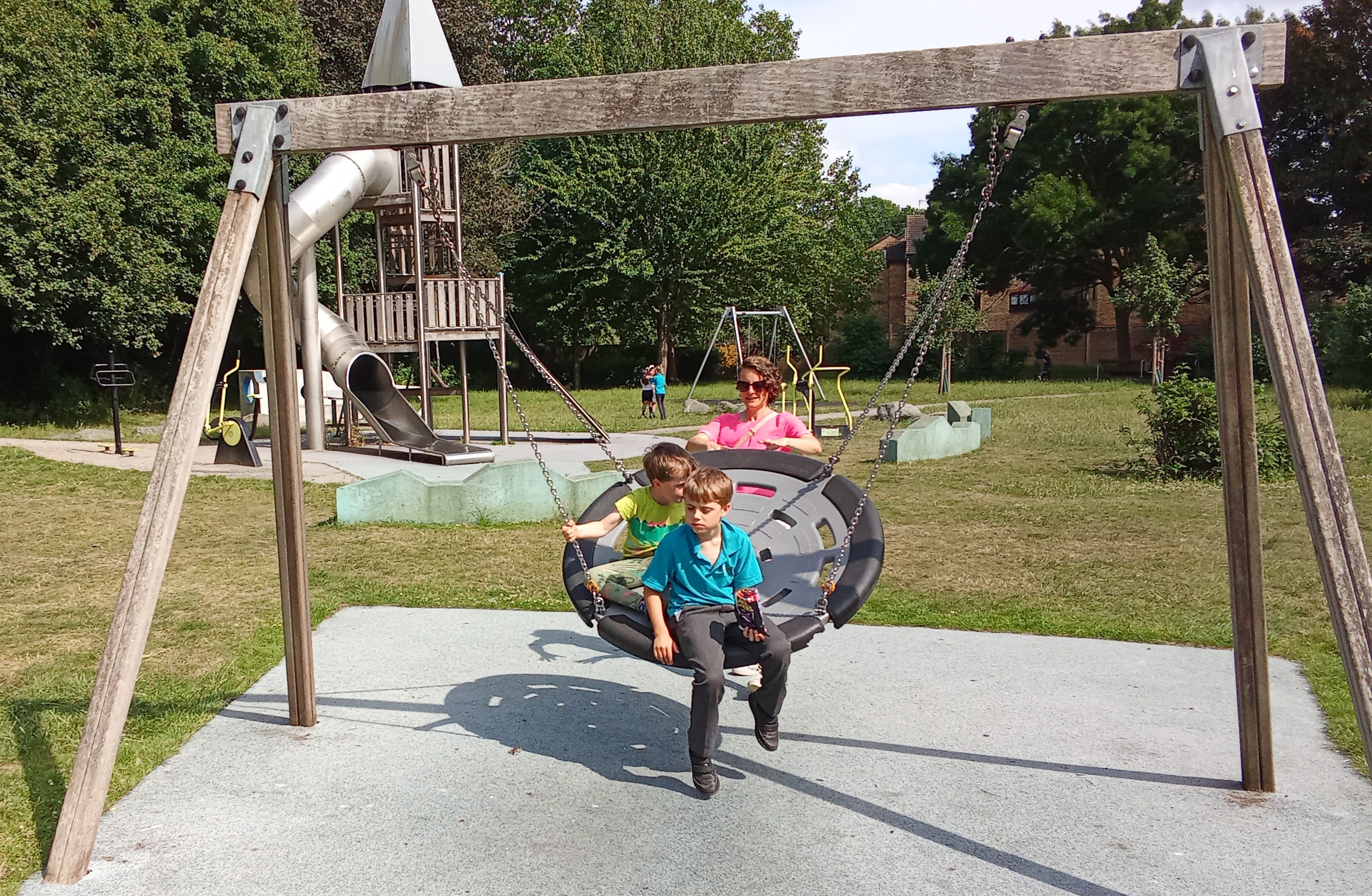 
[All three photos by Paul Whitelock]
Saturday down south
I had offered to replace Amy's en-suite shower, which was yucky and loosely fitted, so I went out early to a nearby branch of Travis Perkins to buy what I needed.
 When I returned I got Felix to be my plumber's mate. This entailed him passing me things, while I explained what we were doing. When I returned I got Felix to be my plumber's mate. This entailed him passing me things, while I explained what we were doing.
I think he could turn out like me, his grandad, and like my son Tom, his dad. We are both competent DIY-ers/amateur builders who learned from our dads.
[Cartoon courtesy of Facebook]
After br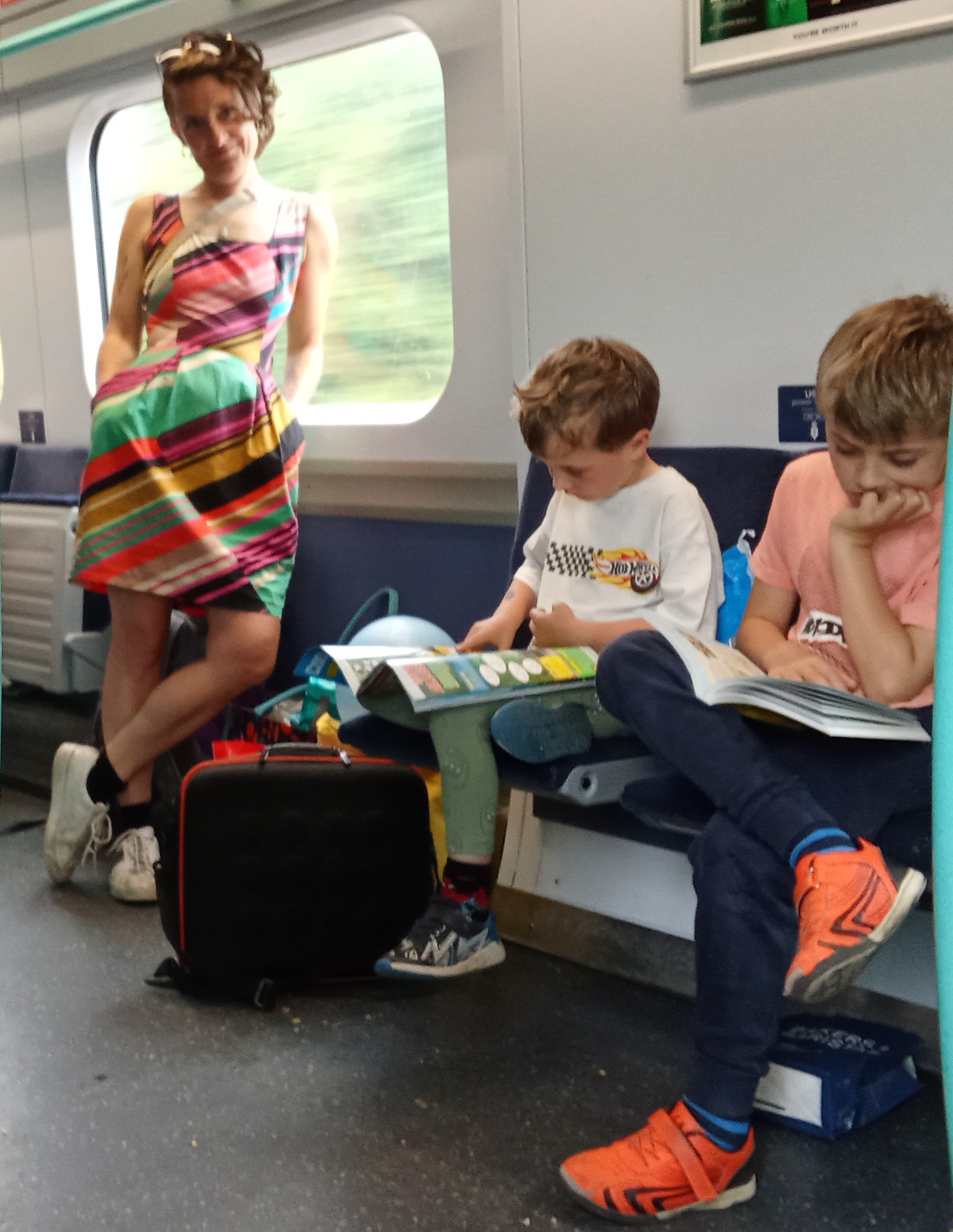 eakfast we got ready for our trip to Hastings on the train, where we were going to stay with Tom and Su to celebrate Buckley's birthday at a BBQ/garden party with extended family ..... eakfast we got ready for our trip to Hastings on the train, where we were going to stay with Tom and Su to celebrate Buckley's birthday at a BBQ/garden party with extended family .....
..... and Father's Day on Sunday.
'Standing room only' [PW]
You can read about that experience, the second part of my journey, here:
Long weekend in the UK - Eye on Spain
Other links:
Hey Jude (Remastered 2015) - YouTube
The Building History of a 72-year-old DIY Fan - Eye on Spain
The “Crazy Guy” gets his house finished just in time - Secret Serrania de Ronda
© The Spanish Fly
With thanks to:
Eye on Spain, The Beatles, The Spanish Fly, www.help-me-ronda.com, YouTube
Pictures:
Amy Gibbs, e-architect, Facebook, Santander Bank, Susannah Austin, Time Out, Tom Whitelock, Tony Gomersal, Paul Whitelock, school360.org.uk,
Tags:
amateur builder, Amy Gibbs, BBQ, Bow, Bow Bells, Buckley's birthday, DIY-er, East London, Edward VII, en-suite shower, Felix, garden party, Hastings, "Hey, Jude!", Jeryl Burgess, Jim & Tonic, journey to the east, Jude, Paul Whitelock, Riverside East, school 360, school camp, Stratford, Stratford Centre, Stratford International, Susannah Austin, Tap East, The Spanish Fly, Tom Whitelock, Tony Gomersal, Travis Perkins, Ye Olde Bull's Head
 0
Like
Published at 8:21 PM Comments (0)
0
Like
Published at 8:21 PM Comments (0)
Spam post or Abuse? Please let us know
|
|